Samsung Electronics Co PRSE0609 RFID Multifunction Printer User Manual SCX6345N EN
Samsung Electronics Co Ltd RFID Multifunction Printer SCX6345N EN
Contents
- 1. Users Manual 1
- 2. Users Manual 2
Users Manual 2
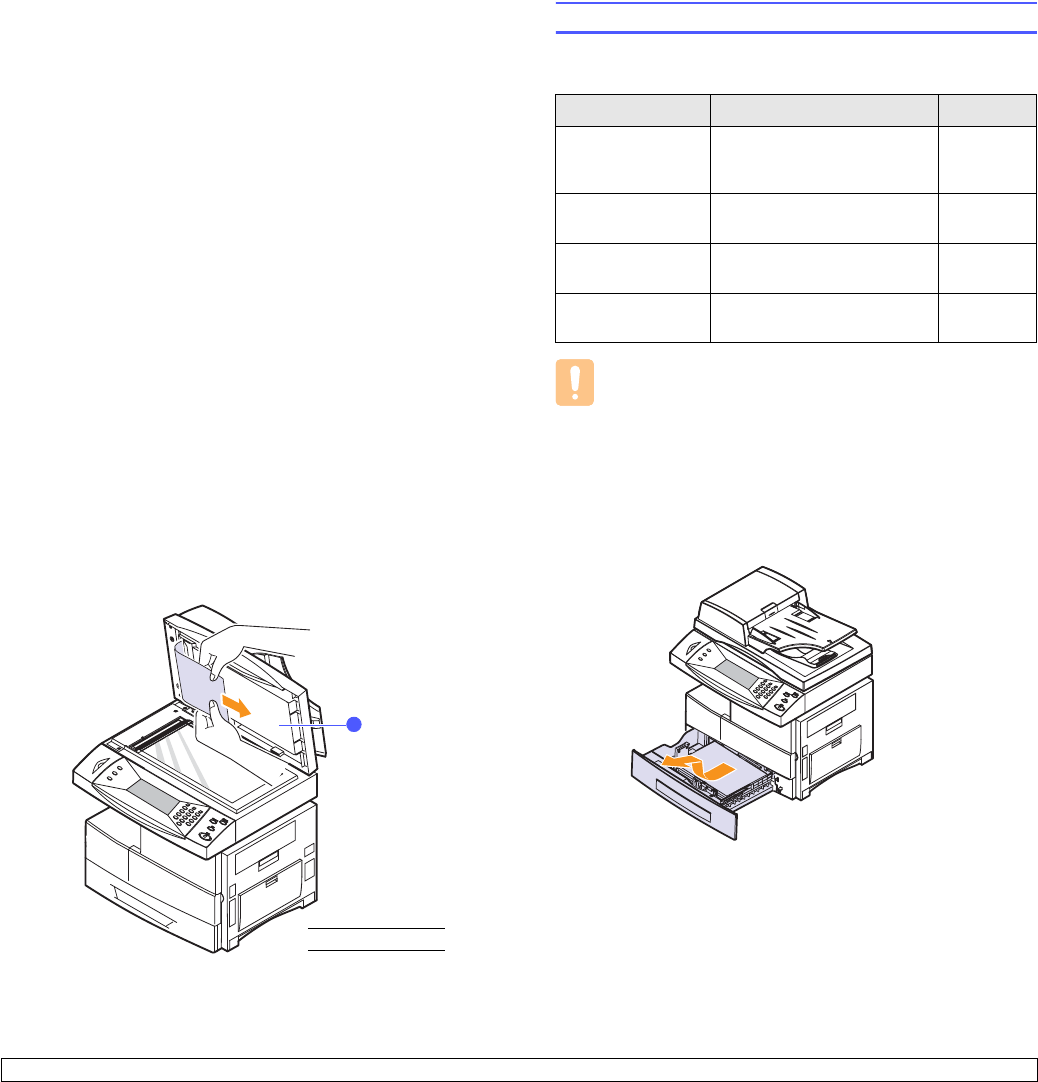
10.2 <
Troubleshooting>
Exit Misfeed
1Remove the remaining documents from the DADF.
2Open the document input tray upward and pull the document gently
out of the DADF.
3Close the document input tray. Then place the documents back into
the DADF.
Roller misfeed
1Open the scanner lid.
2Seize the misfed paper, and remove the paper from the feed area by
carefully pulling it to the right using both hands.
3Close the scanner lid. Then load the removed pages back into the
DADF.
1scanner lid
1
Clearing paper jams
When a paper jam occurs, Paper Jam appears on the display. Refer to
the table below to locate and clear the paper jam.
Caution
To avoid tearing the paper, pull out the jammed paper gently
and slowly. Follow the instructions in the following sections to
clear the jam.
In the tray 1
1Pull out the paper Tray to open. After you pull it out completely, lift
the front part of the Tray slightly up to release the Tray from the
machine.
Message Location of jam Go to
[Paper Jam 0]
Open/Close Door
In the paper feed area (tray 1,
optional tray 2, or multi-
purpose tray)
below and
page 10.3,
10.4
[Paper Jam 1]
Open/Close Door
In the fuser area or around the
toner cartridge
page 10.5
[Paper Jam 2]
Check Inside
In the paper exit area page 10.5
Duplex Jam
Open/Close Door
In the duplex unit page 10.7
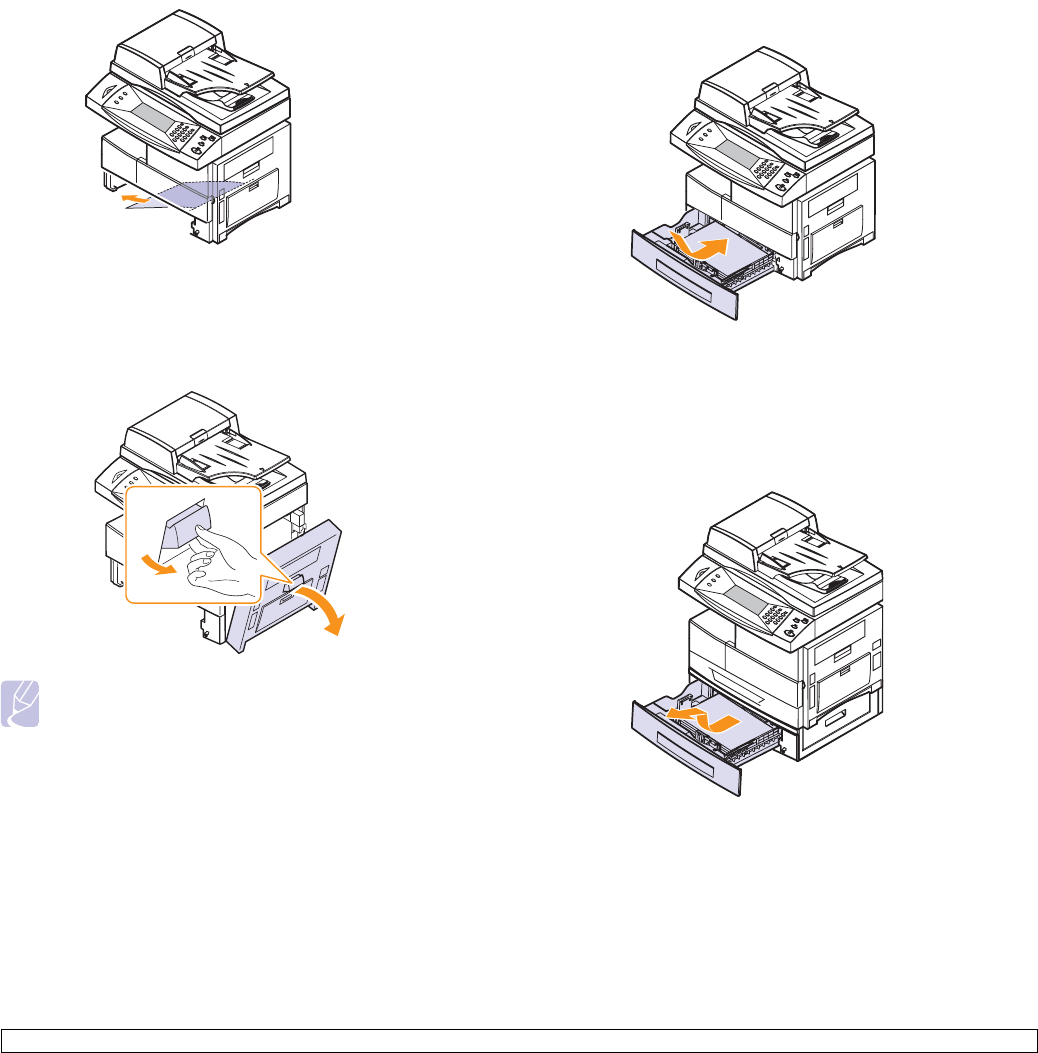
10.3 <
Troubleshooting>
2Remove the jammed paper by gently pulling it straight out.
Once you remove the jammed paper here, open the side cover and
then close it to clear the “Paper Jam0” message on the display.
If there is any resistance, and the paper does not move immediately when
you pull, stop pulling. Then:
3Open the side cover.
Note
Do not touch the shiny drum cartridge surface. Scratches or
smudges will result in poor copy quality.
4Carefully remove the misfed paper in the direction shown.
5Close the cover and insert the paper Tray. Lower the rear part of the
Tray to align the rear edge with the corresponding slot of the
machine, then insert it completely.
In the optional tray 2
1Pull the optional tray 2 open.
2Pull the paper Tray to open. After you pull it out completely, lift the
front part of the Tray slightly up to release the Tray from the
machine.
If the paper does not move when you pull, or if you do not see the
paper in this area, stop and go to step 3.
3Pull the tray 1 half.
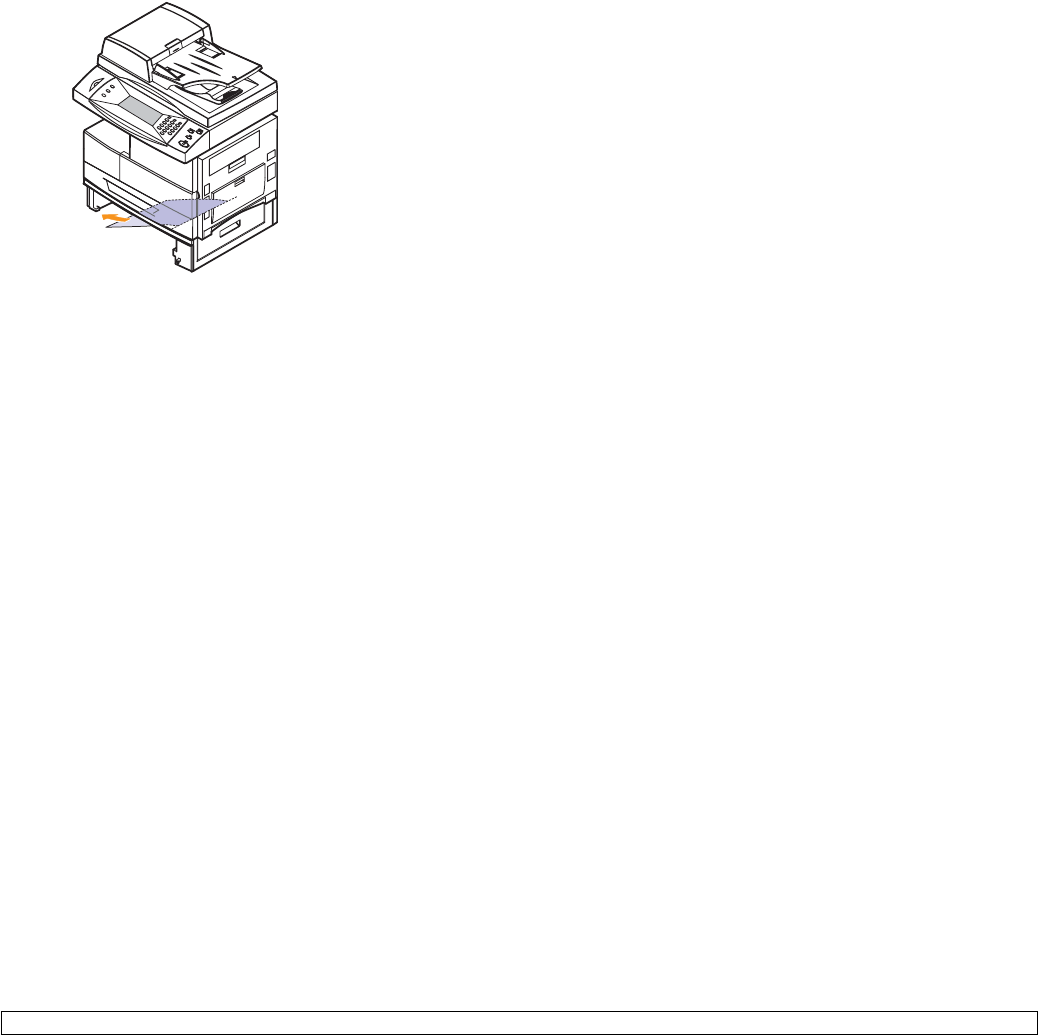
10.4 <
Troubleshooting>
4Remove the paper in the direction shown. To avoid the paper torn,
pull it out gently and slowly.
If you cannot find the jammed paper, or if there is any resistance
removing the paper, stop pulling and continue to step 5.
5Open the outer jam cover in tray2.
6Open the inner cover of tray2.
7Pull the jammed paper out in the direction shown. To avoid tearing
the paper, pull it out gently and slowly.
8Close the two jam covers.
To clear paper jam in Tray 2, follow the instructions on page 10.3.
In the multi-purpose tray
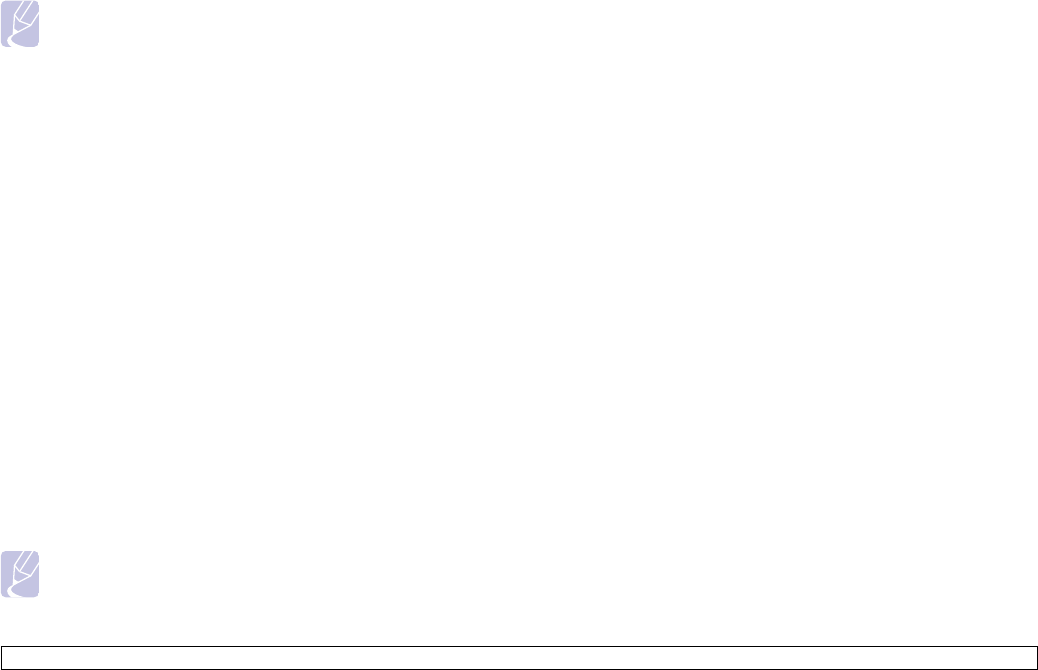
10.5 <
Troubleshooting>
1If the paper is not feeding properly, pull the paper out of the
machine.
2Open and close the front cover to resume printing.
In the fuser area or around the toner cartridge
Note
The fuser area is hot. Take care when removing paper from the
machine.
1Open the side cover.
1Open the side cover.
2Pull down on the fuser lever as shown below.
This will release pressure on the paper.
If paper is not seen in this area, skip to the Exit Area.
Note
Do not pull paper up through the fusing unit. Unfused toner may
adhere to the area, resulting in smudged copies.
3Remove the jammed paper, in the direction shown.
4Push the fuser lever up, and then close the side cover.
5Open and close the front cover to resume printing.
In the paper exit area
1Open the side cover.
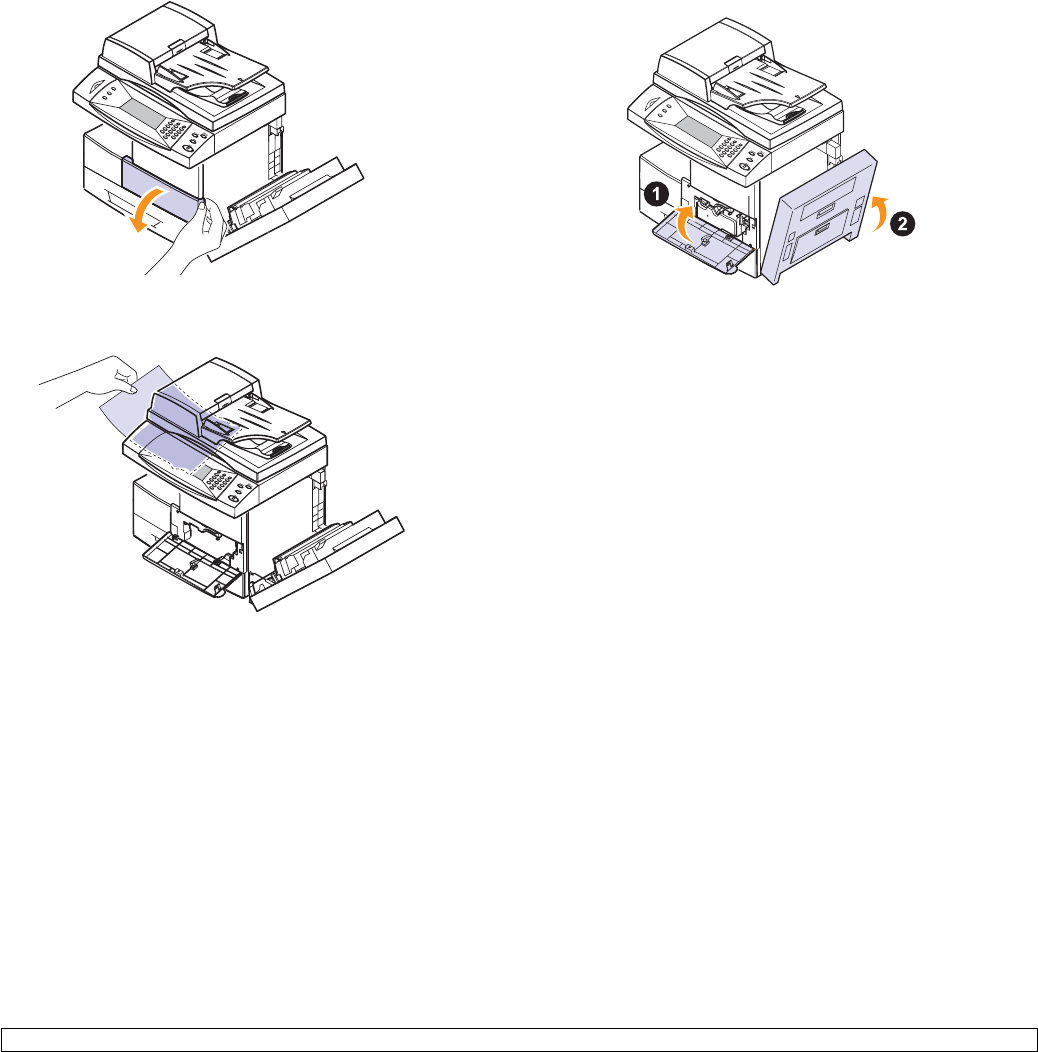
10.6 <
Troubleshooting>
2Open the front cover.
3Turn the Jam Remove Lever in the direction of the arrow to move
the paper to the exit area, then gently pull the paper out through the
exit area.
4Turn the Jam Remove Lever back to the original position.
5Close the front cover n and the side cover o. Printing
automatically resumes.
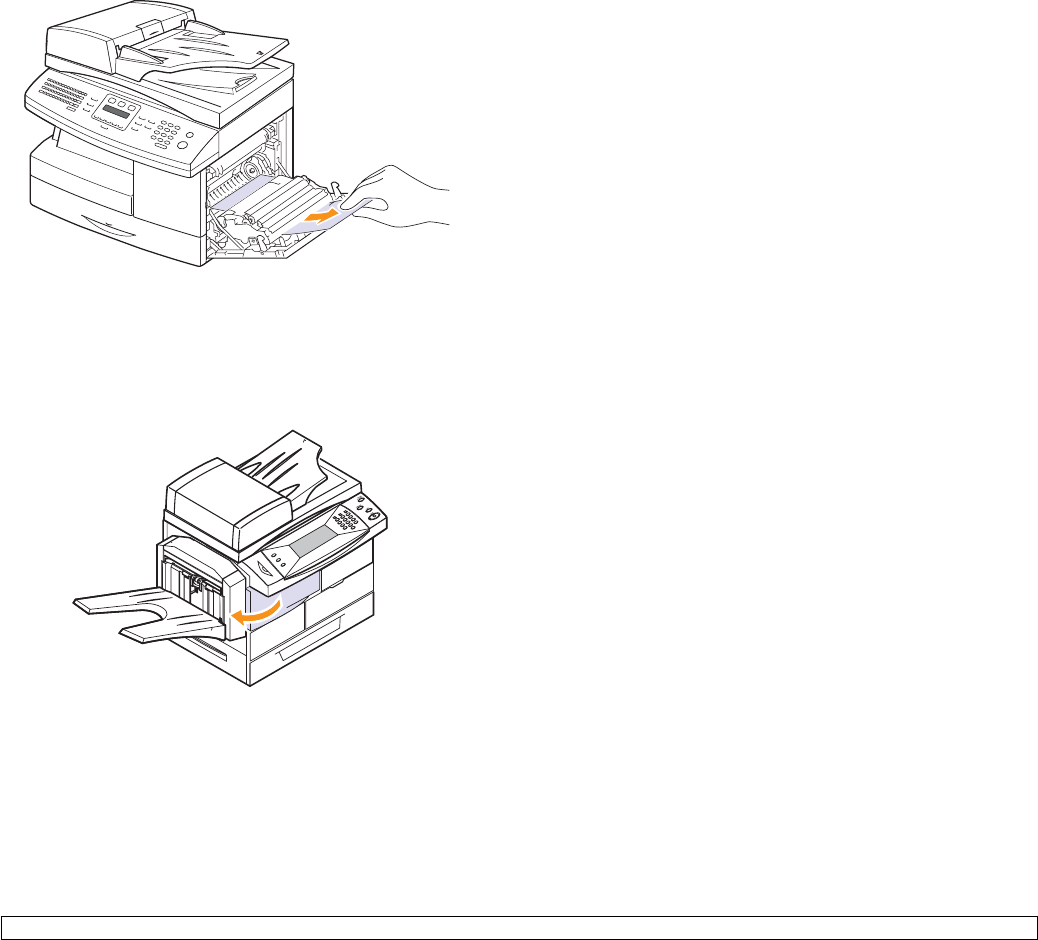
10.7 <
Troubleshooting>
In the duplex unit area
If the duplex unit is not inserted correctly, paper jam may occur. Make
sure that the duplex unit is inserted correctly.
1Open the side cover.
2Remove the jammed paper.
3Close the side cover.
In the stacker
1Open the stacker cover.
2Push the stacker lever up.
3Remove the jammed paper.
4Pull down on the stacker lever.
5Close the stacker cover.
Tips for avoiding paper jams
By selecting the correct media types, most paper jams can be avoided.
When a paper jam occurs, follow the steps outlined on page 10.2.
• Follow the procedures on page 3.5. Ensure that the adjustable guides
are positioned correctly.
• Do not overload the tray. Ensure that the paper level is below the
paper capacity mark on the inside wall of the tray.
• Do not remove paper from the tray while your machine is printing.
• Flex, fan, and straighten paper before loading.
• Do not use creased, damp, or highly curled paper.
• Do not mix paper types in a tray.
• Use only recommended print media. See page
3.8
.
• Ensure that the recommended print side of print media is facing down
in the tray, or facing down in the multi-purpose tray.
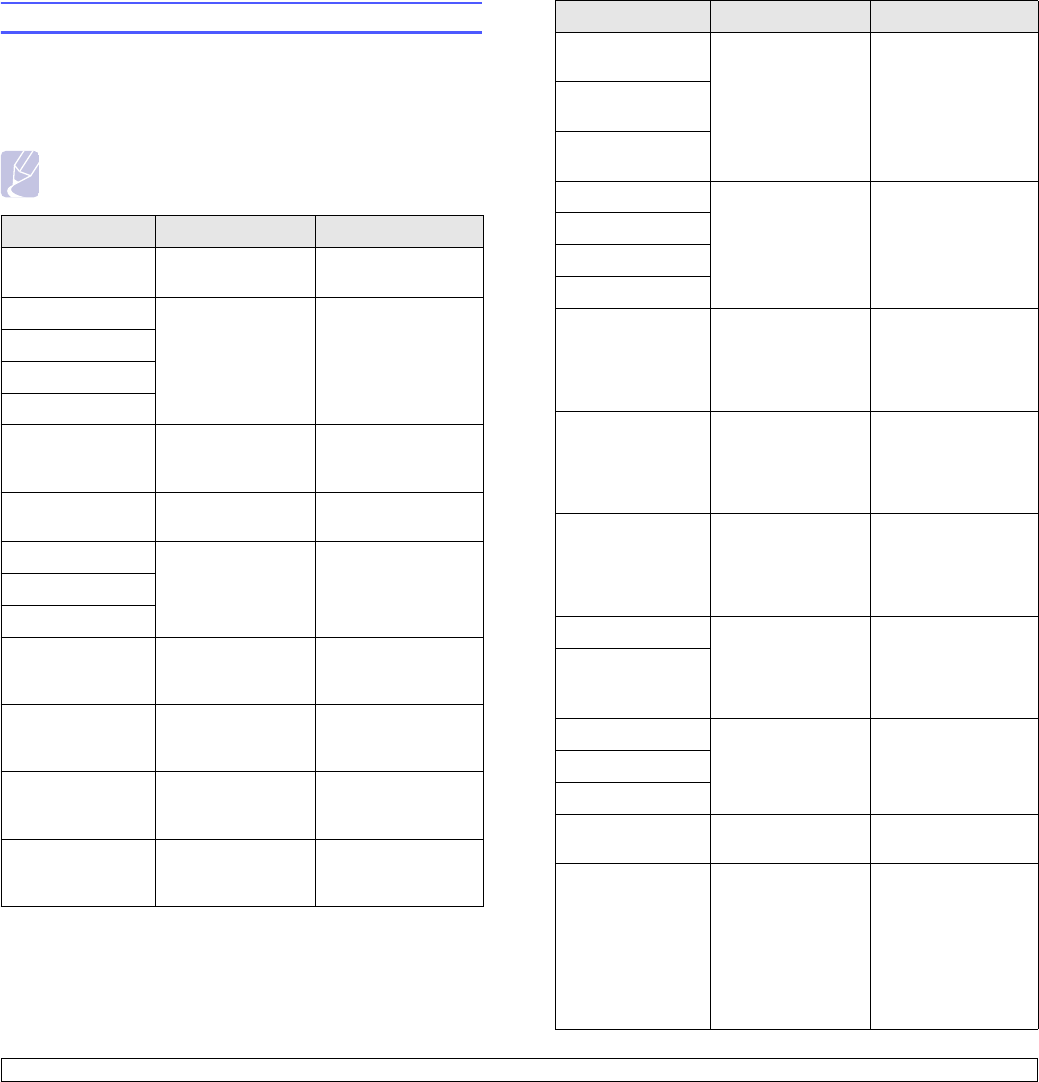
10.8 <
Troubleshooting>
Understanding display messages
Messages appear on the Smart Panel program window or the control
panel display to indicate the machine’s status or errors. Refer to the
tables below to understand the messages’ meaning and correct the
problem if necessary. Messages and their meanings are listed in
alphabetical order.
Note
When you call for service, it is very convenient to tell the service
representative the display message.
Message Meaning Suggested solutions
Feed Jam at MPT Paper Misfed from
multi-purpose tray
Clear the jam. See
page 10.4.
Feed Jam at Tray 1 Paper Misfed from
tray
Clear the jam. See
page 10.2 and 10.3.
Feed Jam at Tray 2
Feed Jam at Tray 3
Feed Jam at Tray 4
Registration Jam Paper has jammed
in the registration
area
Jam at Fuser Paper has jammed
in the fuser area.
Clear the jam. See
page 10.5.
Jam at Tray 2 Paper has jammed
in the feeding area
of the tray.
Clear the jam. See
page 10.2 and
page 10.3.
Jam at Tray 3
Jam at Tray 4
Duplex Jam 0 Paper has jammed
during duplex
printing.
Clear the jam. See
page 10.7.
Duplex Jam 1 Paper has jammed
during duplex
printing.
Clear the jam. See
page 10.7.
Duplex Jam 2 Paper has jammed
during duplex
printing.
Clear the jam. See
page 10.7.
Output Bin full Printed papers are
full on the finisher.
Remove printed
papers from the
finisher.
Check Tray 2 Feed
Area
Paper has jammed
in the tray feed area.
Clear the jam. See
page 10.3.
Check Tray 3 Feed
Area
Check Tray 4 Feed
Area
Fuser error There is a problem
in the fuser unit.
Unplug the power
cord and plug it back
in. If the problem still
persisters, please call
for service.
Fuser Low Error
Fuser High Error
Fuser unit error
Main motor failure There is a problem
in the motor unit.
Unplug the power
cord and plug it back
in. If the problem still
persists, please call
for service.
Duplex Fan 1
failure
There is a problem
in the duplex Fan 1.
Unplug the power
cord and plug it back
in. If the problem still
persists, please call
for service.
SMPS Fan failure There is a problem
in the SMPW Fan
failure.
Unplug the power
cord and plug it back
in. If the problem still
persists, please call
for service.
LSU Motor Error A problem has
occurred in the LSU
(Laser Scanning
Unit).
Unplug the power
cord and plug it back
inches. If the problem
persists, please call
for service.
LSU H sync Error
Tray2 I/F Error Tray is installed, but
has problem in I/F
Tray3 I/F Error
Tray4 I/F Error
Toner Low The toner cartridge
is almost empty.
Ensure a replacement
cartridge is in stock.
Toner Empty The toner in the
cartridge has run
out.
Install a new genuine
toner cartridge.
You can keep printing
but the quality cannot
be guaranteed, and
the product support is
no longer provided.
??
Message Meaning Suggested solutions
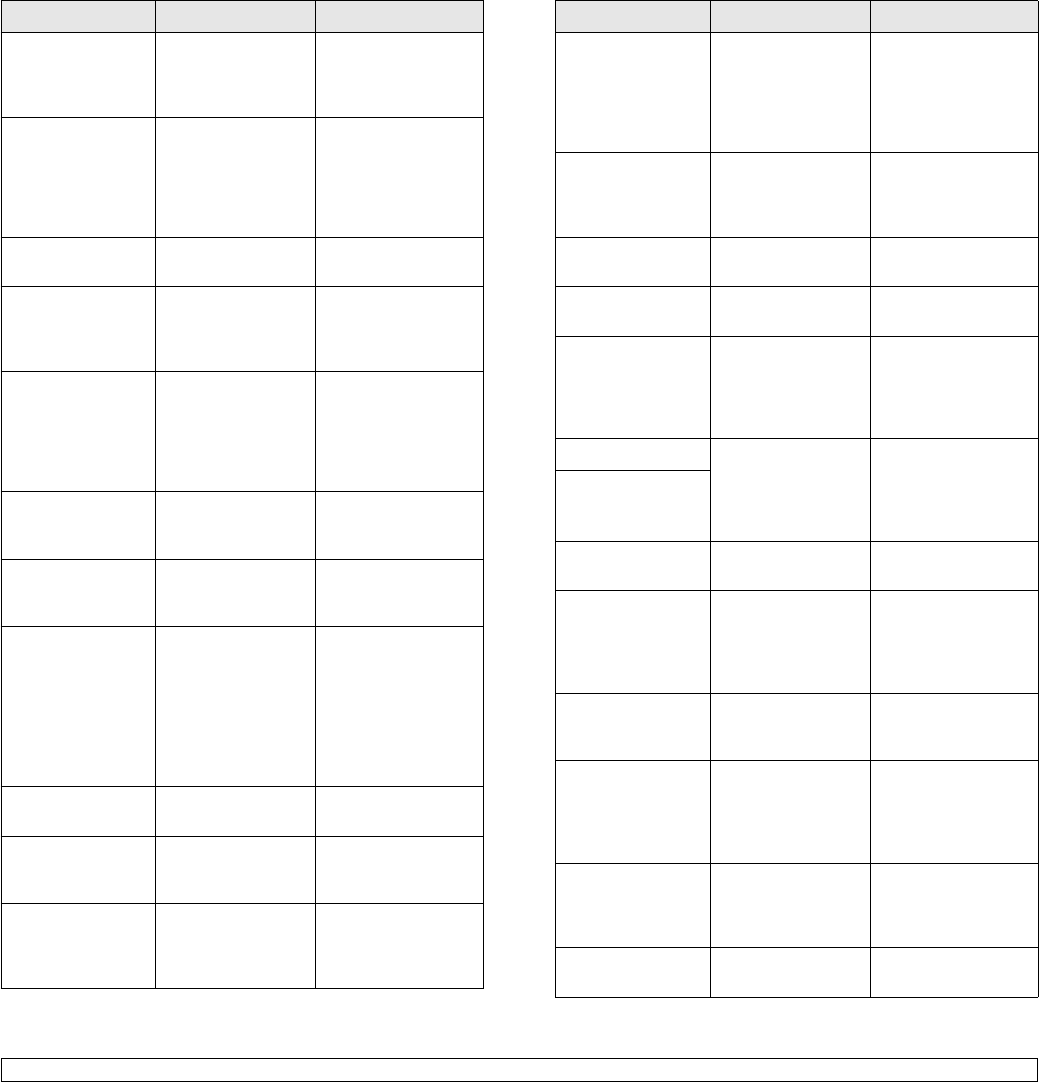
10.9 <
Troubleshooting>
Invalid Toner
Cartridge
The toner cartridge
you have installed is
not for your printer.
Install a Samsung-
genuine toner
cartridge, designed
for your printer.
Toner Supply error Not supplied toner to
the developer before
arriv
Remove the seal tape
from the toner
cartridge, and check
the lever for the
shutter on the toner
cartridge. ??
Toner Page Count
Reached
Toner Page Count is
expired.
Toner Cartridge
Write Error
Writing the toner
cartridge information
to the crum has
failed.
Replace the toner
cartridge.
Toner Cartridge
Communication
Error
Communication
between the toner
cartridge and the
machine has failed.
The toner cartridge
is invalid.
Install a Samsung-
genuine toner
cartridge, designed
for your machine.
Drum Warning The drum cartridge
is near the end of its
life.
Ensure a replacement
cartridge in stock.
Replace Drum The drum cartridge
is at the end of its
life.
Replace the drum
cartridge. See page
9.5.
Install Developer-
Drum Cartridge.
The developer-drum
cartridge is not
installed, or the
CRUM in cartridge is
not connected.
Install he developer-
drum cartridge. When
it is already installed,
reinstall the cartridge
again.
If the problem
persists, please call
for service.
Toner Sensor
Error
A toner cartridge is
not installed.
Install a toner
cartridge.
Drum Lock The drum cartridge
has some
mechanical problem.
Replace the drum
cartridge.
Drum Cartridge
Write Error
Writing the drum
cartridge information
to the crum has
failed.
Replace the drum
cartridge.
Message Meaning Suggested solutions
Drum
Communication
Error
Communication
between the drum
cartridge and the
machine has failed.
The drum cartridge
is invalid.
Install a Samsung-
genuine drum
cartridge, designed
for your machine.
Invalid Drum
cartridge
The drum cartridge
is invalid.
Install a Samsung-
genuine drum
cartridge, designed
for your machine.
Toner Cartridge
Read Error
Drum Cartridge
Read Error
Mix Installed Toner For increase the
mixing time when
installing the new
drum cru up to 120
sec
Finisher Jam 0 Paper jammed in
finisher.
Open the finisher
door and remove
jammed paper by
lowering the guide 1
or 2.
Finisher Jam 1
Finisher Jam 2 Paper jammed in
finisher exit part.
Pull jammed paper
from the finisher exit.
Finisher Duplex
Jam
Paper jammed in
finisher.
Open the finisher
door and remove
jammed paper by
lowering the guide 1
or 2.
Finisher Bin Full Printed papers are
full on the finisher.
Remove printed
papers from the
finisher.
Install Staple
Cartridge
The staple cartridge
is not installed.
Install the staple
cartridge following the
steps explained on
the back of the
finisher door. ??
Finisher Interface
Error
Communication
error has occurred
between the finisher
and the machine.
Please, call for
service.
Paddle Fault Paddle unit is not
operational
Message Meaning Suggested solutions
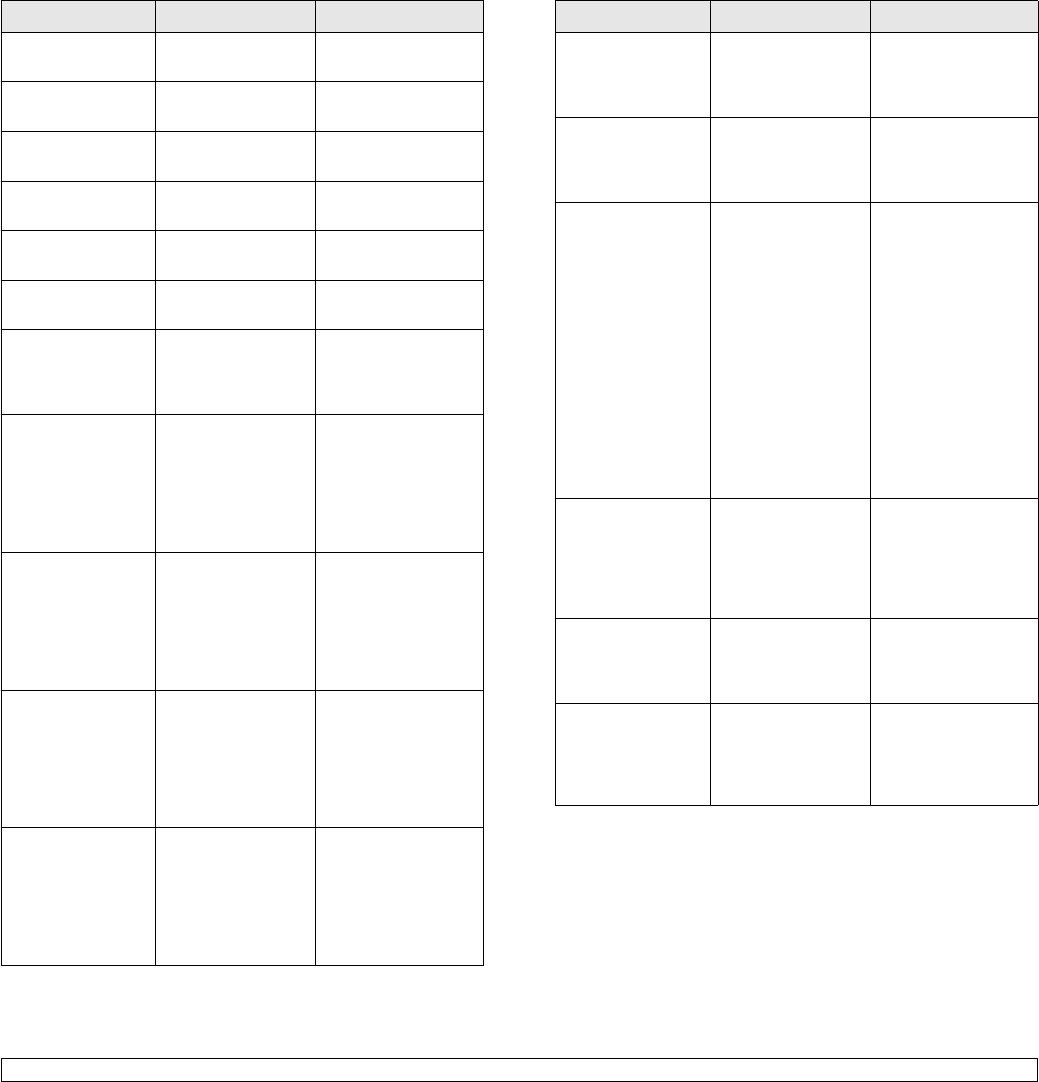
10.10 <
Troubleshooting>
Front Jogger Fault Front Jogger unit is
not operational
Rear Jogger Fault Rear Jogger unit is
not operational
Support Finger
Fault
Support Finger unit
is not operational
Ejector Fault Ejector unit is not
operational
Stapler Fault Stapler is not
operational
Stacker Fault Stacker unit is not
operational
DADF Registration
Jam
The originals
jammed in DADF.
Open DADF cover
and remove jammed
media. See page
10.1.
DADF Scan
Sensor Jam
The lead edge of
the document failed
to actuate the scan
sensor within the
correct time after
actuating the
registration sensor.
DADF Gate Sensor
Jam
The lead edge of the
document failed to
actuate the gate
sensor within the
correct time after
actuating the scan
sensor.
DADF Duplex Jam The lead edge of the
document failed to
actuate the duplex
sensor within the
correct time from the
document is feeding
reversely.
DADF Duplex
Scan Jam
The lead edge of the
document failed to
actuate the scan
sensor within the
correct time after
actuating the duplex
sensor.
Message Meaning Suggested solutions
Paper Sensed in
DADF.
When the machine
is turned on, the
jammed paper within
DADF sensed.
Open DADF door and
remove jammed
paper.
DADF Oversize
Document
Detected
The originals is
double fed, or rover
sized document is
fed.
Open DADF door and
remove jammed
paper.
Use Auxiliary
Access
Will be used to
instruct the user to
connect with the
Remote Copy. Meter
or to insert credit into
the Foreign Device.
This will allow the
user to use the
machine to perform
a print job, receive
Fax jobs and also
make a copy. The
cost for each page
will be set within the
Foreign Device and
not the Jungfrau.
Memory Failure Memory access is
failed.
Turn the machine off
and turn it on again. If
the problem persists,
please call for service
and replace the
DIMM.
Check Fax Kit The fax kit is not
installed, or the fax
does not work
properly.
Reinstall the fax kit. If
the problem persists,
please call for
service.
Check Hard Drive The hard disk drive
does not work
properly.
Turn the machine off
and turn it on again. If
the problem persists,
please call for
service.
Message Meaning Suggested solutions
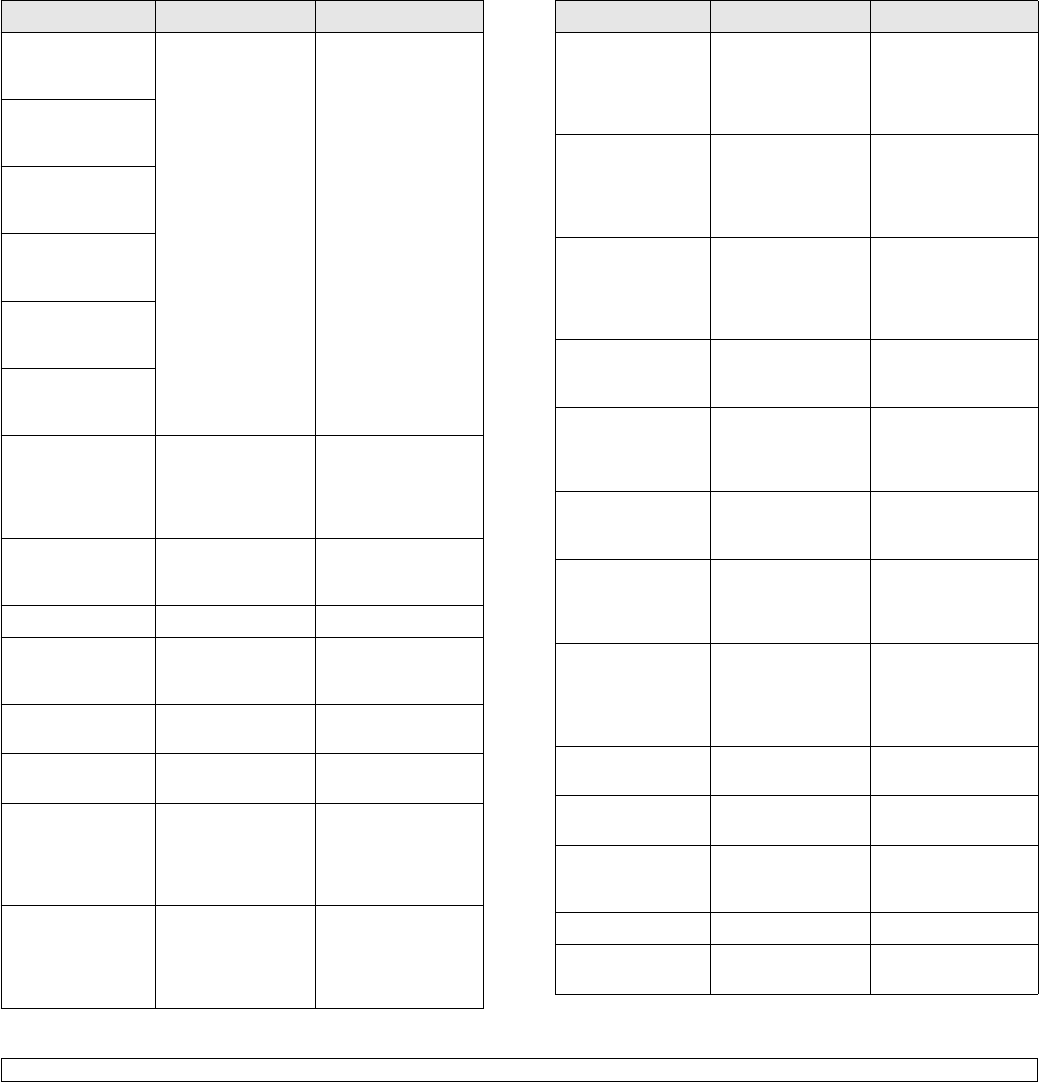
10.11 <
Troubleshooting>
GUI to MCB
Communications
Fault
The communication
error has occurred.
Please, call for
service.
MCB to NIC
Communications
Fault
MCB to DADF
Communications
Fault
MCB to Tray 2
Communications
Fault
MCB to Tray 3
Communications
Fault
MCB to Tray 4
Communications
Fault
MCB Watchdog
Detects Software
Failure
MCB software has
stopped responding.
Turn the machine off
and turn it on again. If
the problem persists,
please call for
service.
Ambient
Temperature
Sensor Fault
CCC Lock
IP address conflict The IP address is
used in other place.
Check the IP address
or obtain new IP
address.
Network cable is
disconnected
The network cable is
disconnected.
Connect the network
cable properly.
Network card is
not installed
The network card is
not installed.
Install the network
card.
BOOTP server
error.An Auto IP
address has been
established.
BOOTP server does
not work. The
machine is working
on setting IP by auto
IP setting function.
Set the network
setting again or input
the new static IP
address.
BOOTP server
error.An Auto IP is
not working
The BOOTP server
does not work, and
the setting IP by
auto IP setting
function is failed.
Set the network
setting again or input
the new static IP
address.
Message Meaning Suggested solutions
DHCP server
error.An Auto IP
address has been
established.
DHCP server does
not work. The
machine is working
on setting IP by auto
IP setting function.
Set the network
setting again or input
the new static IP
address.
DHCP server
error.An Auto IP is
not working
The DHCP server
does not work, and
the setting IP by
auto IP setting
function is failed.
Set the network
setting again or input
the new static IP
address.
Maching cloning
is in process. This
will take a few
minutes to
complete
Job will be
blocked during
Machine Cloning
Cloning process is
updating the
system
configuration
Machine cloning
completed
successfully
Cloning
processing
canceled by CRC
checksum failure
Cloning
processing
canceled by
Firmware version
check failure
Fax Memory is
low.
Fax Memory is
empty.
Group Name has
no assigned Email
addresses
Email Send Failed
Invalid Recipient
Email Address
Message Meaning Suggested solutions

10.12 <
Troubleshooting>
Network
Controller Error
Connection with the
SMTP server failed.
Check the server
settings and the
network cable.
Network
Connection
Failure
The protocol you
have entered is not
supported or server
port is wrong.
Check the protocol or
server port.
Authentication
Failure
The ID or password
you entered is
incorrect.
Enter the correct ID or
password.
Mail Server
Connection
Failure
DNS Connection
Failure
Mail Too Large
Invalid Email
Address
Group not
available
LDAP
Connuniction
Failure
LDAP Search
Failed
LDAP Search
Timeout Exceeded
No Matching
Entries in LDAP
Directory
Session Timeout
Authentication
Required
Pop3 Error
Pop3 Connection
Failure
Pop3
Authentication
Failure
Pop3
Authentication
Required
Message Meaning Suggested solutions
Mail exceed server
support
Scan Error
Stop pressed from
MFP
Memory Full The memory is full. Delete unnecessary
fax jobs and
retransmit after more
memory becomes
available.
Alternatively, split the
transmission into
more than one
operation.
Communication
Error
Group not
available
You have tried to
select a group
location number
where only a single
location number can
be used, such as
when adding
locations for a
Multiple Send
operation.
Use a speed dial
number or dial a
number manually
using the number
keypad.
Incompatible
Line Busy The receiving fax
machine did not
answer or the line is
already engaged.
Try again after a few
minutes.
Line Error Your ma chine
cannot connect with
the receiving fax
machine or has lost
contact because of a
problem with the
phone line.
Try again. If the
problem persists, wait
an hour or so for the
line to clear and try
again.
Or, turn the ECM
mode on. See
page x.x.
Low Memory
No Answer The receiving fax
machine has not
answered after
several redial
attempts.
Try again. Make sure
that the receiving
machine is
operational.
Message Meaning Suggested solutions
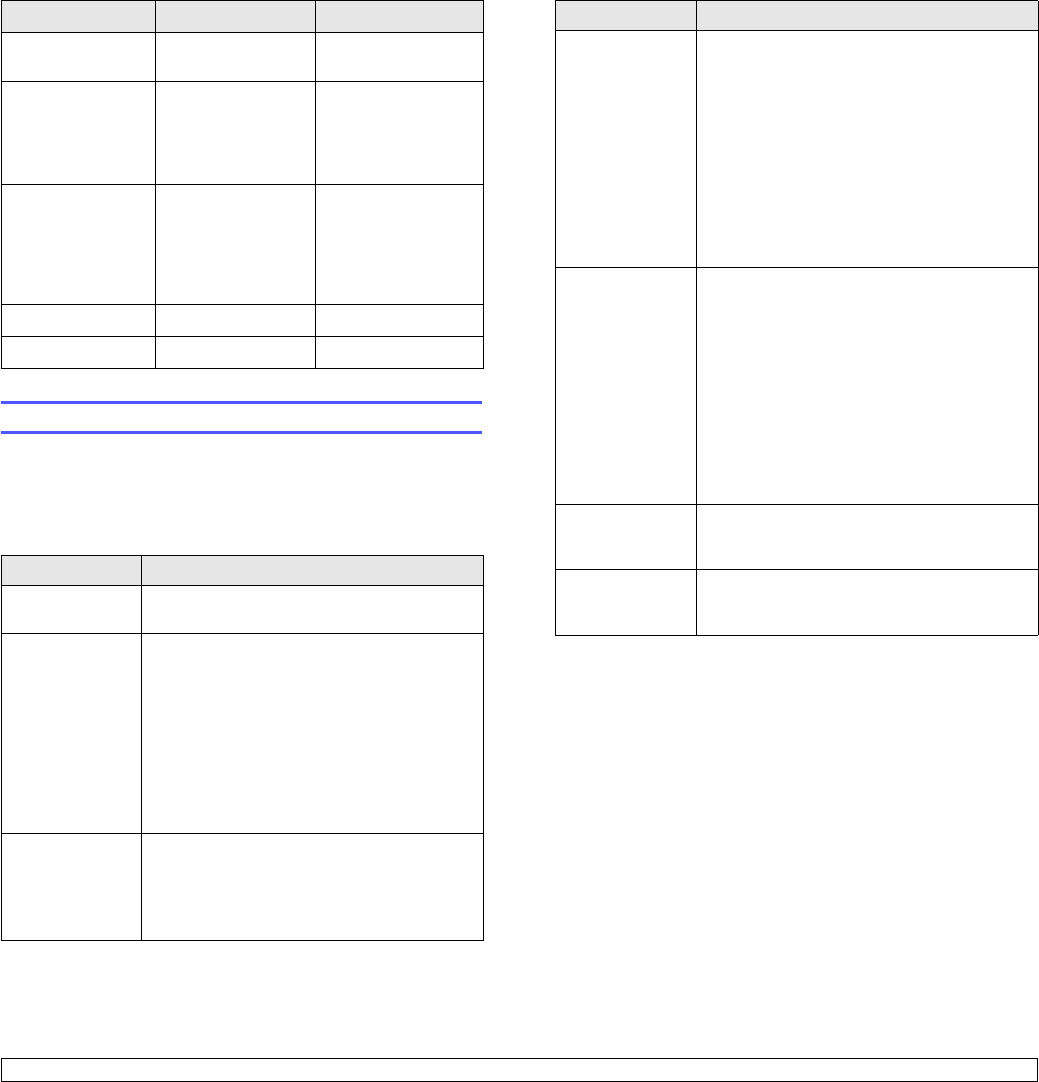
10.13 <
Troubleshooting>
Solving other problems
The following chart lists some conditions that may occur and the
recommended solutions. Follow the suggested solutions until the
problem is corrected. If the problem persists, please call for service.
Paper feeding problems
Number Not
Assigned
Power Failure Power has turned off
then on and the
machine’s memory
has not been back
up.
The job which you
were trying to do
before the power
failure must be
completely re-done.
Retry Redial? The machine is
waiting for a
specified time
interval to redial a
previously busy
station.
You can press OK to
immediately redial, or
Stop/Clear to cancel
the redial operation.
Mailbox Error
Scanning Error
Condition Suggested solutions
Paper is jammed
during printing.
Clear the paper jam. See page 10.2.
Paper sticks
together.
• Ensure that there is not too much paper in the
tray. The tray can hold up to 550 sheets of
paper, depending on the thickness of your
paper.
• Make sure that you are using the correct type
of paper. See page 3.3.
• Remove paper from the tray and flex or fan
the paper.
• Humid conditions may cause some paper to
stick together.
Multiple sheets of
paper do not
feed.
• Different types of paper may be stacked in the
tray. Load paper of only one type, size, and
weight.
• If multiple sheets have caused a paper jam,
clear the paper jam. See page 10.2.
Message Meaning Suggested solutions
Paper does not
feed into the
machine.
• Remove any obstructions from inside the
machine.
• Paper has not been loaded correctly. Remove
paper from the tray and reload it correctly.
• There is too much paper in the tray. Remove
excess paper from the tray.
• The paper is too thick. Use only paper that
meets the specifications required by the
machine. See page 3.3.
• If an original does not feed into the machine,
the DADF rubber pad may require to be
replaced. Contact a service representative.
The paper keeps
jamming.
• There is too much paper in the tray. Remove
excess paper from the tray. If you are printing
on special materials, use the multi-purpose
tray.
• An incorrect type of paper is being used. Use
only paper that meets the specifications
required by the machine. See page 3.3.
• There may be debris inside the machine.
Open the front cover and remove the debris.
• If an original does not feed into the machine,
the DADF rubber pad may require to be
replaced. Contact a service representative.
Transparencies
stick together in
the paper exit.
Use only transparencies specifically designed
for laser printers. Remove each transparency as
it exits from the machine.
Envelopes skew
or fail to feed
correctly.
Ensure that the paper guides are against both
sides of the envelopes.
Condition Suggested solutions
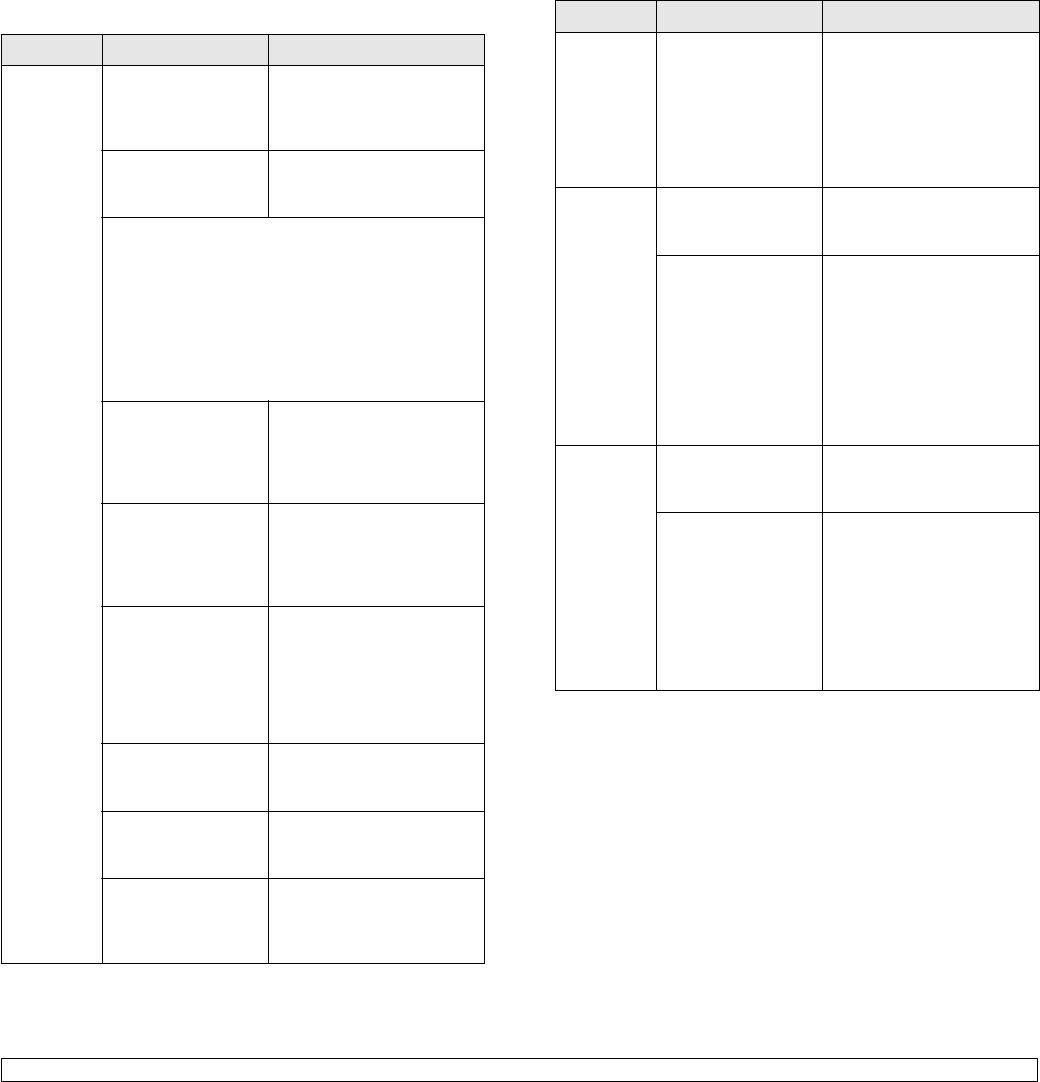
10.14 <
Troubleshooting>
Printing problems
Condition Possible cause Suggested solutions
The
machine
does not
print.
The machine is not
receiving power.
Check the power cord
connections. Check the
power switch and the power
source.
The machine is not
selected as the
default printer.
Select Samsung SCX-6x45
Series PCL 6 as your default
printer in your Windows.
Check the machine for the following:
• The front cover is not closed. Close the cover.
• Paper is jammed. Clear the paper jam. See
page 10.2.
• No paper is loaded. Load paper. See page 3.5.
• The toner cartridge is not installed. Install the toner
cartridge.
If a system error occurs, contact your service
representative.
The connection cable
between the
computer and the
machine is not
connected properly.
Disconnect the printer cable
and reconnect it.
The connection cable
between the
computer and the
machine is defective.
If possible, attach the cable
to another computer that is
working properly and print a
job. You can also try using a
different printer cable.
The port setting is
incorrect.
Check the Windows printer
setting to make sure that the
print job is sent to the correct
port. If the computer has
more than one port, make
sure that the machine is
attached to the correct one.
The machine may be
configured
incorrectly.
Check the printer properties
to ensure that all of the print
settings are correct.
The printer driver
may be incorrectly
installed.
Repair the printer software.
See the
Software Section
.
The machine is
malfunctioning.
Check the display message
on the control panel to see if
the machine is indicating a
system error.
The
machine
selects print
materials
from the
wrong
paper
source.
The paper source
selection in the
printer properties
may be incorrect.
For many software
applications, the paper
source selection is found
under the Paper tab within
the printer properties. Select
the correct paper source.
See the printer driver help
screen.
A print job
is extremely
slow.
The job may be very
complex.
Reduce the complexity of the
page or try adjusting the print
quality settings.
If you are using
Windows 98/Me, the
Spool Setting may be
set incorrectly.
From the Start menu, choose
Settings and then Printers.
Right-click the Samsung
SCX-6x45 Series PCL 6
machine icon, choose
Properties, click the Details
tab, and then choose the
Spool Settings button.
Select the desired spool
setting.
Half the
page is
blank.
The page orientation
setting may be
incorrect.
Change the page orientation
in your application. See the
printer driver help screen.
The paper size and
the paper size
settings do not
match.
Ensure that the paper size in
the printer driver settings
matches the paper in the
tray.
Or, ensure that the paper
size in the printer driver
settings matches the paper
selection in the software
application settings you use.
Condition Possible cause Suggested solutions
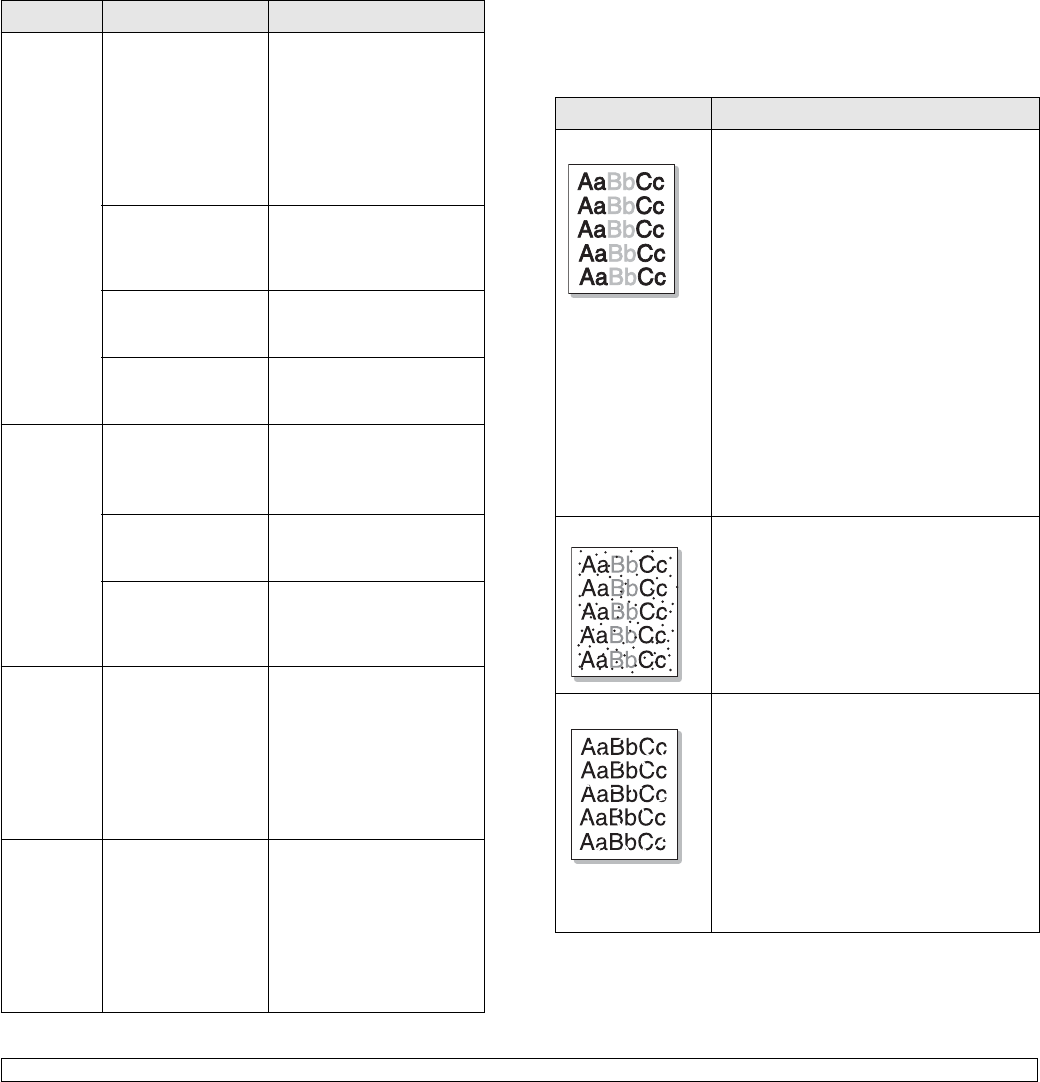
10.15 <
Troubleshooting>
The
machine
prints, but
the text is
wrong,
garbled, or
incomplete.
The printer cable is
loose or defective.
Disconnect the printer cable
and reconnect. Try a print job
that you have already printed
successfully. If possible,
attach the cable and the
machine to another computer
and try a print job that you
know works. Finally, try a
new printer cable.
The wrong printer
driver was selected.
Check the application’s
printer selection menu to
ensure that your machine is
selected.
The software
application is
malfunctioning.
Try printing a job from
another application.
The operating system
is malfunctioning.
Exit Windows and reboot the
computer. Turn the machine
off and then back on again.
Pages print,
but are
blank.
The toner cartridge is
defective or out of
toner.
Redistribute the toner, if
necessary. See page 9.3.
If necessary, replace the
toner cartridge.
The file may have
blank pages.
Check the file to ensure that
it does not contain blank
pages.
Some parts, such as
the controller or the
board, may be
defective.
Contact a service
representative.
When you
are using
Windows
98, the
illustrations
print
incorrectly
from Adobe
Illustrator.
The setting in the
software application
is wrong.
Select Download as Bit
Image in the Advanced
Options window of the
graphic properties and print
the document again.
PDF file
does not
print
correctly-
some parts
are missing
in graphics,
text or
illustrations.
Incompatibility
between the PDF file
and the Acrobat
products.
Printing the PDF file as an
image may enable the file to
print. Turn on Print As
Image from the Acrobat
printing options.
Note: It Will take longer to
print when you print a PDF
file as an image.
Condition Possible cause Suggested solutions Printing quality problems
If the inside of the machine is dirty or paper has been loaded improperly,
you may notice a reduction in print quality. See the table below to clear
the problem.
Condition Suggested solutions
Light or faded print
If a vertical white streak or faded area appears
on the page:
• The toner supply is low. You may be able to
temporarily extend the toner cartridge life.
See page 9.3. If this does not improve the
print quality, install a new toner cartridge.
• The paper may not meet paper
specifications; for example, the paper is too
moist or too rough. See page 3.3.
• If the entire page is light, the print resolution
setting is too low or the toner save mode is
on. Adjust the print resolution and turn the
toner save mode off. See the help screen of
the printer driver and page x.x, respectively.
• A combination of faded or smeared defects
may indicate that the toner cartridge needs
cleaning. Contact a service representative.
• The surface of the LSU part inside the
machine may be dirty. Clean the LSU,
contact a service representative.
Toner specks
• The paper may not meet specifications; for
example, the paper is too moist or too
rough. See page 3.3.
• The transfer roller may be dirty. Clean the
inside of your machine. Contact a service
representative.
• The paper path may need cleaning. Contact
a service representative.
Dropouts
If faded areas, generally rounded, occur
randomly on the page:
• A single sheet of paper may be defective.
Try reprinting the job.
• The moisture content of the paper is uneven
or the paper has moist spots on its surface.
Try a different brand of paper. See page 3.3.
• The paper lot is bad. The manufacturing
processes can cause some areas to reject
toner. Try a different kind or brand of paper.
• If these steps do not correct the problem,
contact a service representative.
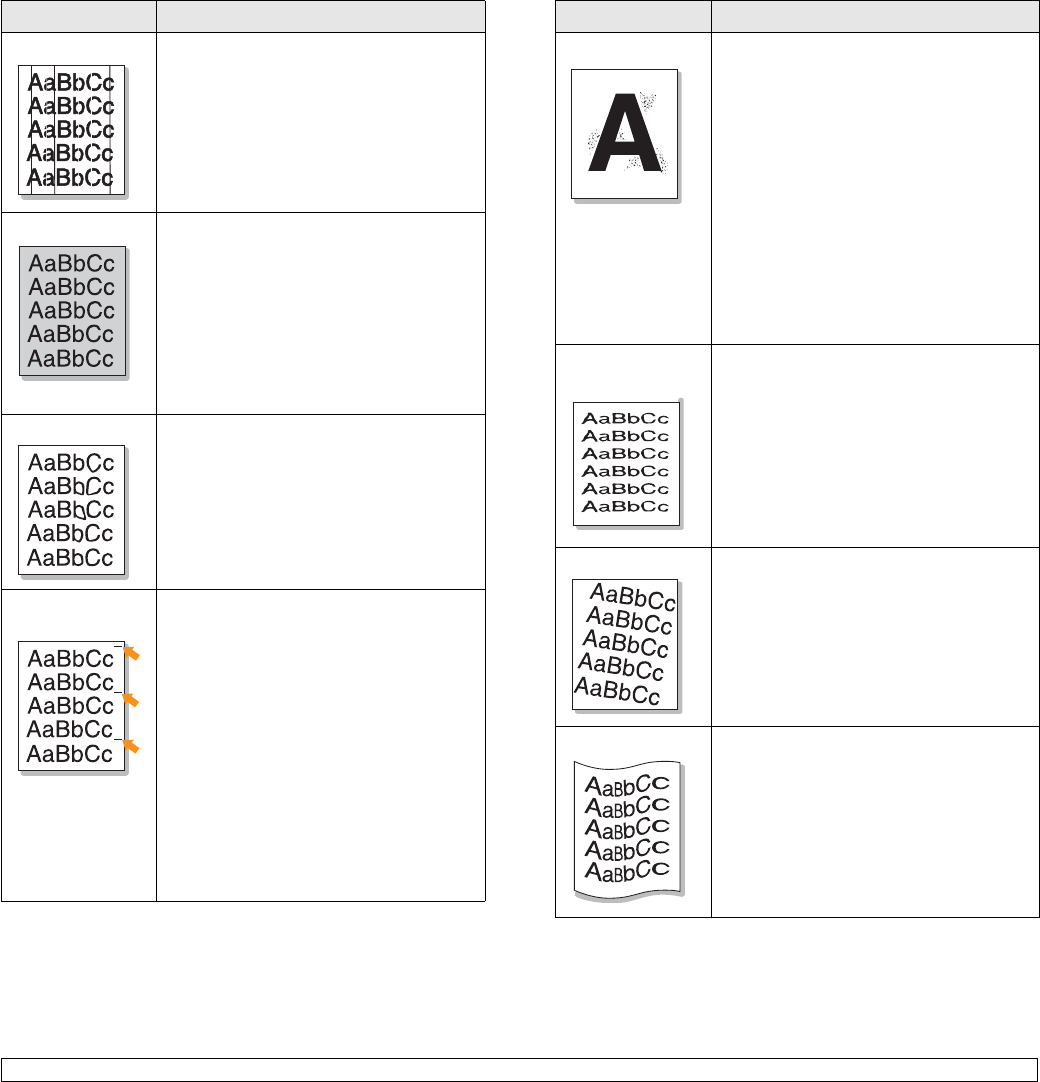
10.16 <
Troubleshooting>
Vertical lines
If black vertical streaks appear on the page:
• The drum inside the printer has probably
been scratched. Remove the drum cartridge
and install a new one. See page 9.5.
If white vertical streaks appear on the page:
• The surface of the LSU part inside the
machine may be dirty. Clean the LSU.
Contact a service representative.
Gray background
If the amount of background shading becomes
unacceptable:
• Change to a lighter weight paper. See
page 3.3.
• Check the machine’s environment: very dry
(low humidity) or high humidity (higher than
80% RH) conditions can increase the
amount of background shading.
• Remove the old drum and toner cartridge
and then, install a new one. See page 9.4.
Toner smear
• Clean the inside of the machine. Contact a
service representative.
• Check the paper type and quality. See
page 3.3.
• Remove the drum and toner cartridge and
then, install a new one. See page 9.4.
Vertical repetitive
defects
If marks repeatedly appear on the printed side
of the page at even intervals:
• The drum and toner cartridge may be
damaged. If a repetitive mark occurs on the
page, print a cleaning sheet several times to
clean the cartridge; contact a service
representative. After the printout, if you still
have the same problems, remove the drum
and toner cartridge and then, install a new
one. See page 9.4.
• Parts of the machine may have toner on
them. If the defects occur on the back of the
page, the problem will likely correct itself
after a few more pages.
• The fusing assembly may be damaged.
Contact a service representative.
Condition Suggested solutions
Background scatter
Background scatter results from bits of toner
randomly distributed on the printed page.
• The paper may be too damp. Try printing
with a different batch of paper. Do not open
packages of paper until necessary so that
the paper does not absorb too much
moisture.
• If background scatter occurs on an
envelope, change the printing layout to
avoid printing over areas that have
overlapping seams on the reverse side.
Printing on seams can cause problems.
• If background scatter covers the entire
surface area of a printed page, adjust the
print resolution through your software
application or the printer properties.
Misformed
characters
• If characters are improperly formed and
producing hollow images, the paper stock
may be too slick. Try a different paper. See
page 3.3.
• If characters are improperly formed and
producing a wavy effect, the scanner unit
may need service. For service, contact a
service representative.
Page skew
• Ensure that the paper is loaded properly.
• Check the paper type and quality. See
page 3.3.
• Ensure that the paper or other material is
loaded correctly and the guides are not too
tight or too loose against the paper stack.
Curl or wave
• Ensure that the paper is loaded properly.
• Check the paper type and quality. Both high
temperature and humidity can cause paper
curl. See page 3.3.
• Turn over the stack of paper in the tray. Also
try rotating the paper 180° in the tray.
Condition Suggested solutions
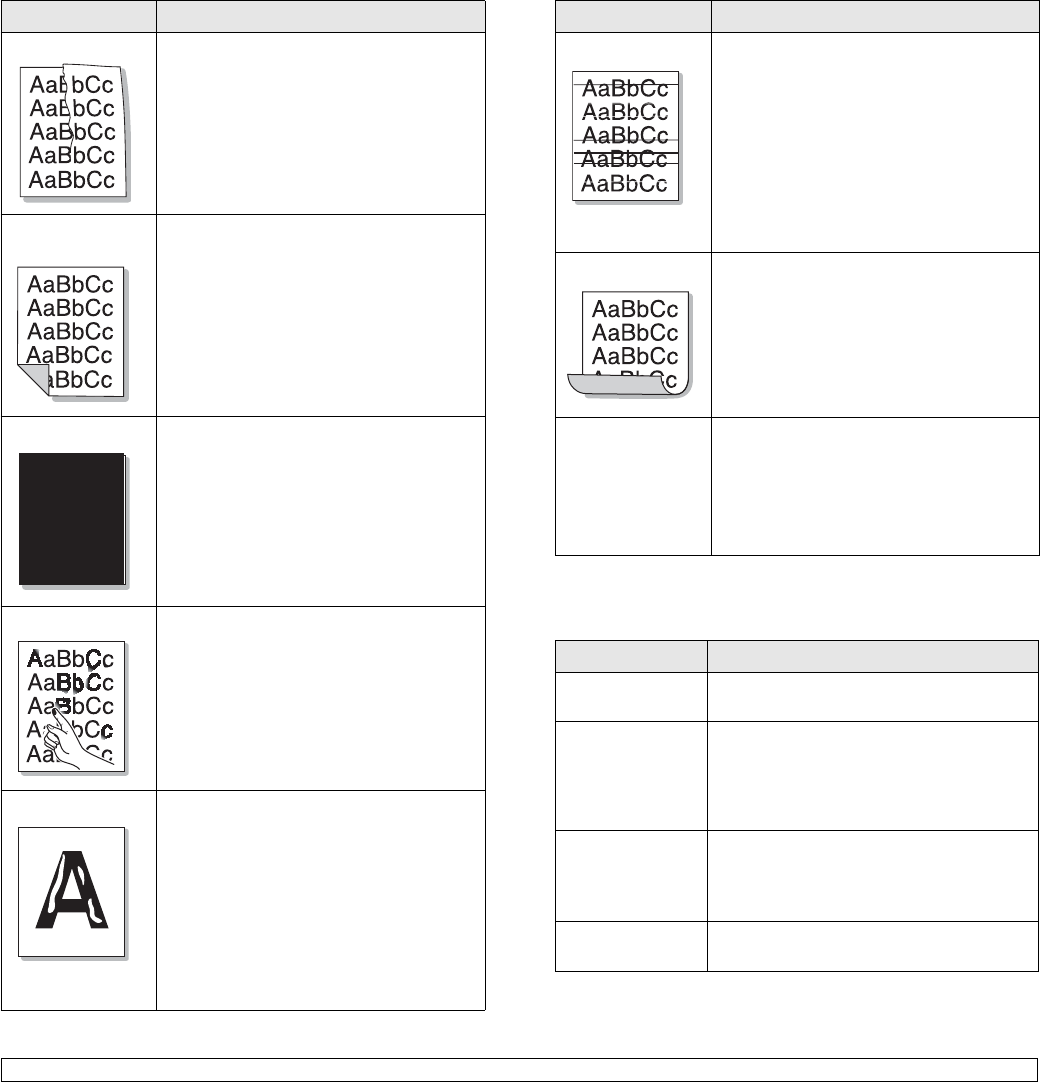
10.17 <
Troubleshooting>
Wrinkles or creases
• Ensure that the paper is loaded properly.
• Check the paper type and quality. See
page 3.3.
• Turn over the stack of paper in the tray. Also
try rotating the paper 180° in the tray.
Back of printouts
are dirty
Check for leaking toner. Clean the inside of
the machine. Contact a service
representative.
Black pages
• The drum cartridge may not be installed
properly. Remove the cartridge and reinsert
it.
• The drum cartridge may be defective and
need replacing. Remove the drum cartridge
and install a new one. See page 9.4.
• The machine may require repair. Contact a
service representative.
Loose toner
• Clean the inside of the machine. Contact a
service representative.
• Check the paper type and quality. See
page 3.3.
• Remove the drum and toner cartridge and
then, install a new one. See page 9.4.
• If the problem persists, the machine may
require repair. Contact a service
representative.
Character Voids
Character voids are white areas within parts of
characters that should be solid black:
• If you are using transparencies, try another
type of transparency. Because of the
composition of transparencies, some
character voids are normal.
• You may be printing on the wrong surface of
the paper. Remove the paper and turn it
around.
• The paper may not meet paper
specifications. See page 3.3.
Condition Suggested solutions
Copying problems
Horizontal stripes
If horizontally aligned black streaks or smears
appear:
• The drum and toner cartridge may be
installed improperly. Remove the cartridge
and reinsert it.
• The drum and toner cartridge may be
defective. Remove the toner cartridge and
install a new one. See page 9.4.
• If the problem persists, the machine may
require repair. Contact a service
representative.
Curl
If the printed paper is curled or paper does not
feed into the machine:
• Turn over the stack of paper in the tray. Also
try rotating the paper 180° in the tray.
An unknown image
repetitively appears
on a next few
sheets or loose
toner, light print, or
contamination
occurs.
You printer is probably being used at an
altitude of 2,500 m(8,200 ft)or above. The high
altitude may affect the print quality such as
loose toner or light imaging. You can set this
option through Printer Settings Utility or
Printer Tab in printer driver’s properties. Refer
to the Software Section for detail.
Condition Suggested solutions
Copies are too light
or too dark.
Use Darkness to darken or lighten the
background of the copies.
Smears, lines,
marks, or spots
appears on copies.
• If defects are on the original, press
Darkness to lighten the background of your
copies.
• If no defects are on the original, clean the
scan unit. See page 9.2.
Copy image is
skewed.
• Ensure that the original is face down on the
scanner glass or face up in the DADF.
• Check that the copy paper is loaded
correctly.
Blank copies print
out.
Ensure that the original is face down on the
scanner glass or face up in the DADF.
Condition Suggested solutions
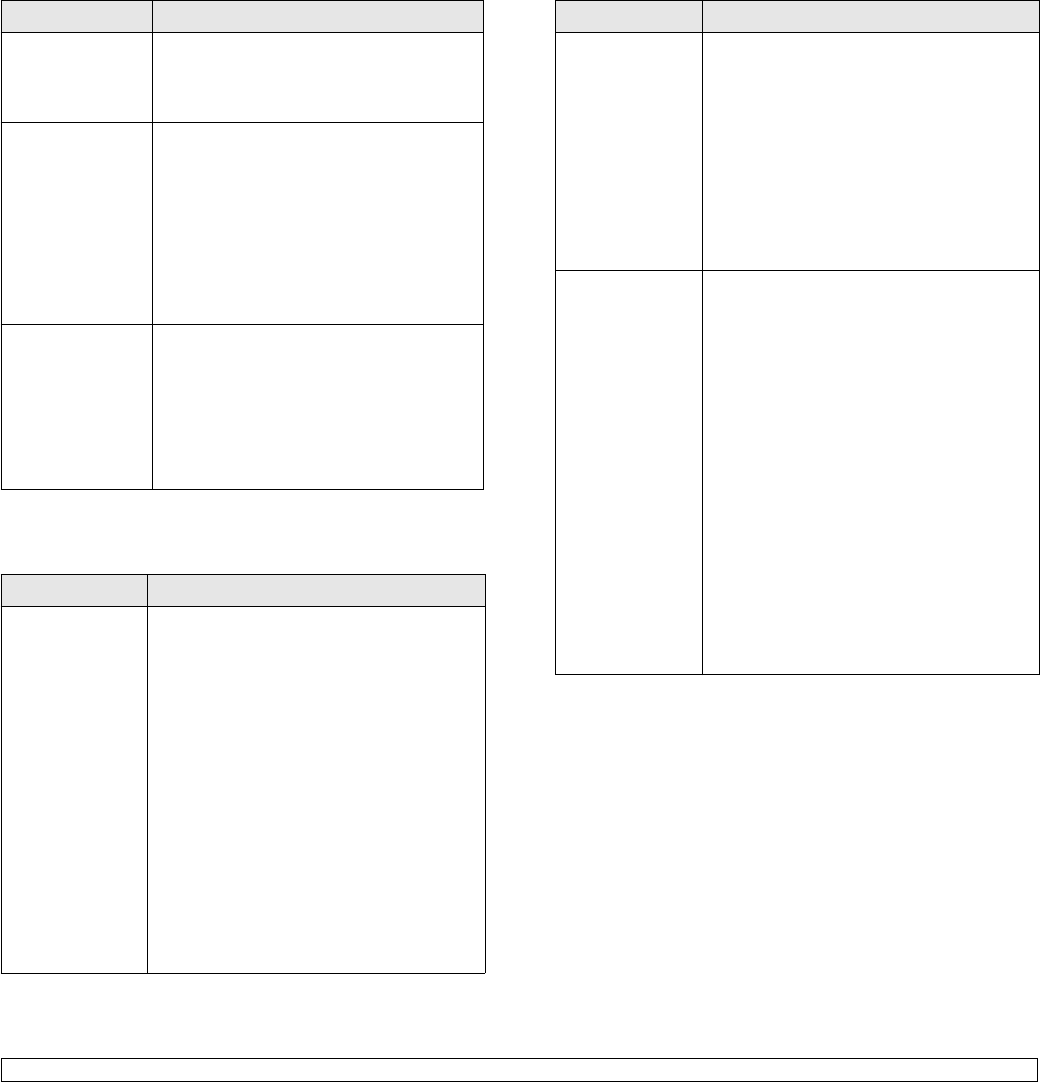
10.18 <
Troubleshooting>
Scanning problems
Image rubs off the
copy easily.
• Replace the paper in the tray with paper
from a new package.
• In high humidity areas, do not leave paper in
the machine for extended periods of time.
Frequent copy
paper jams occur.
• Fan the stack of paper, then turn it over in
the tray. Replace the paper in the tray with a
fresh supply. Check/adjust the paper guides,
if necessary.
• Ensure that the paper is the proper paper
weight. 75 g/m2 bond paper is
recommended.
• Check for copy paper or pieces of copy
paper remaining in the machine after a
paper jam has been cleared.
Toner cartridge
produces fewer
copies than
expected before
running out of
toner.
• Your originals may contain pictures, solids,
or heavy lines. For example, your originals
may be forms, newsletters, books, or other
documents that use more toner.
• The machine may be turned on and off
frequently.
• The scanner lid may be left open while
copies are being made.
Condition Suggested solutions
The scanner does
not work.
• Make sure that you place the original to be
scanned face down on the scanner glass, or
face up in the DADF.
• There may not be enough available memory
to hold the document you want to scan. Try
the Prescan function to see if that works. Try
lowering the scan resolution rate.
• Check that the USB or parallel cable is
connected properly.
• Make sure that the USB or parallel cable is
not defective. Switch the cable with a known
good cable. If necessary, replace the cable.
• If you are using a parallel cable, ensure that it
is compliant with IEEE 1284 standards.
• Check that the scanner is configured
correctly. Check scan setting in the
SmarThru
Configuration
or the application you want to
use to make certain that the scanner job is
being sent to the correct port.
Condition Suggested solutions
The unit scans
very slowly.
• Check if the machine is printing received
data. If so, scan the document after the
received data has been printed.
• Graphics are scanned more slowly than text.
• Communication speed slows in scan mode
because of the large amount of memory
required to analyze and reproduce the
scanned image. Set your computer to the
ECP printer mode through BIOS setting. It
will help to increase the speed. For details
about how to set BIOS, refer to your
computer user’s guide.
Message appears
on your computer
screen:
• “Device can't be
set to the H/W
mode you want.”
• “Port is being
used by another
program.”
•“Port is
Disabled.”
• “Scanner is busy
receiving or
printing data.
When the
current job is
completed, try
again.”
• “Invalid handle.”
• “Scanning has
failed.”
• There may be a copying or printing job in
progress. When that job is complete, try your
job again.
• The Selected port is currently being used.
Restart your computer and try again.
• The printer cable may be improperly
connected or the power may be off. You must
use a parallel cable that supports IEEE 1284
bi-directional communications.
• The scanner driver is not installed or the
operating environment is not set up properly.
• Ensure that the machine is properly
connected and the power is on, Then restart
your computer.
• The USB cable may be improperly connected
or the power may be off.
• Do not use parallel and USB cables at the
same time.
Condition Suggested solutions
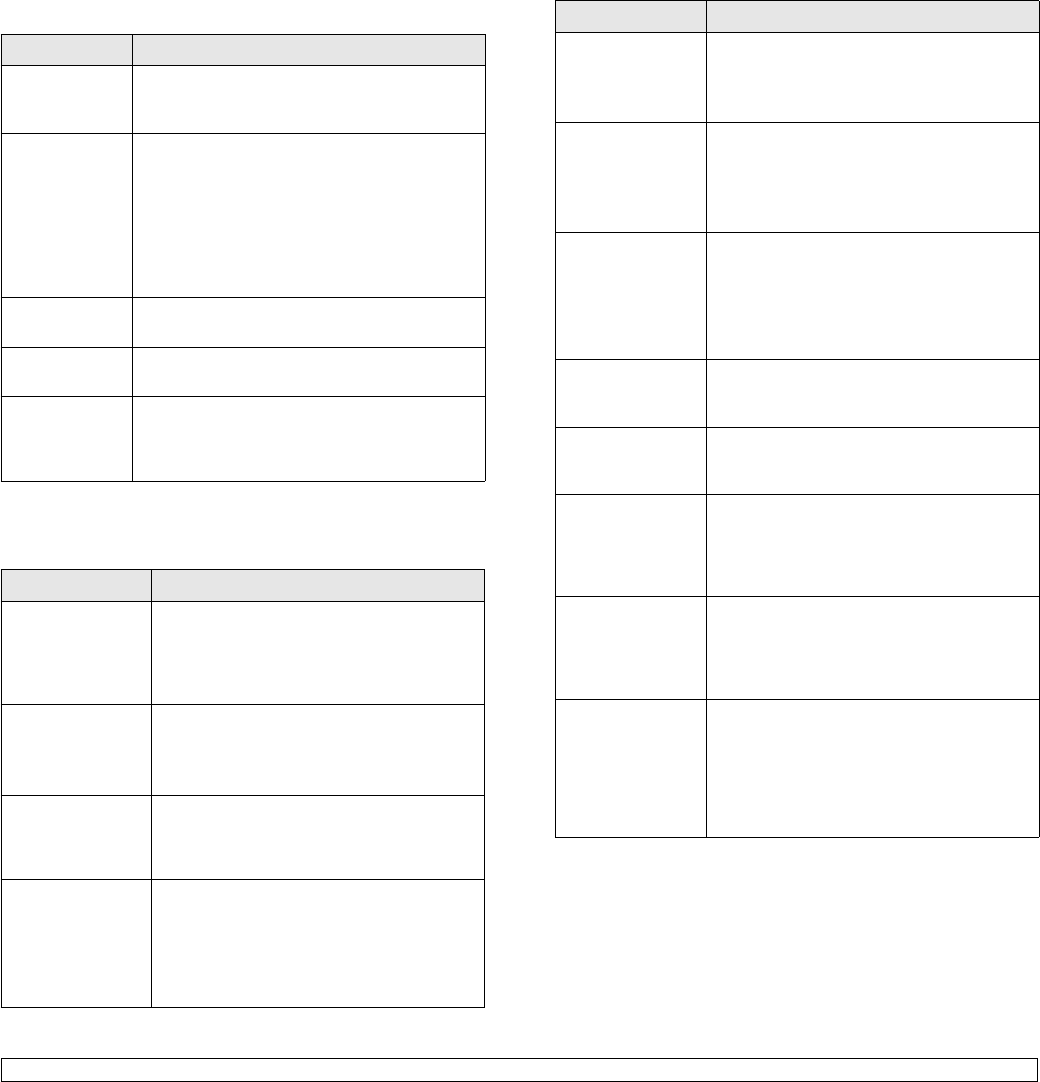
10.19 <
Troubleshooting>
Network Scan problems
Fax problems
Condition Suggested solutions
I cannot find a
scanned image
file.
You can check the scanned file’s destination in
the Advanced page in the Network Scan
program’s Properties screen.
I cannot find the
scanned image
file after
scanning.
• Check if the scanned file’s application is on your
computer.
•Check Send image immediately to the
specified folder using an associated default
application in the Advanced page in the
Network Scan program’s Properties screen to
open the scanned image immediately after
scanning.
I forgot my ID
and PIN.
Check your ID and PIN in the Server page in the
Network Scan
program’s Properties screen.
I cannot view
the Help file.
To view the Help file, you need to have Internet
Explorer 4 service pack 2 or above.
I cannot use the
Samsung
Network Scan
Manager
Check your operating system. Supporting
operating systems are Windows 98/Me/NT 4.0/
2000/XP/2003.
Condition Suggested solutions
The machine is not
working, there is no
display and the
buttons are not
working.
• Unplug the power cord and plug it in again.
• Ensure that there is power to the electrical
outlet.
No dial tone
sounds.
• Check that the phone line is connected
properly.
• Check that the phone socket in the wall is
working by plugging in another phone.
The numbers
stored in memory
do not dial
correctly.
Make sure that the numbers are stored in
memory correctly. Print a
Phone Book
list,
referring to page x.x.
The original does
not feed into the
machine.
• Make sure that the paper is not wrinkled and
you are putting it in correctly. Check that the
original is the right size, not too thick or thin
• Make sure that the DADF is firmly closed.
• The DADF rubber pad may need to be
replaced. Contact a service representative.
Faxes are not
received
automatically.
• The receiving mode should be set to Fax.
• Make sure that there is paper in the tray.
• Check to see if the display shows any error
message. If it does, clear the problem.
The machine does
not send.
• Make sure that the original is loaded in the
DADF or on the scanner glass.
•Sending should show up on the display.
• Check the fax machine you are sending to,
to see if it can receive your fax.
The incoming fax
has blank spaces
or is of poor-
quality.
• The fax machine sending you the fax may be
faulty.
• A noisy phone line can cause line errors.
• Check your machine by making a copy.
• The toner cartridge may be empty. Replace
the toner cartridge, referring to page 9.4.
Some of the words
on an incoming fax
are stretched.
The fax machine sending you the fax had a
temporary document jam.
There are lines on
the originals you
send.
Check your scan unit for marks and clean it.
See page 9.2.
The machine dials
a number, but a
connection with the
other fax machine
fails.
The other fax machine may be turned off, out
of paper, or cannot answer incoming calls.
Speak with the other machine operator and ask
her/him to sort out the problem.
Faxes do not store
in memory.
There may not be enough memory space to
store the fax. If the display shows the Memory
Full message, delete from memory any faxes
you no longer need and then try again to store
the fax.
Blank areas
appear at the
bottom of each
page or on other
pages, with a small
strip of text at the
top.
You may have chosen the wrong paper
settings in the user option setting. For details
about paper settings, see page 3.8.
Condition Suggested solutions
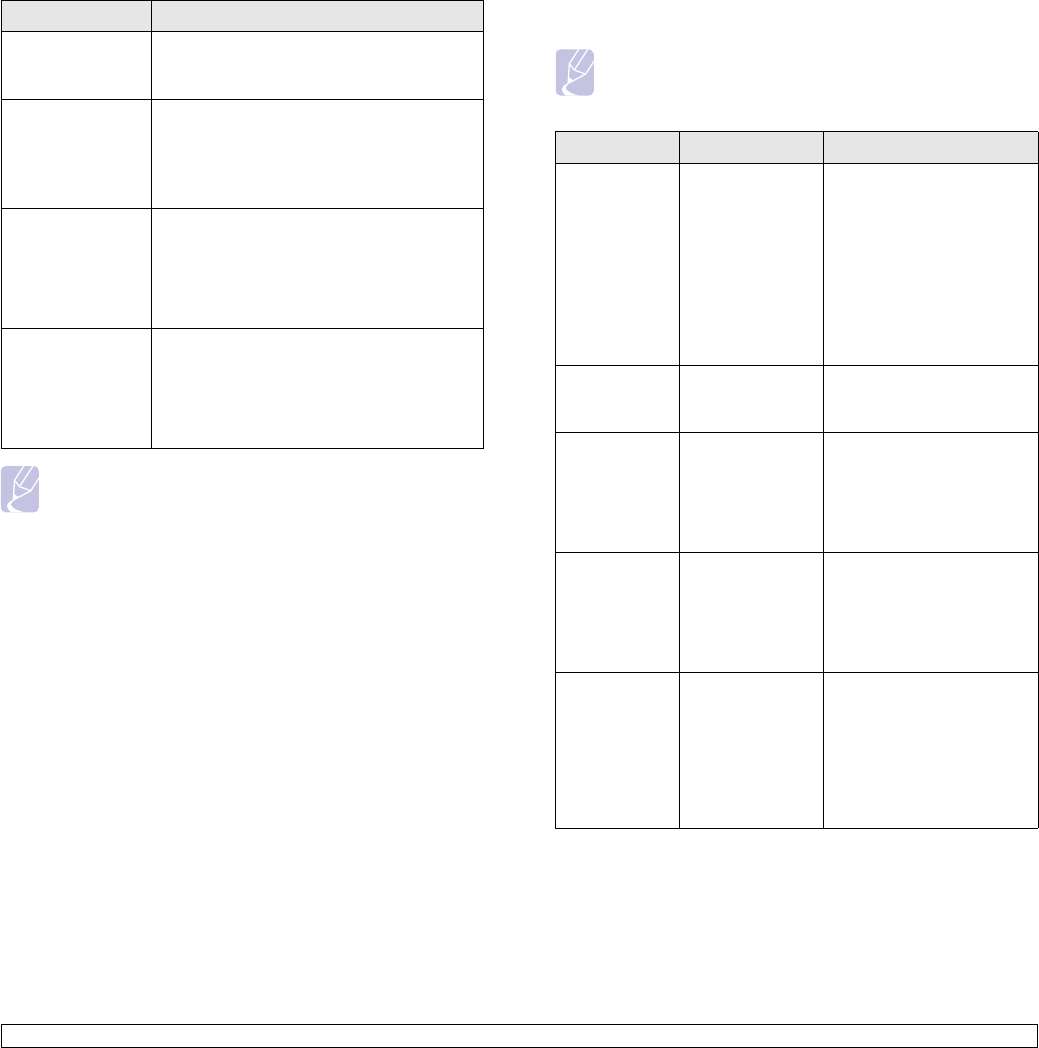
10.20 <
Troubleshooting>
Common Windows problems
Note
Refer to Microsoft Windows 98/Me/NT 4.0/2000/XP User’s
Guide that came with your PC for further information on
Windows error messages.
Condition Suggested solutions
“File in Use”
message appears
during installation.
Exit all software applications. Remove all
software from the StartUp Group, then restart
Windows. Reinstall the printer driver.
“Error Writing to
LPTx” message
appears.
• Ensure that the cables are connected
correctly, the machine is on.
• If bi-directional communication is not turned
on in the driver, it will also cause this
message.
“General
Protection Fault”,
“Exception OE”,
“Spool32”, or
“Illegal Operation”
messages appear.
Close all other applications, reboot Windows
and try printing again.
“Fail To Print”, “A
printer timeout
error occurred.”
messages appear.
These messages may appear during printing.
Just keep waiting until the machine finishes
printing. If the message appears in standby
mode or after printing has been completed,
check the connection and/or whether an error
has occurred.
Common PostScript problems
The following situations are PS language specific and may occur when
several printer languages are being used.
Note
To receive a printed or screen-displayed message when
PostScript errors occur, open the Print Options window and click
the desired selection next to the PostScript errors section.
Problem Possible Cause Solution
PostScript file
cannot be
printed.
The PostScript
driver may not be
installed correctly.
• Install the PostScript
driver, referring to the
Software Section
.
• Print a configuration page
and verify that the PS
version is available for
printing.
• If the problem persists,
contact a service
representative.
“Limit Check
Error” message
appears.
The print job was
too complex.
You might need to reduce
the complexity of the page or
install more memory.
A PostScript
error page
prints.
The print job may
not be PostScript.
Make sure that the print job
is a PostScript job. Check to
see whether the software
application expected a setup
or PostScript header file to
be sent to the machine.
The optional
tray 2 is not
selected in the
driver.
The printer driver
has not been
configured to
recognize the
optional tray 2.
Open the PostScript driver
properties, select the Device
Settings tab, and set the
Tray2 option of the
Installable Options section
to Installed.
When print a
document in
Macintosh with
Acrobat
Reader 6.0 or
higher, colors
print
incorrectly.
The resolution
setting in the
printer driver may
not be matched
with that in
Acrobat Reader.
Make sure that the resolution
setting in your printer driver
matches that in Acrobat
Reader.
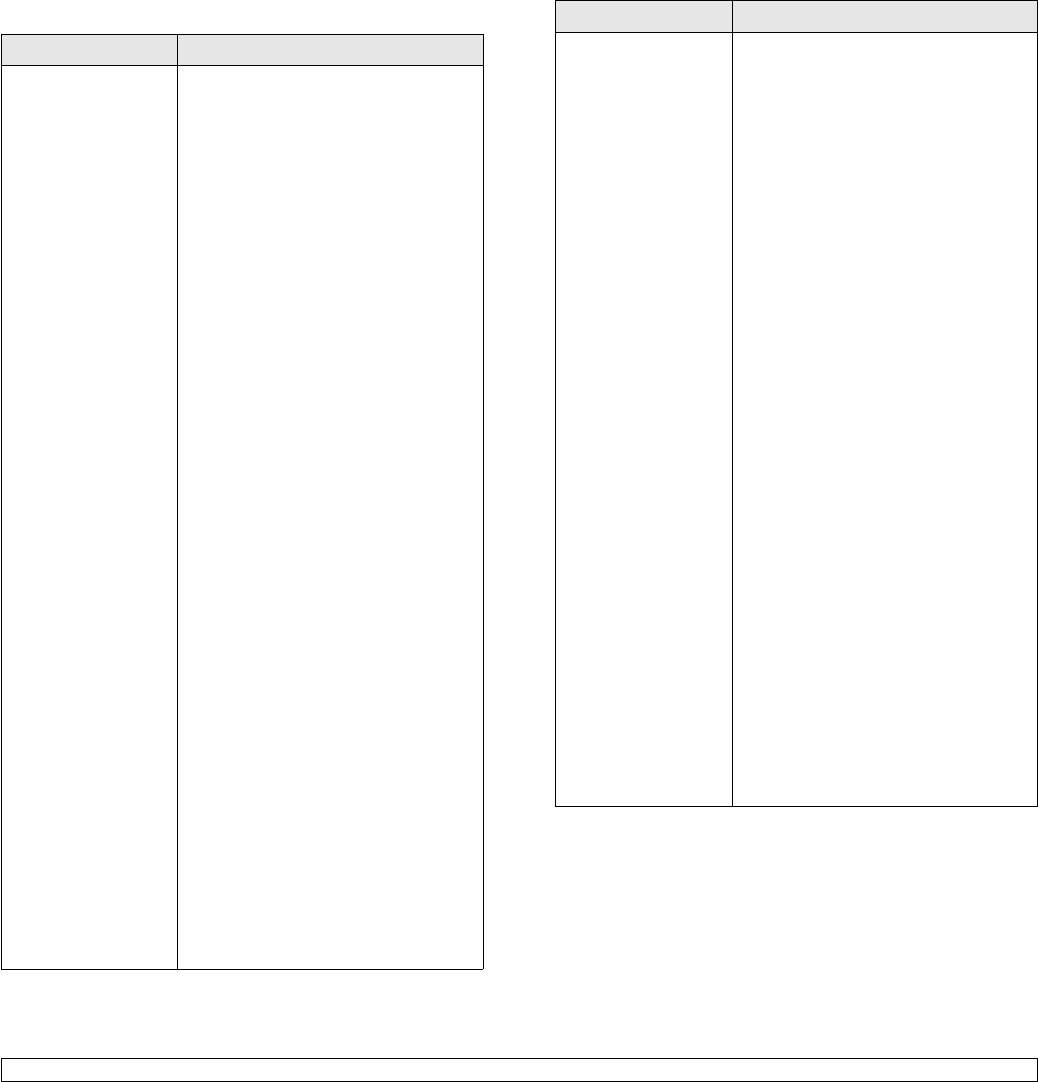
10.21 <
Troubleshooting>
Common Linux problems
Problem Possible Cause and Solution
The machine does not
print
• Check if the printer driver is installed in
your system. Open Unified Driver
configurator and switch to the Printers
tab in Printers configuration window to
look at the list of available printers. Make
sure that your machine is displayed on
the list. If not, please, invoke Add new
printer wizard to set up your device.
• Check if the printer is started. Open
Printers configuration and select your
machine on the printers list. Look at the
description in the Selected printer pane.
If its status contains “(stopped)” string,
please, press the Start button. After that
normal operation of the printer should be
restored. The “stopped” status might be
activated when some problems in
printing occurred. For instance, this
could be an attempt to print document
when port is claimed by a scanning
application.
• Check if the port is not busy. Since
functional components of MFP (printer
and scanner) share the same I/O
interface (port), the situation of
simultaneous access of different
“consumer” application to the same port
is possible. To avoid possible conflicts,
only one of them at a time is allowed to
gain control over the device. The other
“consumer” will encounter “device busy”
response. You should open ports
configuration and select the port
assigned to your printer. In the Selected
port pane you can see if the port is
occupied by some other application. If
this is the case, you should wait for
completion of the current job or should
press Release port button, if you are
sure that the present owner is not
functioning properly.
• Check if your application has special
print option such as “-oraw”. If “-oraw” is
specified in the command line parameter
then remove it to print properly. For
Gimp front-end, select “print” -> “Setup
printer” and edit command line
parameter in the command item.
The machine does not
appear on the
scanners list
• Check if your machine is attached to
your computer. Make sure that it is
connected properly via the USB port and
is turned on.
• Check if the scanner driver for your
machine is installed in your system.
Open Unified Driver configurator, switch
to Scanners configuration, then press
Drivers. Make sure that driver with a
name corresponding to your machine's
name is listed in the window. Check if
the port is not busy. Since functional
components of MFP (printer and
scanner) share the same I/O interface
(port), the situation of simultaneous
access of different “consumer”
application to the same port is possible.
To avoid possible conflicts, only one of
them at a time is allowed to gain control
over the device. The other “consumer”
will encounter “device busy” response.
This can usually happen while starting
scan procedure, and appropriate
message box appears.
• To identify the source of the problem,
you should open ports configuration and
select the port assigned to your scanner.
port's symbol /dev/mfp0 corresponds to
LP:0 designation displayed in the
scanners’ options, /dev/mfp1 relates to
LP:1 and so on. USB ports start at /dev/
mfp4, so scanner on USB:0 relates to /
dev/mfp4 respectively and so forth
sequentially. In the Selected port pane
you can see if the port is occupied by
some other application. If this is the
case, you should wait for completion of
the current job or should press Release
port button, if you are sure that the
present port's owner is not functioning
properly.
Problem Possible Cause and Solution
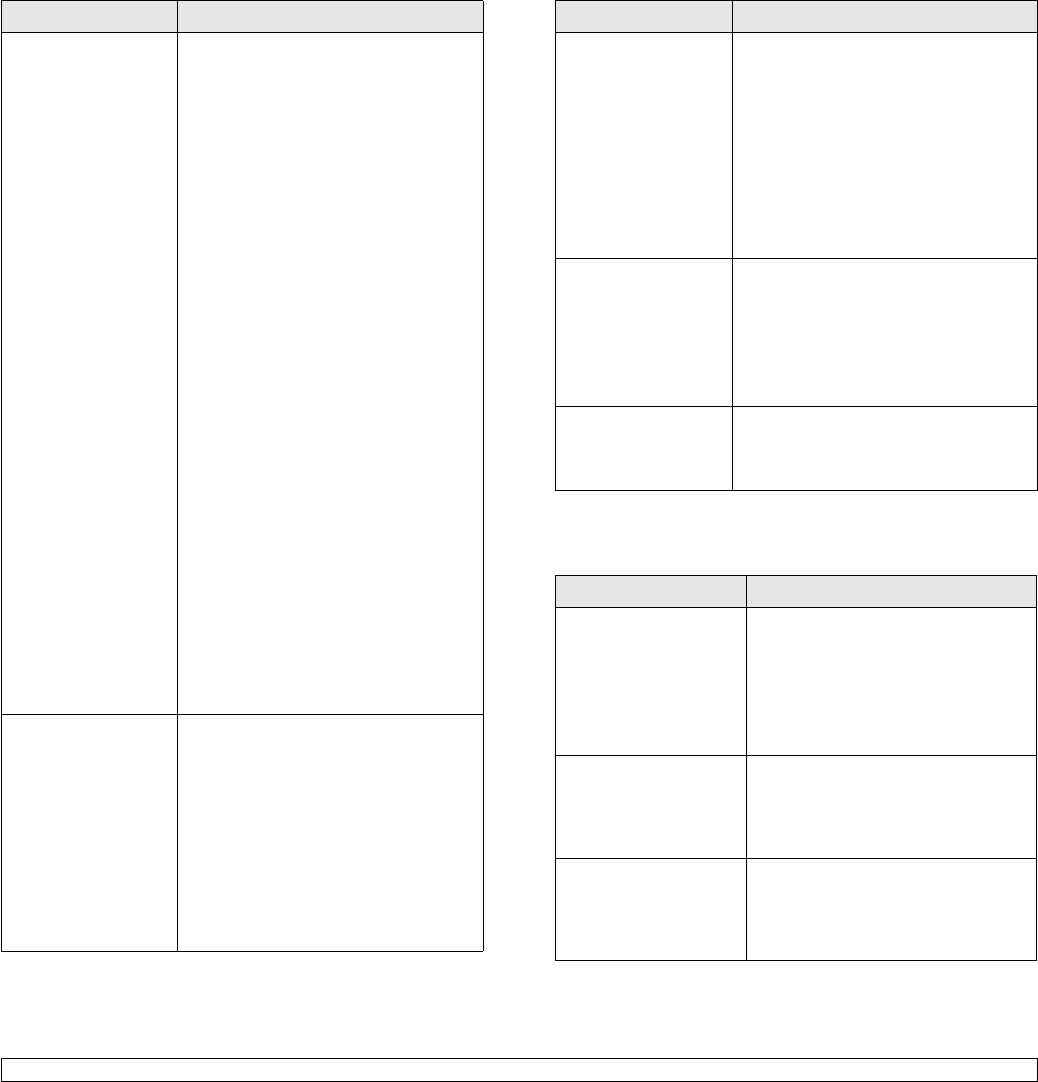
10.22 <
Troubleshooting>
The machine does not
scan
• Check if a document is loaded into the
machine.
• Check if your machine is connected to
the computer. Make sure if it is
connected properly if I/O error is
reported while scanning.
• Check if the port is not busy. Since
functional components of MFP (printer
and scanner) share the same I/O
interface (port), the situation of
simultaneous access of different
“consumer” application to the same port
is possible. To avoid possible conflicts,
only one of them at a time is allowed to
gain control over the device. The other
“consumer” will encounter “device busy”
response. This can usually happen while
starting scan procedure, and appropriate
message box will be displayed.
To identify the source of the problem,
you should open ports configuration and
select the port assigned to your scanner.
port’s symbol /dev/mfp0 corresponds to
LP:0 designation displayed in the
scanners’ options, /dev/mfp1 relates to
LP:1 and so on. USB ports start at /dev/
mfp4, so scanner on USB:0 relates to /
dev/mfp4 respectively and so forth
sequentially. In the Selected port pane
you can see if the port is occupied by
some other application. If this is the
case, you should wait for completion of
the current job or should press Release
port button, if you are sure that the
present port’s owner is not functioning
properly.
I cannot scan via Gimp
Front-end.
• Check if Gimp Front-end has
“Xsane: Device dialog.” on the “Acquire”
menu. If not, you should install Xsane
plug-in for Gimp on the your computer.
You can find Xsane plug-in package for
Gimp on Linux distribution CD or Gimp
home page. For the detail information,
refer to the Help for Linux distribution CD
or Gimp Front-end application.
If you wish to use other kind of scan
application, refer to the Help for
application.
Problem Possible Cause and Solution
Common Macintosh problems
I encounter error
“Cannot open port
device file” when
printing a document.
Please avoid changing print job
parameters (via LPR GUI, for example)
while a print job is in progress. Known
versions of CUPS server break the print
job whenever print options are changed
and then try to restart the job from the
beginning. Since Unified Linux Driver locks
port while printing, the abrupt termination
of the driver keeps the port locked and
therefore unavailable for subsequent print
jobs. If this situation occurred, please, try
to release the port.
PDF file does not print
correctly-some parts
are missing in
graphics, text or
illustrations.
Incompatibility between the PDF file and
the Acrobat products.
Printing the PDF file as an image may
enable the file to print. Turn on Print As
Image from the Acrobat printing options.
Note: It Will take longer to print when you
print a PDF file as an image.
The machine does not
print.
The CUPS (Common Unix Printing
System) version distributed with SuSE
Linux 9.2 (cups-1.1.21) has a problem with
ipp (Internet Printing Protocol) printing.
Problem Suggested solutions
PDF file does not print
correctly-some parts are
missing in graphics, text
or illustrations.
Incompatibility between the PDF file and
the Acrobat products.
Printing the PDF file as an image may
enable the file to print. Turn on Print As
Image from the Acrobat printing options.
Note: It Will take longer to print when
you print a PDF file as an image.
The document has
printed, but the print job
has not disappeared from
the spooler in
Mac OS 10.3.2.
Update your Mac OS to OS 10.3.3. or
higher.
Some letters are not
displayed normally
during the Cover page
printing.
This problem is caused because Mac
OS can not create the font during the
Cover page printing. English alphabet
and numbers are displayed normally at
the Cover page.
Problem Possible Cause and Solution
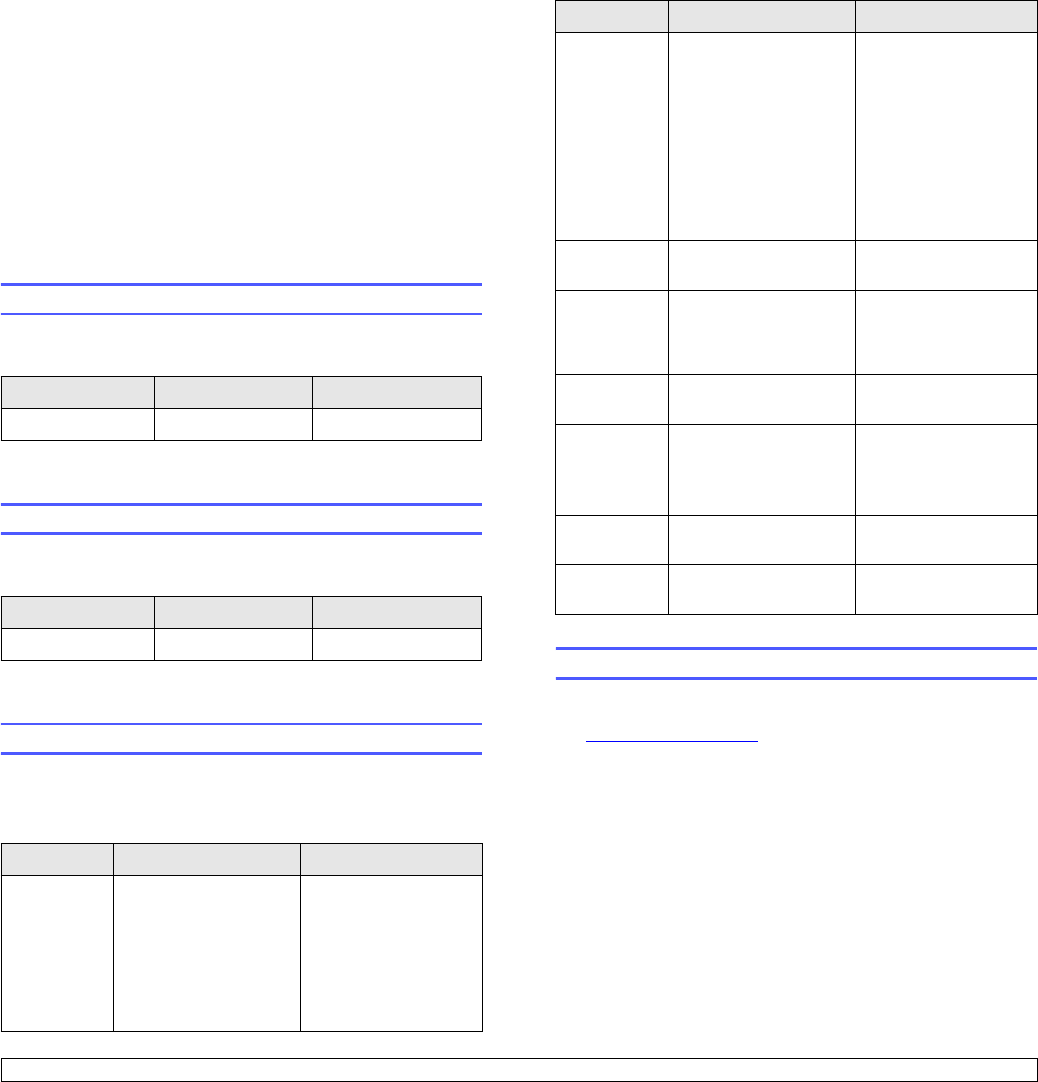
11.1 <
Ordering supplies and accesso-
11 Ordering supplies and
accessories
This chapter provides information on purchasing toner cartridges and
accessories available for your machine.
This chapter includes:
• Toner cartridge
• Drum cartridge
• Accessories
• How to purchase
Toner cartridge
When the toner runs out, you can order the following type of toner
cartridge for your machine:
Drum cartridge
When the drum runs out, you can order the following type of drum
cartridge for your machine:
Accessories
You can purchase and install accessories to enhance your machine’s
performance and capacity.
The following accessories are available for your machine:
Type Yielda
a. ISO 19752 5% coverage
Part number
Standard yield 20,000 pages SCX-D6345A
Type Yielda
a. ISO 19752 5% coverage
Part number
Standard yield 60,000 pages SCX-R6345A
Accessory Description Part number
Optional tray
2/3/4
If you are experiencing
frequent paper supply
problems, you can
attach an additional 550
sheet tray. You can print
documents on various
sizes and types of print
materials.
SCX-S6345A
How to purchase
To order Samsung-authorized supplies or accessories, contact your local
Samsung dealer or the retailer where you purchased your machine, or
visit www.samsungprinter.com and select your country/region for
information on calling for technical support.
Paper Stand You can place the
machine on the cabinet
in ergonomic design
which lets you reach the
machine conveniently.
Also you can easily
move the cabinet with its
wheels in case of need
and store miscellaneous
stuffs like papers into the
cabinet.
• Tall Stand: SCX-
DSK10T
• Short Stand: SCX-
DSK10S
Stacker &
Stapler
550 sheets SCX-FIN105
Finishing
Cartridge
3,000 staples per
cartridge, 20 sheets
maximun, 1staple
position
SCX-STP000
Memory
DIMM
Extends your machine’s
memory capacity.
ML-MEM140: 256 MB
Fax option kit • Serial Type: SCX-
FAX100
• Parallel Type: SCX-
FAX101
Network
Scan kit
SCX-KIT10S
SmarThru
Worfflow
Windows 2000/XP/2003 SCX-KIT11S
Accessory Description Part number

12.1 <
Installing accessories>
12 Installing accessories
Your machine is a full-featured one that has been optimized to meet most
of your printing needs. Recognizing that each user may have different
requirements, however, Samsung makes several accessories available
to enhance your machine’s capabilities.
This chapter includes:
• Precautions when installing accessories
• Installing a memory DIMM
Precautions when installing accessories
Disconnect the power cord
Never remove the control board cover while the power is being supplied.
To avoid the possibility of an electrical shock, always disconnect the
power cord when installing or removing ANY internal or external
accessories.
Discharge static electricity
The control board and internal accessories (network interface card or
memory DIMM) are sensitive to static electricity. Before installing or
removing an internal accessories, discharge static electricity from your
body by touching something metal, such as the metal back plate on any
device plugged into a grounded power source. If you walk round before
finishing installation, discharge any static electricity once again.
Installing a memory DIMM
Your machine has a dual in-line memory module (DIMM) slot. Use this
DIMM slot to install additional memory.
Your machine has 256 MB of memory. Both can be expanded to 256 MB.
However, users must remove the preinstalled memory DIMM before
upgrading the memory.
For order information for optional memory DIMMs, see page 11.1.
1Turn the machine off and unplug all cables from the machine.
2Grasp the control board cover and slide toward you to open it.
3Completely open the latch on each side of the DIMM slot. Remove
the preinstalled memory DIMM.
4Take out a new memory DIMM from the plastic bag.
5Holding the memory DIMM by the edges, align the notches on the
memory DIMM with the grooves on the memory DIMM slot.
Note
The notches and grooves illustrated above may not match
those on an actual DIMM and the slot.
1control board cover
1
1latch
2memory DIMM
1
2
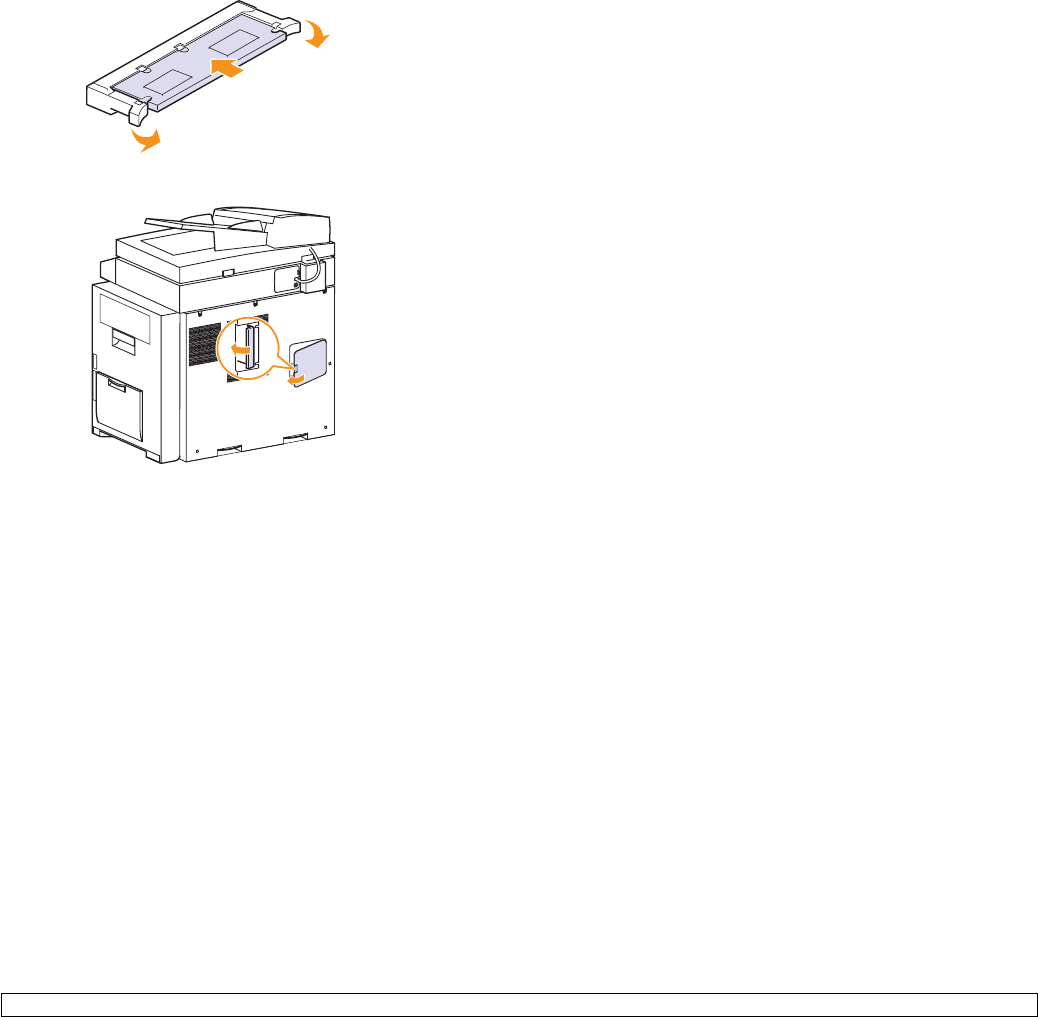
12.2 <
Installing accessories>
6Push the DIMM straight into the DIMM slot until it snaps into place.
Make sure the latches fit over the notches located on either side of
the DIMM.
7Replace the control board cover.
8Reconnect the power cord and printer cable, and turn the machine
on.
Activating the added memory in the PS printer
properties
After installing the memory DIMM, you need to select it in the printer
properties of the PostScript printer driver so that you can use it.
1Make sure that the PostScript printer driver is installed on your
computer. For details about installing the PS printer driver, see the
Software Section.
2Click the Windows Start menu.
3For Windows 98/Me/NT 4.0/2000, select Settings and then
Printers.
For Windows XP/2003, select Printers and Faxes.
4Select the Samsung SCX-6x45 Series PS printer.
5Click the right mouse button on the machine icon and select
Properties.
6For Windows 98/Me, select Device Options.
For Windows NT 4.0/2000/XP/2003, select Device Settings.
7Select the amount of memory you installed from Printer Memory in
the Installable Options section.
For Windows 98, select Installable Options > VMOption > change
setting for:VMOption > change memory.
8Click OK.

13.1 <
Specifications>
13 Specifications
This chapter includes:
• General specifications
• Printer specifications
• Copier specifications
• Scanner specifications
• Facsimile specifications (optional)
General specifications
Item Description
DADF Up to 50 sheets (75 g/m2 bond)
DADF document size Width:174 to 216 mm
Length: 128 to 356 mm for single page scan
128 to 356 mm for multi pages scan
Paper input capacity • Tray 1: 520 multi-pages for plain paper
(75 g/m2 bond), 30 pages for
transparencies, labels, card stock, and
envelopes (60 to 90 g/m2 bond)
• Multi-purpose tray: 100 multi-pages for
plain paper (75 g/m2 bond), 10 pages for
transparencies, labels, card stock, and
envelopes (60 to 90 g/m2 bond)
• optional tray 2/3/4: 550 multi-pages for
plain paper (75 g/m2 bond), 30 pages for
transparencies, labels, and card stock
Paper output
capacity
• 500 sheet (face down)
• 500 sheet (optional stacker)
Consumables 2-piece toner/drum cartridge system
Power rating 110 - 127 VAC, 50/60 Hz, 9 A or
220 - 240 VAC, 50/60 Hz, 4.5 A
Power consumption Average operation mode: Less than 900 W
Power save mode: Less than 50 W
Stand by mode: Less than 170 W
Noise levelaStandby mode: Less than 43 dBA
Printing mode: Less than 60 dBA
Copying mode: Less than 62 dBA
Warm-up time Less than 30 seconds (from sleep mode)
Operating
environment
Temperature: 10 °C to 32 °C
Humidity: 20% to 80% RH
Printer specifications
Display 1/2 VGA (640 x 240)
Toner cartridge lifeb20,000 pages at ISO 19752 5% coverage
Drum cartridge lifeb60,000 pages at ISO 19752 5% coverage
Memory 256 MB (max. 384 MB)
External dimension
(W x D x H)
606 x 443 x 610mm (without tray 2/3/4), 22 x
17x 19.5 inches
Weight 45 Kg (including consumables)
Package weight Paper: 2.8 Kg, Plastic: 0.7 Kg
Duty cycle Monthly print: Up to 100,000 pages
a. Sound Pressure Level, ISO 7779
b. The number of pages may be affected by operating environment, printing
interval, media type, and media size.
Item Description
Printing method Laser Beam Printing
Printing speeda
a. Print speed will be affected by operating system used, computing performance,
application software, connecting method, media type, media size, and job
complexity.
Up to 43 ppm in A4 (45 ppm in Letter)
Duplex printing
speed
Up to 41 ipm in A4 (42.7 ipm in Letter)
First print out time 8 seconds (from ready)
Print resolution Up to 600 x 600 dpi
Printer language PCL 6, PS 3
OS Compatibilityb
b. Please visit www.samsungprinter.com to download the latest software version.
• PCL Driver: Windows 98/Me/NT 4.0/2000/
XP/2003
• PS Driver: Windows 98/Me/NT 4.0/2000/
XP/2003, Various Linux OS (USB only),
Macintosh 8.6 ~ 9.2/10.1 ~ 10.4
Interface High Speed USB 2.0
Ethernet 10/100 Base TX
Item Description
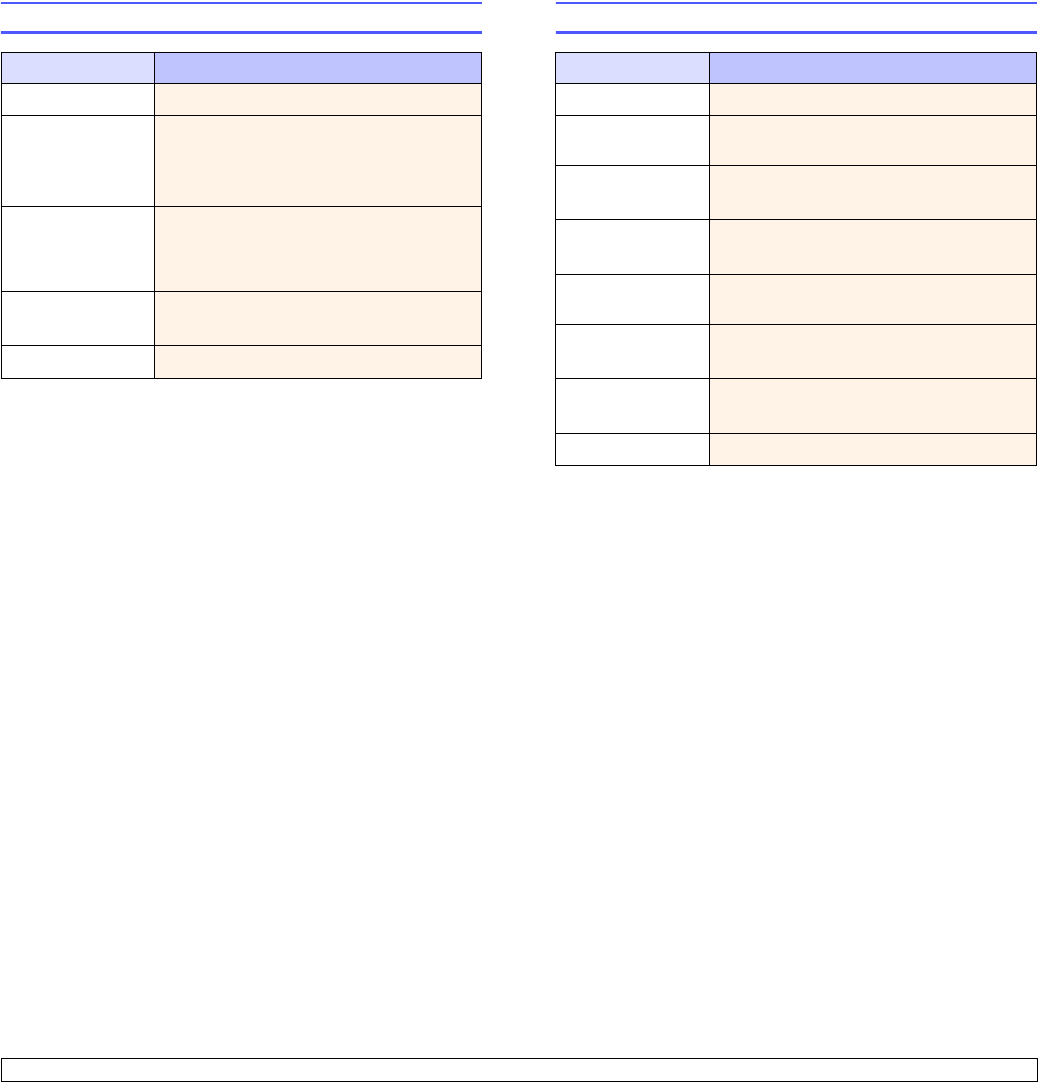
13.2 <
Specifications>
Copier specifications
Item Description
Copy speeda
a. Copy Speed is based on Single Document Multiple Copy.
Up to 43 ppm in A4 (45 cpm in Letter)
Duplex Copy speed • Simplex to Duplex(1-2): Approx. 41 ipmb in
A4 (43 ipm in Letter)
• Duplex to Duplex(2-2): 14 ipm in A4
(17 ipm in Letter)
b. images per minute
Copy resolution Scan: up to 600 x 300 (text, text/photo)
up to 600 x 600 (photo using platen)
up to 600 x 300 (photo using DADF)
Print: up to 600 x 600 (text, text/photo, photo)
Zoom rate Scanner glass: 25 to 200%
DADF: 25 to 100%
Multiple copies 1 to 999 pages
Scanner specifications
Item Description
Compatibility TWAIN standard / WIA standard
Scanning method DADF and Flat-bed Color CCD (Charge
Coupled Device) module
Resolution Optical: 600 x 600 dpi (mono and color)
Enhanced: 4,800 x 4,800 dpi
Effective scanning
length
Scanner glass: 348 mm
DADF: 348 mm
Effective scanning
width
Max 208 mm
Color bit depth Internal: 36 bit
External: 24 bit
Mono bit depth 1 bit for Black & White mode
8 bit for Gray mode
Grayscale 256 levels
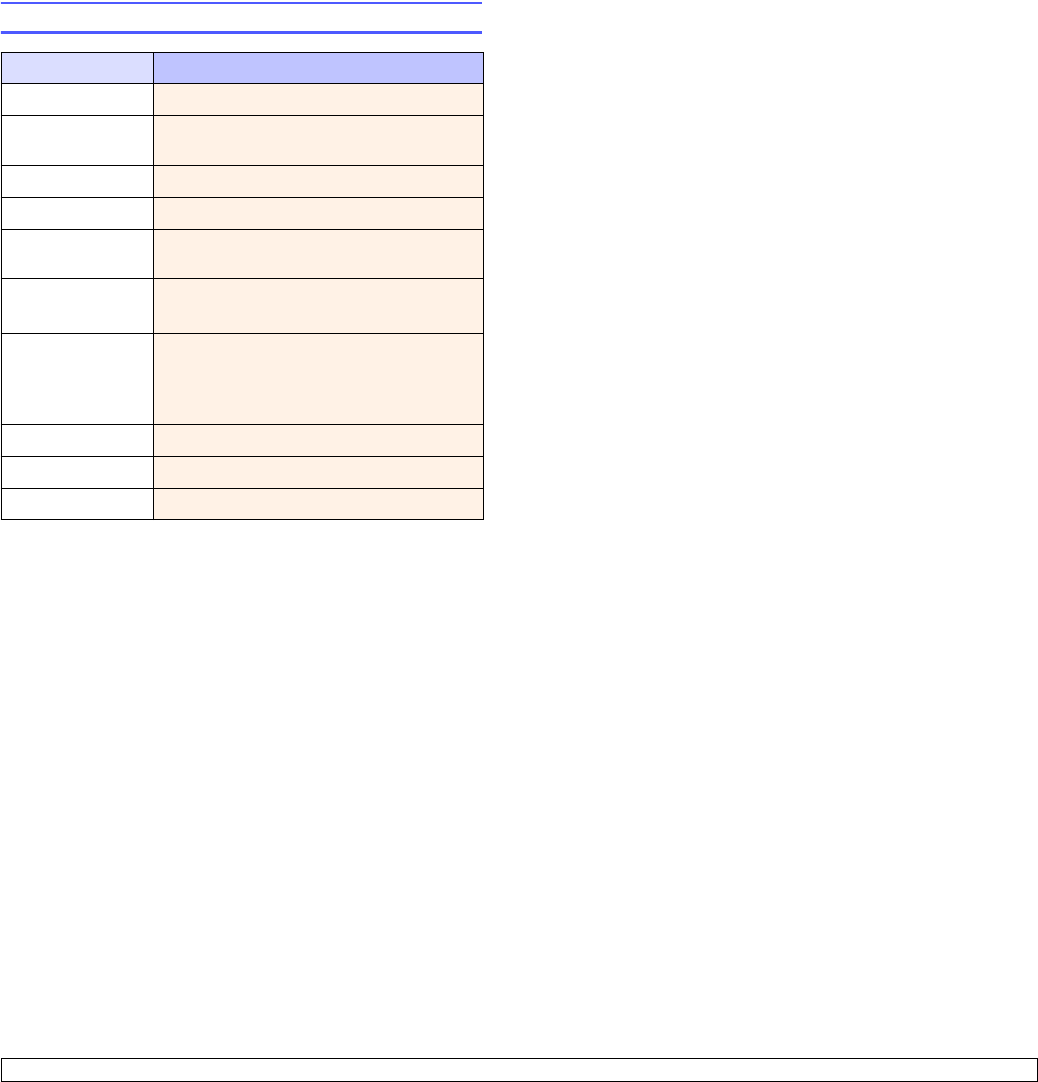
13.3 <
Specifications>
Facsimile specifications (optional)
Item Description
Compatibility ITU-T Group 3
Applicable line Public Switched Telephone Network (PSTN)
or behind PABX
Data coding MH/MR/MMR/JBIG/JPEG (Tx only)
Modem speed 33.6 Kbps
Transmission
speed
Approx. 3 seconds/pagea
a. Transmission time applies to memory transmission of text data with ECM
compression using only ITU-T No.1 Chart.
Maximum
document length
Scanner glass: 356 mm
Duplex automatic document glass: 356 mm
Resolution • Standard: 203 x 98 dpi
• Fine: 203 x 196 dpi
• Super Fine: 300 x 300 dpi, 406 x 392 dpi,
203 x 392 dpi (Rx only)
Memory 16 MB
Halftone 256 levels
Auto dialer up to 200 numbers

1
INDEX
A
accessories
installing
memory DIMM 12.1
order information 11.1
Address Book, use 6.7
ADF, load 3.1
C
cleaning
drum 9.6
inside 9.2
outside 9.2
scan unit 9.2
component location 1.2
control panel 1.3
D
DADF 1.2
DADF, load 3.1
DIMM, install 12.1
drum cartridge
replacing 9.5
drum, clean 9.6
E
error messages 10.8
I
installing accessories
memory 12.1
J
jam, clear
document 10.1
paper 10.2
L
Linux problems 10.21
loading originals
ADF 3.1
DADF 3.1
scanner glass 3.1
loading paper
multi-purpose tray 3.6
tray 1/optional tray2 3.5
M
Macintosh problems 10.22
memory DIMM, install 12.1
memory, clear 9.1
multi-purpose tray 3.6
N
network scan
scanning 6.5
timeout, set 6.5
Network Scan program
adding scanners 6.3
problems 10.19
network setup
operating systems 2.3
new toner notification, send 9.7
O
originals
jam, clear 10.1
loading 3.1
P
paper guidelines 3.4
paper jam, clear
duplex area 10.7
fuser area or around toner cartridge
10.5
multi-purpose tray 10.4
,
10.7
optional tray 2 10.3
paper exit area 10.5
tray 1 10.2
paper load
multi-purpose tray 3.6
tray 1/optional tray 2 3.5
paper size
setting 3.8
specifications 3.3
paper type
setting 3.8
specifications 3.3
PostScript problems 10.20
print quality problems, solve 10.15
printing
reports 9.1
problem, solve
copying 10.17
error messages 10.8
faxing 10.19
Linux 10.21
Macintosh 10.22
Network Scan 10.19
paper feeding 10.13
PostScript errors 10.20
printing 10.14
printing quality 10.15
scanning 10.18
Windows 10.20
R
receiving a fax
in the memory 6.9
replacement parts 9.8
replacing
drum cartridge 9.5
toner cartridge 9.4
replacing, toner cartridge 9.7
reports, print 9.1
S
scanner glass

2
cleaning 9.2
loading documents 3.1
scanning
default setting, change 6.7
scan settings 6.6
to application 6.3
to email 6.5
to FTP server 6.6
to network computer 6.5
to SMB server 6.6
special print media, guidelines 3.4
specifications
copier 13.2
facsimile 13.3
general 13.1
paper 3.3
printer 13.1
scanner 13.2
supplies
checking life 9.7
order information 11.1
T
toner cartridge
checking remaining toner 9.7
cleaning 9.6
maintaining 9.3
redistributing 9.3
replacing 9.4
W
Windows problems 10.20

Rev. 0.01
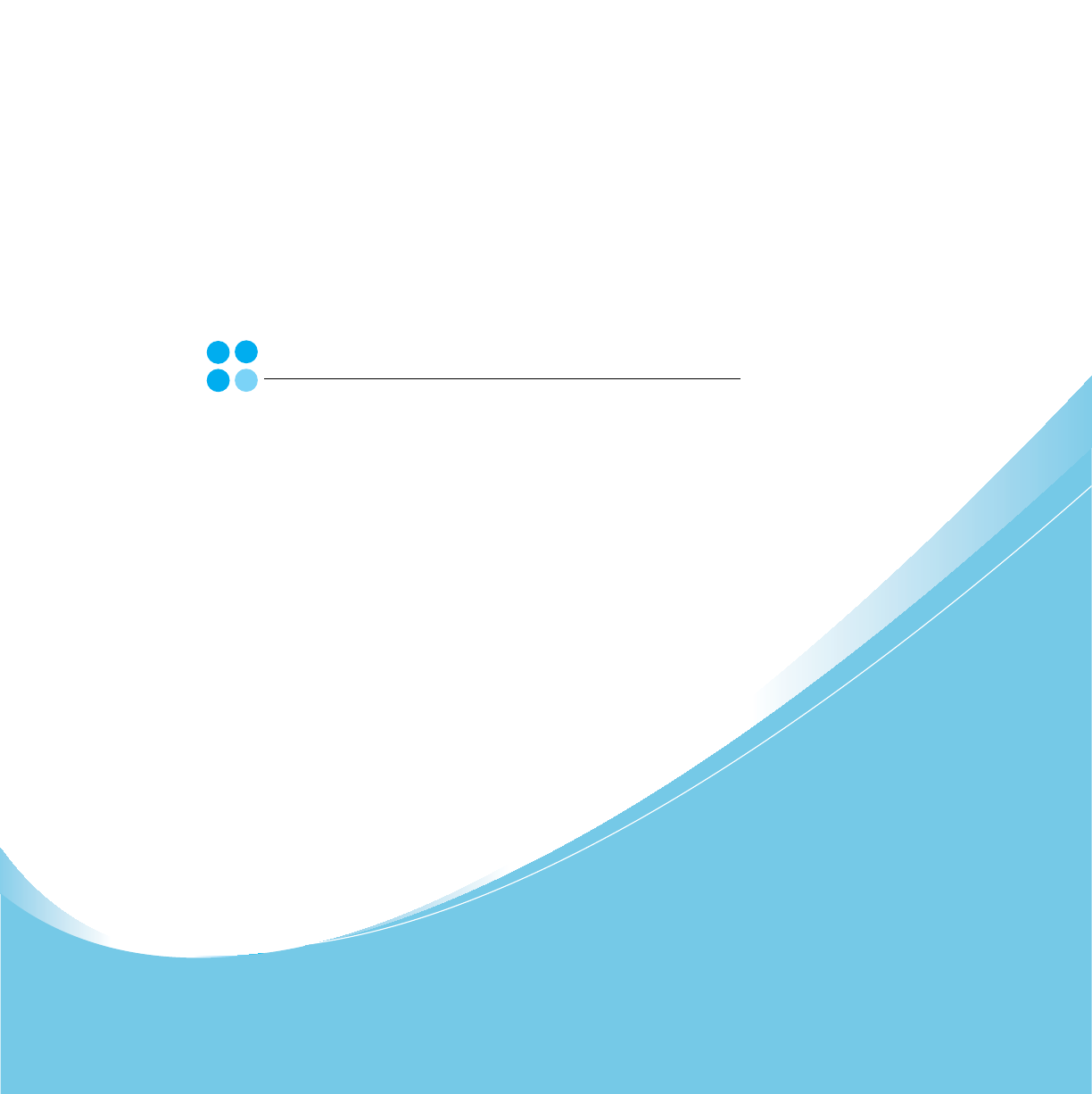
Samsung Printer
Software section
1
SOFTWARE SECTION
CONTENTS
Chapter 1:
INSTALLING PRINTER SOFTWARE IN WINDOWS
Installing Printer Software ........................................................................................................ 4
Installing Software for Local Printing ................................................................................. 4
Installing Software for Network Printing ............................................................................. 7
Reinstalling Printer Software ................................................................................................... 10
Removing Printer Software ..................................................................................................... 11
Chapter 2:
BASIC PRINTING
Printing a Document .............................................................................................................. 12
Printing to a file (PRN) .......................................................................................................... 12
Printer Settings ..................................................................................................................... 13
Layout Tab .................................................................................................................. 13
Paper Tab .................................................................................................................... 14
Graphics Tab ............................................................................................................... 15
Extras Tab ................................................................................................................... 16
About Tab ................................................................................................................... 16
Printer Tab .................................................................................................................. 16
Using a Favorite Setting ................................................................................................ 17
Using Help ................................................................................................................... 17
Chapter 3:
ADVANCED PRINTING
Printing Multiple Pages on One Sheet of Paper (N-Up Printing) ..................................................... 18
Printing Posters ..................................................................................................................... 19
Printing Booklets .................................................................................................................. 19
Printing on Both Sides of Paper ............................................................................................... 20
Printing a Reduced or Enlarged Document ................................................................................ 20
Fitting Your Document to a Selected Paper Size ......................................................................... 20
Using Watermarks ................................................................................................................. 21
Using an Existing Watermark ......................................................................................... 21
2
Creating a Watermark ................................................................................................... 21
Editing a Watermark ..................................................................................................... 21
Deleting a Watermark ................................................................................................... 21
Using Overlays ...................................................................................................................... 22
What is an Overlay? ...................................................................................................... 22
Creating a New Page Overlay ......................................................................................... 22
Using a Page Overlay .................................................................................................... 22
Deleting a Page Overlay ................................................................................................ 22
Chapter 4:
USING WINDOWS POSTSCRIPT DRIVER
Printer Settings ..................................................................................................................... 23
Advanced .................................................................................................................... 23
Using Help ................................................................................................................... 23
Chapter 5:
SHARING THE PRINTER LOCALLY
Setting Up a Host Computer ................................................................................................... 24
Setting Up a Client Computer .................................................................................................. 24
Chapter 6:
USING SMART PANEL
Understanding Smart Panel .................................................................................................... 25
Opening the Troubleshooting Guide ......................................................................................... 26
Using Printer Settings Utility ................................................................................................... 26
Using Onscreen Help File ............................................................................................... 26
Changing the Smart Panel Program Settings ............................................................................. 26
Chapter 7:
SCANNING
Scanning Using Samsung SmarThru Office ................................................................................ 27
Using Samsung SmarThru Office .................................................................................... 27
Uninstalling Samsung SmarThru Office ............................................................................ 29
Using Onscreen Help File ............................................................................................... 29
Scanning Process with TWAIN-enabled Software ........................................................................ 29
Scanning Using the WIA ......................................................................................................... 29
3
Chapter 8:
USING YOUR PRINTER IN LINUX
Getting Started ..................................................................................................................... 30
Installing the Unified Linux Driver ............................................................................................ 30
Installing the Unified Linux Driver ................................................................................... 30
Uninstalling the Unified Linux Driver ............................................................................... 31
Using the Unified Driver Configurator ....................................................................................... 32
Opening the Unified Driver Configurator .......................................................................... 32
Printers Configuration ................................................................................................... 32
Scanners Configuration ................................................................................................. 33
Ports Configuration ....................................................................................................... 33
Configuring Printer Properties ................................................................................................. 34
Printing a Document .............................................................................................................. 34
Printing from Applications .............................................................................................. 34
Printing Files ................................................................................................................ 35
Scanning a Document ............................................................................................................ 35
Using the Image Manager .............................................................................................. 36
Chapter 9:
USING YOUR PRINTER WITH A MACINTOSH
Installing Software for Macintosh ............................................................................................. 38
Setting Up the Printer ............................................................................................................ 39
For a Network-connected Macintosh ................................................................................ 39
For a USB-connected Macintosh ..................................................................................... 39
Printing ................................................................................................................................ 40
Printing a Document ..................................................................................................... 40
Changing Printer Settings .............................................................................................. 40
Printing Multiple Pages on One Sheet of Paper .................................................................. 41
Duplex Printing ............................................................................................................ 42
Scanning .............................................................................................................................. 42

Installing Printer Software in Windows
4
1Installing Printer
Software in Windows
This chapter includes:
• Installing Printer Software
• Reinstalling Printer Software
•Removing Printer Software
Installing Printer Software
You can install the printer software for local printing or network
printing. To install the printer software on the computer,
perform the appropriate installation procedure depending on
the printer in use.
A printer driver is software that lets your computer
communicate with your printer. The procedure to install drivers
may differ depending on the operating system you are using.
All applications should be closed on your PC before beginning
installation.
Installing Software for Local Printing
A local printer is a printer directly attached to your computer
using the printer cable supplied with your printer, such as a USB
or parallel cable. If your printer is attached to a network, skip
this step and go to “Installing Software for Network Printing” on
page 7.
You can install the printer software using the typical or custom
method.
NOTE
: If the “New Hardware Wizard” window appears during
the installation procedure, click in the upper right corner of
the box to close the window, or click
Cancel
.
Typical Installation
This is recommended for most users. All components necessary
for printer operations will be installed.
1
Make sure that the printer is connected to your computer
and powered on.
2
Insert the supplied CD-ROM into your CD-ROM drive.
The CD-ROM should automatically run, and an installation
window appears.
If the installation window does not appear, click
Start
and
then
Run
. Type
X:\Setup.exe
, replacing “
X
” with the
letter which represents your drive and click
OK
.
3
Click
Next
.
• If necessary, select a language from the drop-down list.
•
View User’s Guide
: Allows you to view the User’s
Guide. If your computer doesn’t have Adobe Acrobat,
click on this option and it will automatically install Adobe
Acrobat Reader for you.
4
Select
Typical installation for a local printer
. Click
Next
.
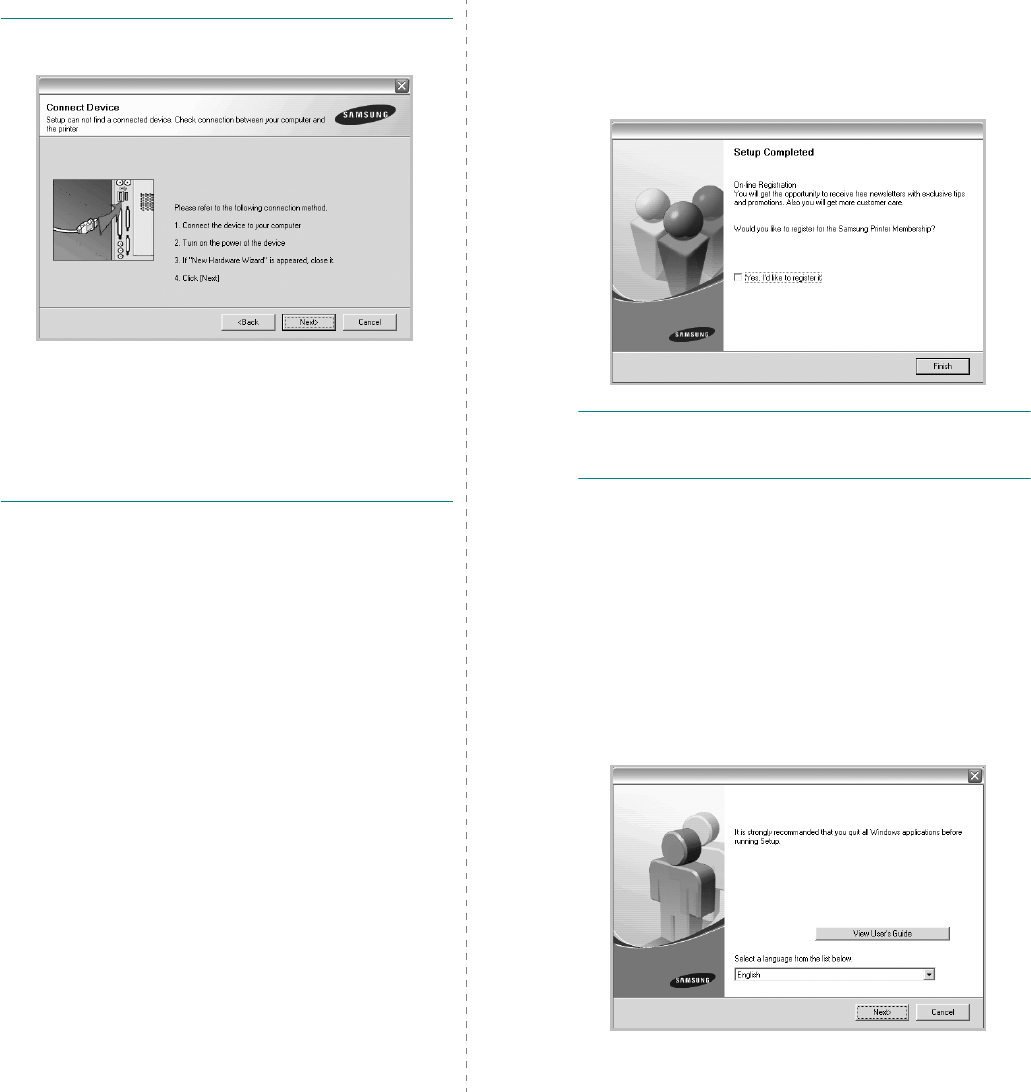
Installing Printer Software in Windows
5
NOTE
: If your printer is not already connected to the
computer, the following window will appear.
• After connecting the printer, click
Next
.
• If you don’t want to connect the printer at this time, click
Next
, and
No
on the following screen. Then the installation
will start and a test page will not be printed at the end of the
installation.
• The installation window that appears in this User’s
Guide may differ depending on the printer and
interface in use.
5
After the installation is finished, a window asking you to
print a test page appears. If you choose to print a test
page, select the checkbox and click
Next
.
Otherwise, just click
Next
and skip to step 7.
6
If the test page prints out correctly, click
Yes
.
If not, click
No
to reprint it.
7
To register yourself as a user of Samsung Printers in order
to receive information from Samsung, select the checkbox
and click
Finish
. You are now sent to the Samsung web
site.
Otherwise, just click
Finish
.
NOTE
: After setup is complete, if your printer driver doesn’t
work properly, reinstall the printer driver. See “Reinstalling
Printer Software” on page 10.
Custom Installation
You can choose individual components to install.
1
Make sure that the printer is connected to your computer
and powered on.
2
Insert the supplied CD-ROM into your CD-ROM drive.
The CD-ROM should automatically run, and an installation
window appears.
If the installation window does not appear, click
Start
and
then
Run
. Type
X:\Setup.exe
, replacing “
X
” with the
letter which represents your drive and click
OK
.
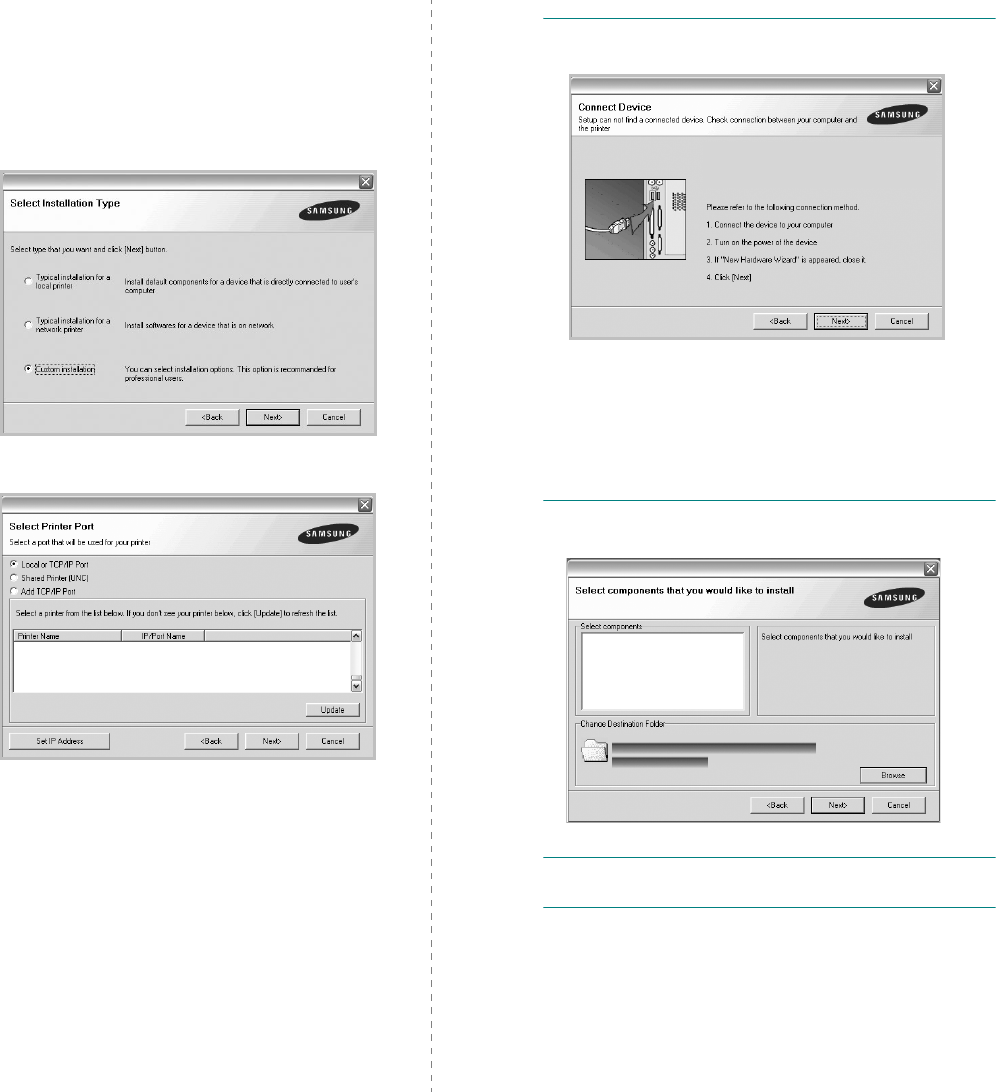
Installing Printer Software in Windows
6
3
Click
Next
.
• If necessary, select a language from the drop-down list.
•
View User’s Guide
: Allows you to view the User’s
Guide. If your computer doesn’t have Adobe Acrobat,
click on this option and it will automatically install Adobe
Acrobat Reader for you.
4
Select
Custom installation
. Click
Next
.
5
Select your printer and click
Next
.
NOTE
: If your printer is not already connected to the
computer, the following window will appear.
• After connecting the printer, click
Next
.
• If you don’t want to connect the printer at this time, click
Next
, and
No
on the following screen. Then the installation
will start and a test page will not be printed at the end of the
installation.
• The installation window that appears in this User’s
Guide may differ depending on the printer and
interface in use.
6
Select the components to be installed and click
Next
.
NOTE
: You can change the desired installation folder by
clicking [
Browse
].
7
After the installation is finished, a window asking you to
print a test page appears. If you choose to print a test
page, select the checkbox and click
Next
.
Otherwise, just click
Next
and skip to step 9.
8
If the test page prints out correctly, click
Yes
.
If not, click
No
to reprint it.
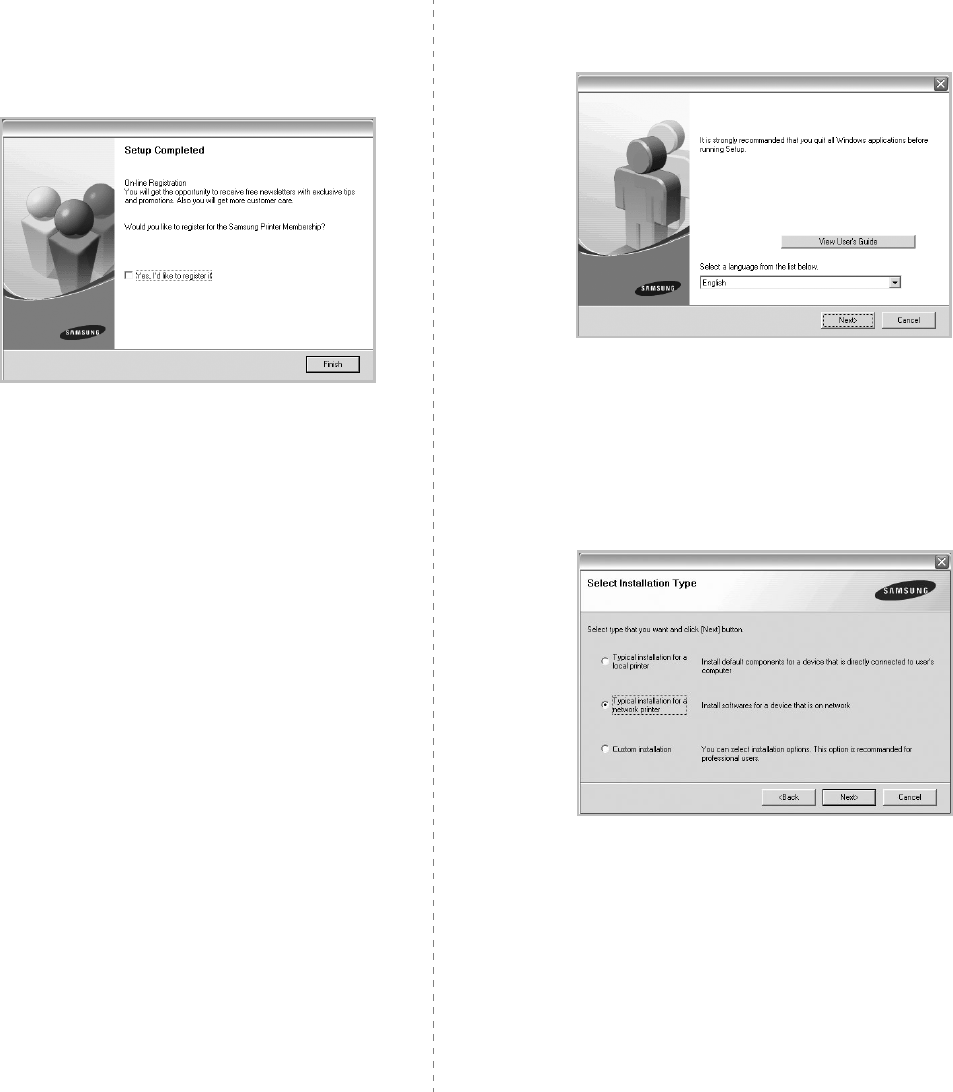
Installing Printer Software in Windows
7
9
To register yourself as a user of Samsung Printers in order
to receive information from Samsung, select the checkbox
and click
Finish
. You are now sent to the Samsung web
site.
Otherwise, just click
Finish
.
Installing Software for Network
Printing
When you connect your printer to a network, you must first
configure the TCP/IP settings for the printer. After you have
assigned and verified the TCP/IP settings, you are ready to
install the software on each computer on the network.
You can install the printer software using the typical or custom
method.
Typical Installation
This is recommended for most users. All components necessary
for printer operations will be installed.
1
Make sure that the printer is connected to your network
and powered on. For details about connecting to the
network, see the supplied printer’s User’s Guide.
2
Insert the supplied CD-ROM into your CD-ROM drive.
The CD-ROM should automatically run, and an installation
window appears.
If the installation window does not appear, click
Start
and
then
Run
. Type
X:\Setup.exe
, replacing “
X
” with the
letter which represents your drive and click
OK
.
3
Click
Next
.
• If necessary, select a language from the drop-down list.
•
View User’s Guide
: Allows you to view the User’s
Guide. If your computer doesn’t have Adobe Acrobat,
click on this option and it will automatically install Adobe
Acrobat Reader for you.
4
Select
Typical installation for a network printer
. Click
Next
.
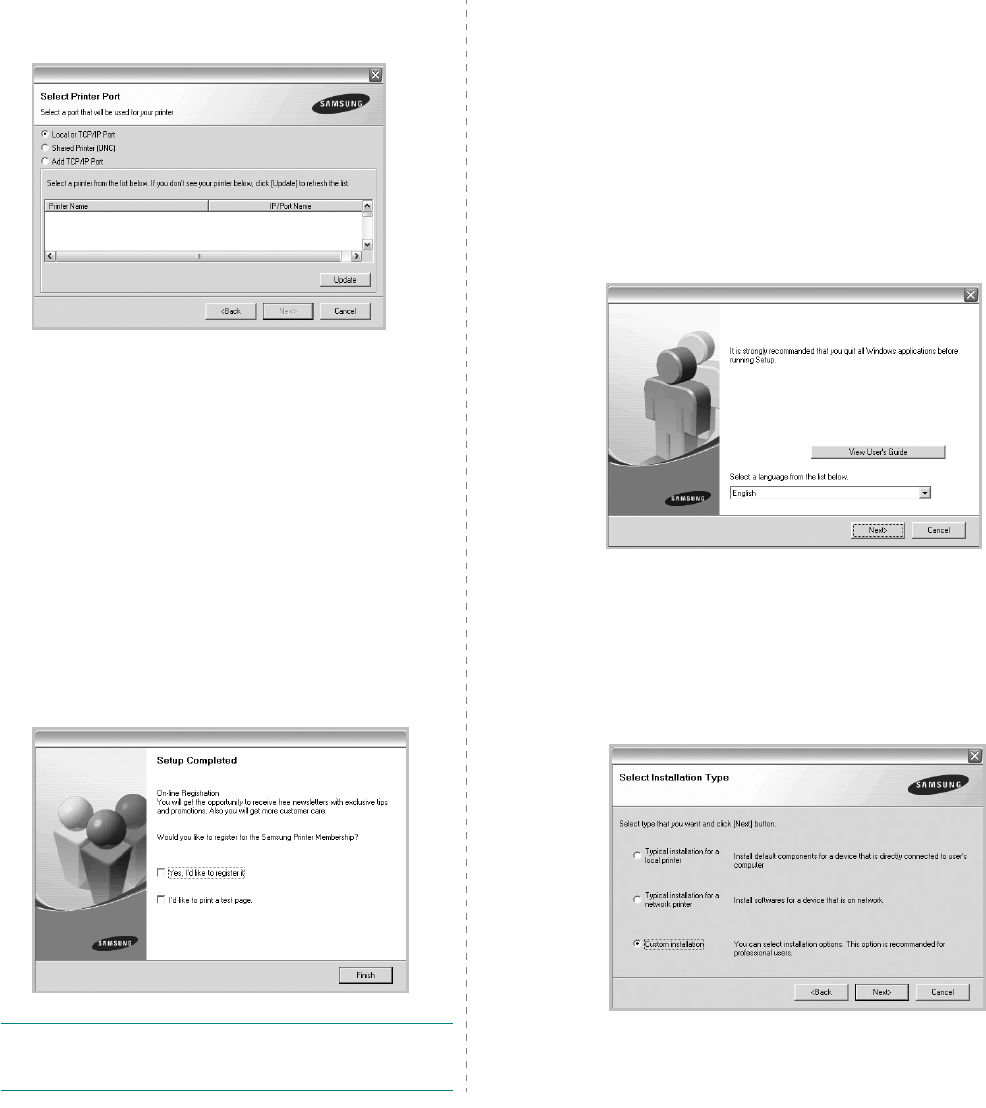
Installing Printer Software in Windows
8
5
The list of printers available on the network appears.
Select the printer you want to install from the list and then
click
Next
.
• If you do not see your printer on the list, click
Update
to
refresh the list, or select
Add TCP/IP Port
to add your
printer to the network. To add the printer to the
network, enter the port name and the IP address for the
printer.
To verify your printer’s IP address or the MAC address,
print a Network Configuration page.
• To find a shared network printer (UNC Path), select
Shared Printer [UNC]
and enter the shared name
manually or find a shared printer by clicking the
Browse
button.
6
After the installation is finished, a window appears asking
you to print a test page and to register yourself as a user
of Samsung Printers in order to receive information from
Samsung. If you so desire, select the corresponding
checkbox(es) and click
Finish
.
Otherwise, just click
Finish
.
NOTE
: After setup is complete, if your printer driver doesn’t
work properly, reinstall the printer driver. See “Reinstalling
Printer Software” on page 10.
Custom Installation
You can choose individual components to install and set a
specific IP address.
1
Make sure that the printer is connected to your network
and powered on. For details about connecting to the
network, see the supplied printer’s User’s Guide.
2
Insert the supplied CD-ROM into your CD-ROM drive.
The CD-ROM should automatically run, and an installation
window appears.
If the installation window does not appear, click
Start
and
then
Run
. Type
X:\Setup.exe
, replacing “
X
” with the
letter which represents your drive and click
OK
.
3
Click
Next
.
• If necessary, select a language from the drop-down list.
•
View User’s Guide
: Allows you to view the User’s
Guide. If your computer doesn’t have Adobe Acrobat,
click on this option and it will automatically install Adobe
Acrobat Reader for you.
4
Select
Custom installation
. Click
Next
.
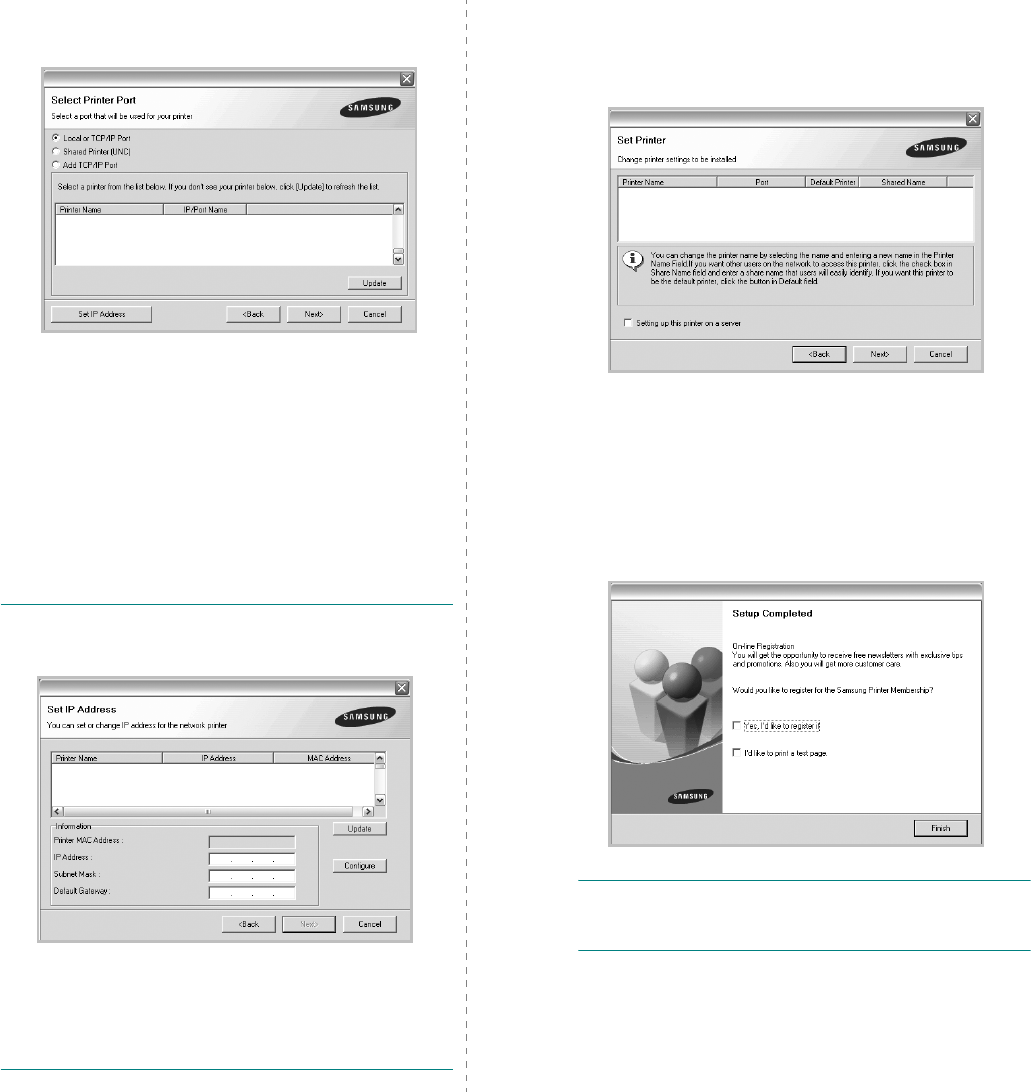
Installing Printer Software in Windows
9
5
The list of printers available on the network appears.
Select the printer you want to install from the list and then
click
Next
.
• If you do not see your printer on the list, click
Update
to
refresh the list, or select
Add TCP/IP Port
to add your
printer to the network. To add the printer to the
network, enter the port name and the IP address for the
printer.
To verify your printer’s IP address or the MAC address,
print a Network Configuration page.
• To find a shared network printer (UNC Path), select
Shared Printer [UNC]
and enter the shared name
manually or find a shared printer by clicking the
Browse
button.
TIP
: If you want to set a specific IP address on a specific
network printer, click the
Set IP Address
button. The Set IP
Address window appears. Do as follows:
a. Select a printer to be set with a specific IP address from the
list.
b. Configure an IP address, subnet mask, and gateway for the
printer manually and click
Configure
to set the specific IP
address for the network printer.
c. Click
Next
.
6
Select the components to be installed. After selecting the
components, the following window appears. You can also
change the printer name, set the printer to be shared on
the network, set the printer as the default printer, and
change the port name of each printer. Click
Next
.
To install this software on a server, select the
Setting up
this printer on a server
checkbox.
7
After the installation is finished, a window appears asking
you to print a test page and to register yourself as a user
of Samsung Printers in order to receive information from
Samsung. If you so desire, select the corresponding
checkbox(es) and click
Finish
.
Otherwise, just click
Finish
.
NOTE
: After setup is complete, if your printer driver doesn’t
work properly, reinstall the printer driver. See “Reinstalling
Printer Software” on page 10.
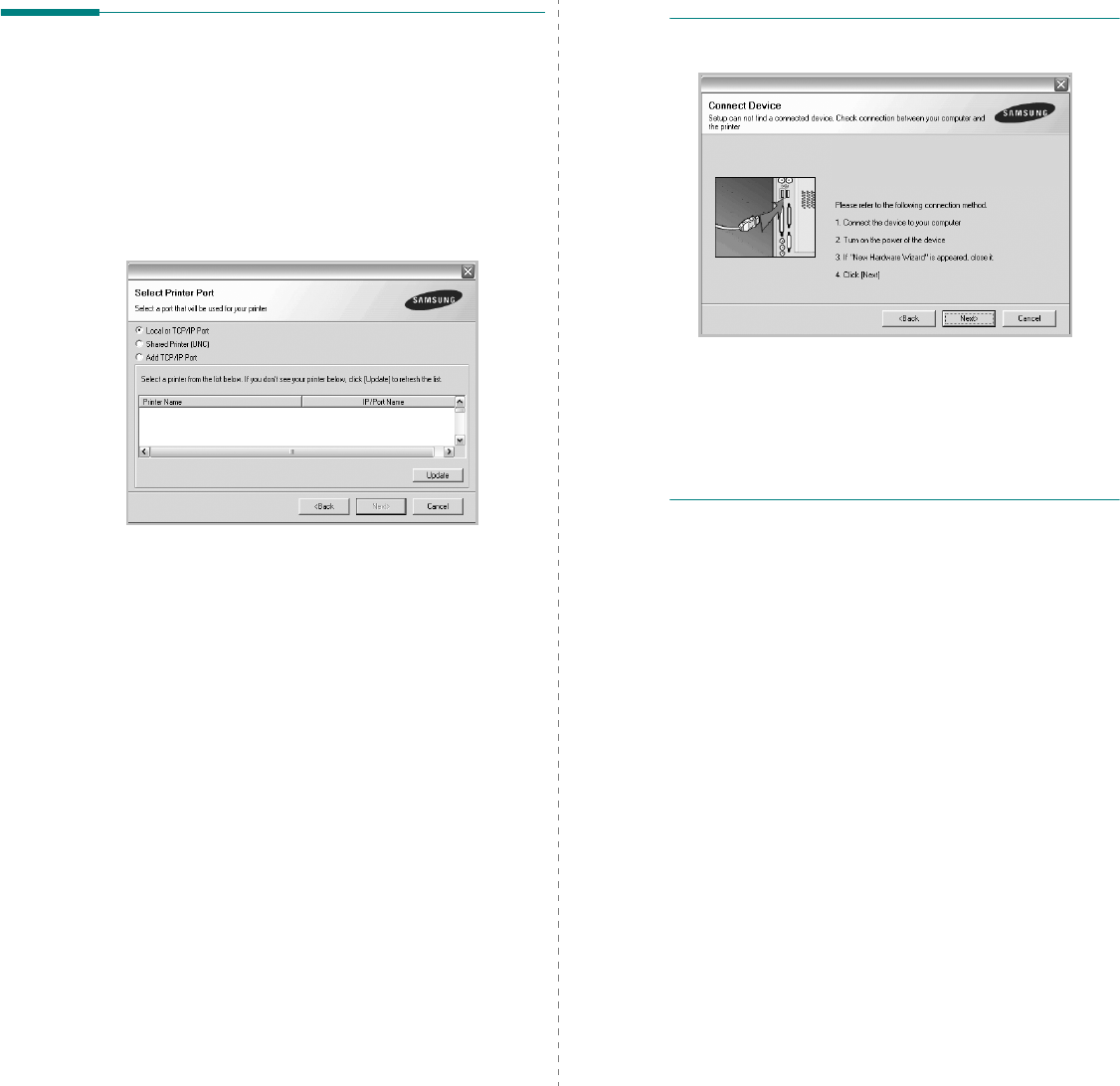
Installing Printer Software in Windows
10
Reinstalling Printer Software
You can reinstall the software if installation fails.
1
Start Windows.
2
From the
Start
menu select
Programs
or
All Programs
→
your printer driver name
→
Maintenance
.
3
Select
Repair
and click
Next
.
4
The list of printers available on the network appears.
Select the printer you want to install from the list and then
click
Next
.
• If you do not see your printer on the list, click
Update
to
refresh the list, or select
Add TCP/IP Port
to add your
printer to the network. To add the printer to the
network, enter the port name and the IP address for the
printer.
• To find a shared network printer (UNC Path), select
Shared Printer [UNC]
and enter the shared name
manually or find a shared printer by clicking the
Browse
button.
You will see a component list so that you can reinstall any
item individually.
NOTE
: If your printer is not already connected to the
computer, the following window will appear.
• After connecting the printer, click
Next
.
• If you don’t want to connect the printer at this time, click
Next
, and
No
on the following screen. Then the installation
will start and a test page will not be printed at the end of the
installation.
• The reinstallation window that appears in this User’s
Guide may differ depending on the printer and
interface in use.
5
Select the components you want to reinstall and click
Next
.
If you installed the printer software for local printing
and
you select
your printer driver name
, the window
asking you to print a test page appears. Do as follows:
a. To print a test page, select the check box and click
Next
.
b. If the test page prints out correctly, click
Yes
.
If it doesn’t, click
No
to reprint it.
6
When the reinstallation is done, click
Finish
.

Installing Printer Software in Windows
11
Removing Printer Software
1
Start Windows.
2
From the
Start
menu select
Programs
or
All Programs
→
your printer driver name
→
Maintenance
.
3
Select
Remove
and click
Next
.
You will see a component list so that you can remove any
item individually.
4
Select the components you want to remove and then click
Next
.
5
When your computer asks you to confirm your selection,
click
Yes
.
The selected driver and all of its components are removed
from your computer.
6
After the software is removed, click
Finish
.
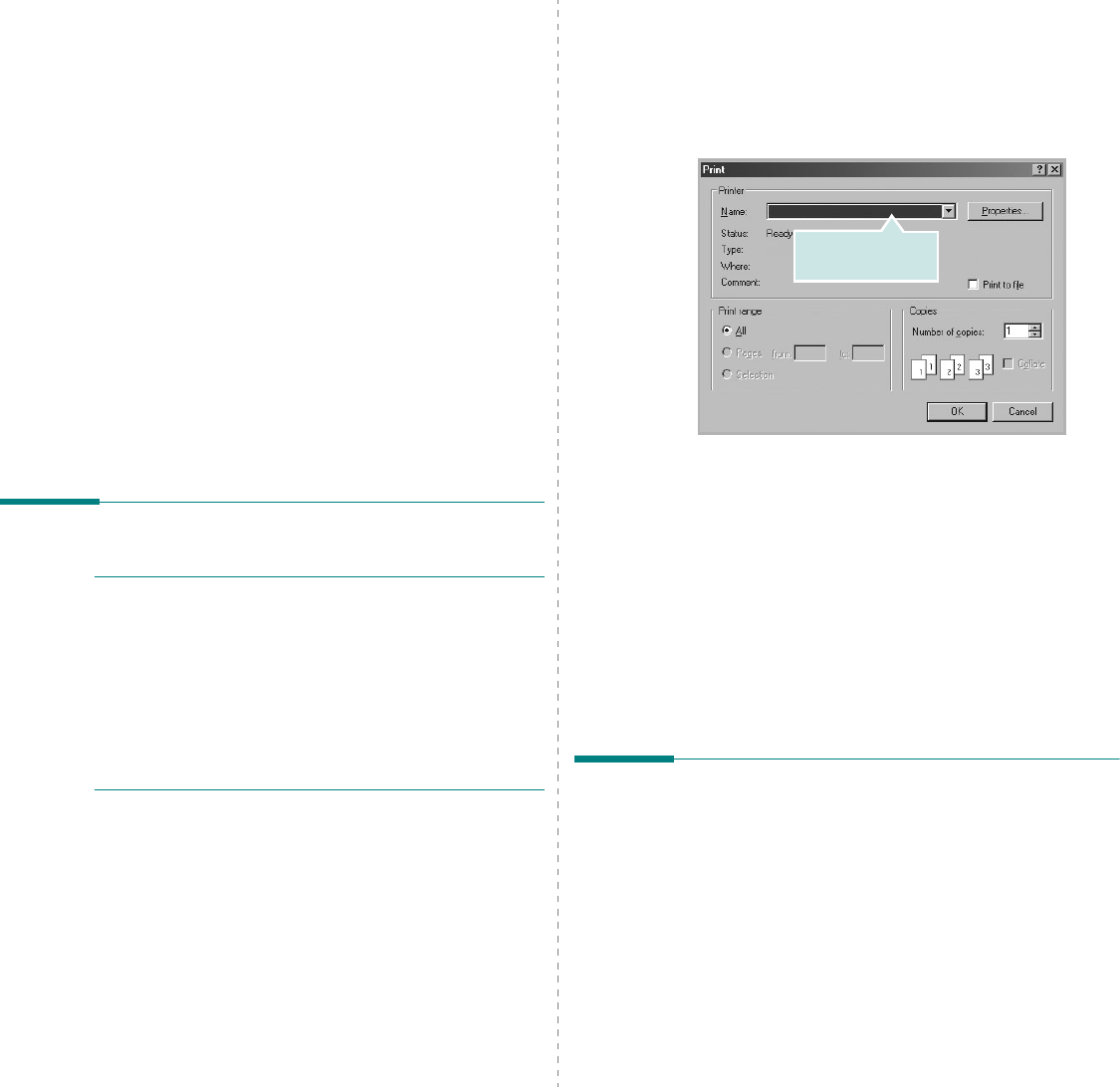
Basic Printing
12
2Basic Printing
This chapter explains the printing options and common printing
tasks in Windows.
This chapter includes:
• Printing a Document
• Printing to a file (PRN)
• Printer Settings
- Layout Tab
- Paper Tab
- Graphics Tab
- Extras Tab
- About Tab
- Printer Tab
- Using a Favorite Setting
- Using Help
Printing a Document
N
OTES
:
• Your printer driver
Properties
window that appears in this
User’s Guide may differ depending on the printer in use.
However the composition of the printer properties window is
similar.
• Check the Operating System(s) that are compatible
with your printer. Please refer to the OS Compatibility
section of Printer Specifications in your Printer User’s
Guide.
• If you need to know the exact name of your printer, you can
check the supplied CD-ROM.
The following procedure describes the general steps required
for printing from various Windows applications. The exact steps
for printing a document may vary depending on the application
program you are using. Refer to the User’s Guide of your
software application for the exact printing procedure.
1
Open the document you want to print.
2
Select
Print
from the
File
menu. The Print window is
displayed. It may look slightly different depending on your
application.
The basic print settings are selected within the Print
window. These settings include the number of copies and
print range.
3
Select
your printer driver
from the
Name
drop-down
list.
To take advantage of the printer features provided by your
printer driver, click
Properties
or
Preferences
in the
application’s Print window. For details, see “Printer
Settings” on page 13.
If you see
Setup
,
Printer
, or
Options
in your Print
window, click it instead. Then click
Properties
on the next
screen.
Click
OK
to close the printer properties window.
4
To start the print job, click
OK
or
Print
in the Print
window.
Printing to a file (PRN)
You will sometimes need to save the print data as a file for your
purpose.
To create a file:
1
Check the
Print to file
box at the
Print
window.
2
Select the folder and assign a name of the file and then
click OK.
Make sure that your
printer is selected.
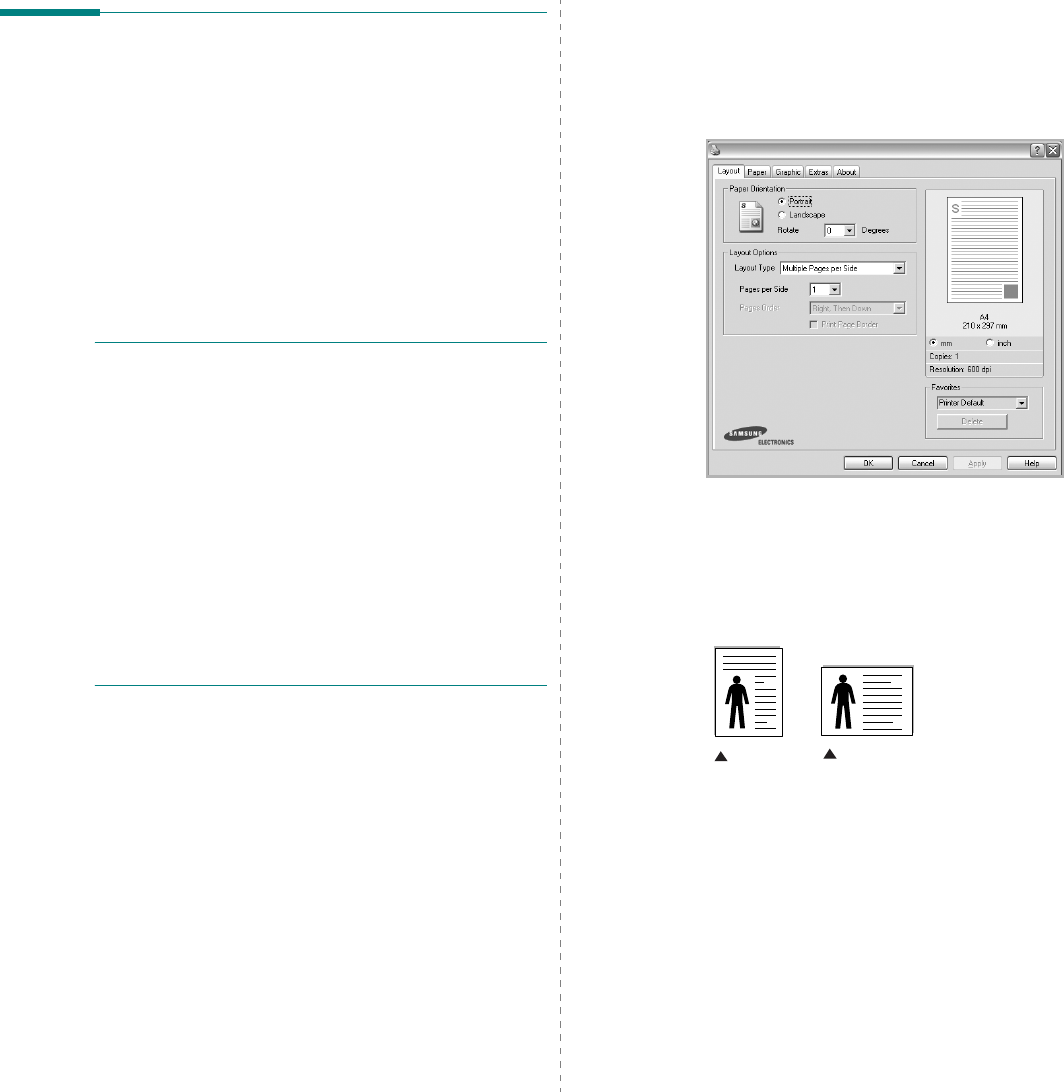
Basic Printing
13
Printer Settings
You can use the printer properties window, which allows you to
access all of the printer options you need when using your
printer. When the printer properties are displayed, you can
review and change the settings needed for your print job.
Your printer properties window may differ, depending on your
operating system. This Software User’s Guide shows the
Properties window for Windows XP.
Your printer driver
Properties
window that appears in this
User’s Guide may differ depending on the printer in use.
If you access printer properties through the Printers folder, you
can view additional Windows-based tabs (refer to your
Windows User’s Guide) and the Printer tab (see “Printer Tab” on
page 16).
N
OTES
:
• Most Windows applications will override settings you specify
in the printer driver. Change all print settings available in the
software application first, and change any remaining settings
using the printer driver.
• The settings you change remain in effect only while you are
using the current program.
To make your changes
permanent
, make them in the Printers folder.
• The following procedure is for Windows XP. For other
Windows OS, refer to the corresponding Windows User's
Guide or online help.
1. Click the Windows
Start
button.
2. Select
Printers and Faxes
.
3. Select your printer driver icon.
4. Right-click on the printer driver icon and select
Printing Preferences
.
5. Change the settings on each tab, click OK.
Layout Tab
The
Layout
tab provides options to adjust how the document
appears on the printed page. The
Layout Options
includes
Multiple Pages per Side
and
Poster Printing
. See “Printing
a Document” on page 12 for more information on accessing
printer properties.
Paper Orientation
Paper Orientation
allows you to select the direction in which
information is printed on a page.
•
Portrait
prints across the width of the page, letter style.
•
Landscape
prints across the length of the page, spreadsheet
style.
•
Rotate
allows you to rotate the page the selected degrees.
Layout Options
Layout Options
allows you to select advanced printing options.
You can choose
Multiple Pages per Side
and
Poster Printing
.
•
For details, see
“Printing Multiple Pages on One Sheet of Paper
(N-Up Printing)” on page 18.
•
For details, see
“Printing Posters” on page 19
Double-sided Printing
Double-sided Printing
allows you to print on both sides of
paper.
If this option does not appear, your printer does
not have this feature.
•
For details, see
“Printing on Both Sides of Paper” on page 20.
Landscape
Portrait
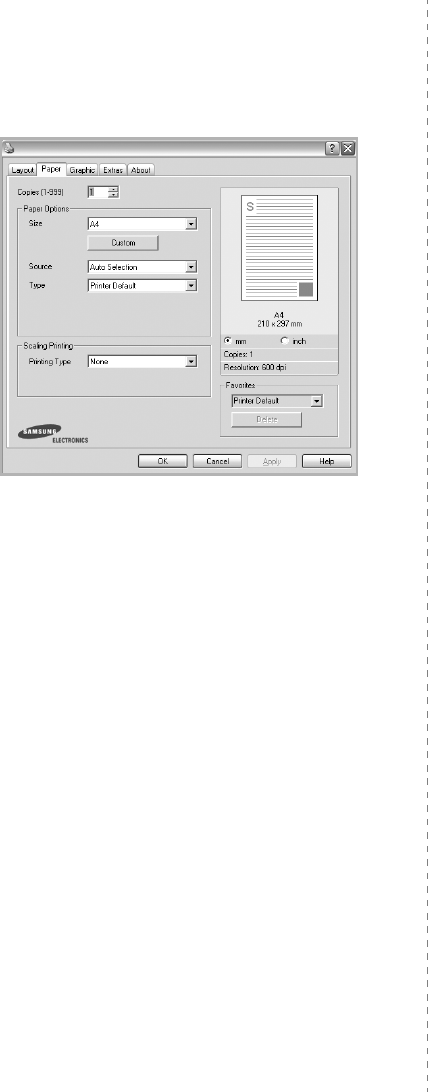
Basic Printing
14
Paper Tab
Use the following options to set the basic paper handling
specifications when you access the printer properties. See
“Printing a Document” on page 12 for more information on
accessing printer properties.
Click the
Paper
tab to access various paper properties.
Copies
Copies
allows you to choose the number of copies to be printed.
You can select 1 to 999 copies.
Size
Size
allows you to set the size of paper you loaded in the tray.
If the required size is not listed in the
Size
box, click
Custom
.
When the
Custom Paper Setting
window appears, set the paper
size and click
OK
. The setting appears in the list so that you can
select it.
Source
Make sure that
Source
is set to the corresponding paper tray.
Use
Manual Feeder
when printing on special materials like
envelopes and transparencies. You have to load one sheet at a
time into the Manual Tray or Multi-Purpose Tray.
If the paper source is set to
Auto Selection
, the printer
automatically picks up print material in the following tray order:
Ma nual Tray or Multi- Purpos e Tray, Tray n.
Type
Set
Type
to correspond to the paper loaded in the tray from
which you want to print. This will let you get the best quality
printout. If not, print quality may not be acheived as you want.
Cotton
: 20 lb to 24 lb (75~90 g/m2) cotton paper such as Gilbert
25 % and Gilbert 100 %.
Plain Paper
: Normal plain paper. Select this type if your printer is
monochrome and printing on the 16 lb (60 g/m2) cotton paper.
Recycled Paper
: 20 lb to 24 lb (75~90 g/m2) recycled paper.
Color Paper
: 20 lb to 24 lb (75~90 g/m2) color-backgrounded
paper.
First Page
This property allows you to print the first page using a different
paper type from the rest of the document. You can select the
paper source for the first page.
For example, load thick stock for the first page into the Multi-
purpose Tray, and plain paper into Tray n. Then, select
Tray n
in
the
Source
option and
Multi-Purpose Tray
in the
First Page
option.
Scaling Printing
Scaling Printing
allows you to automatically or manually scale
your print job on a page. You can choose from
None
,
Reduce/
Enlarge
, and
Fit to Page
.
•
For details, see
“Printing a Reduced or Enlarged Document” on
page 20.
•
For details, see
“Fitting Your Document to a Selected Paper
Size” on page 20.
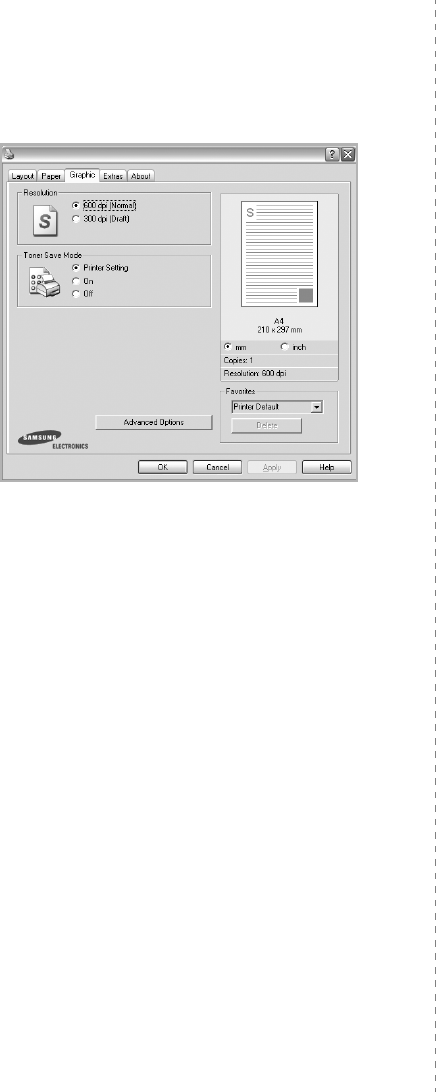
Basic Printing
15
Graphics Tab
Use the following Graphic options to adjust the print quality for
your specific printing needs. See “Printing a Document” on
page 12 for more information on accessing printer properties.
Click the
Graphic
tab to display the properties shown below.
Resolution
The Resolution options you can select may vary
depending on your printer model.
The higher the setting,
the sharper the clarity of printed characters and graphics. The
higher setting also may increase the time it takes to print a
document.
Image Mode
The available options are Normal and Text Enhance.
Some
printers do not support this feature.
•
Printer Setting
: If you select this option, this feature is
determined by the setting you’ve made on the control panel of
the printer.
•
Normal
: This setting is for normal documents.
•
Text Enhancement
: Image Mode allows the user to enhance
printouts.
Toner Save Mode
Selecting this option extends the life of your toner cartridge and
reduces your cost per page without a significant reduction in print
quality.
Some printers do not support this feature.
•
Printer Setting
: If you select this option, this feature is
determined by the setting you’ve made on the control panel of
the printer.
•
On
: Select this option to allow the printer to use less toner on
each page.
•
Off
: If you don’t need to save toner when printing a document,
select this option.
Advanced Options
You can set advanced settings by clicking the
Advanced
Options
button.
•
TrueType Options
: This option determines what the driver
tells the printer about how to image the text in your document.
Select the appropriate setting according to the status of your
document.
This option may be available only in
Windows 9x/Me, depending on your particular printer
model.
-
Download as Outline
: When this option is selected, the
driver will download any TrueType fonts that are used in your
document not already stored (resident) on your printer. If,
after printing a document, you find that the fonts did not print
correctly, choose Download as bit image and resubmit your
print job. The Download as bit image setting is often useful
when printing Adobe.
This feature is available only
when you use the PCL printer driver.
-
Download as Bitmap
: When this option is selected, the
driver will download the font data as bitmap images.
Documents with complicated fonts, such as Korean or
Chinese, or various other fonts, will print faster in this setting.
-
Print as Graphics
: When this option is selected, the driver
will download any fonts as graphics. When printing documents
with high graphic content and relatively few TrueType fonts,
printing performance (speed) may be enhanced in this
setting.
•
Print All Text To Black
: When the
Print All Text To Black
option is checked, all text in your document prints solid black,
regardless of the color it appears on the screen.
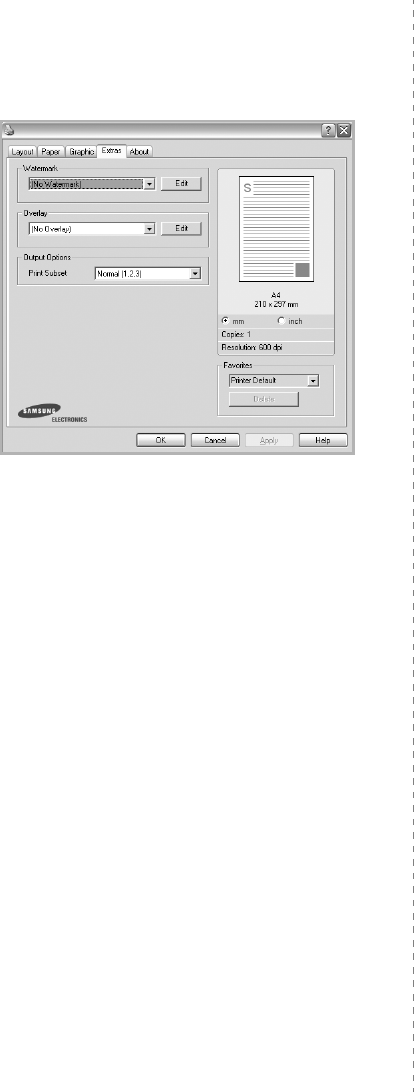
Basic Printing
16
Extras Tab
You can select output options for your document. See “Printing
a Document” on page 12 for more information about accessing
the printer properties.
Click the
Extras
tab to access the following feature:
Watermark
You can create a background text image to be printed on each
page of your document.
For details, see
“Using Watermarks” on
page 21.
Overlay
Overlays are often used to take the place of preprinted forms and
letterhead paper.
For details, see
“Using Overlays” on page 22.
Output Options
•
Print Subset
: You can set the sequence in which the pages
print. Select the print order from the drop-down list.
-
Normal (1,2,3)
: Your printer prints all pages from the first
page to the last page.
-
Reverse All Pages (3,2,1)
: Your printer prints all pages
from the last page to the first page.
-
Print Odd Pages
: Your printer prints only the odd numbered
pages of the document.
-
Print Even Pages
: Your printer prints only the even
numbered pages of the document.
•
Use Printer Fonts
: When Use Printer Fonts is checked, the
printer uses the fonts that are stored in its memory (resident
fonts) to print your document, rather than downloading the
fonts used in your document. Because downloading fonts takes
time, selecting this option can speed up your printing time.
When using Printer fonts, the printer will try to match the fonts
used in your document to those stored in its memory. If,
however, you use fonts in your document that are very different
from those resident in the printer, your printed output will
appear very different from what it looks like on the screen.
This feature is available only when you use the PCL
printer driver.
About Tab
Use the
About
tab to display the copyright notice and the
version number of the driver. If you have an Internet browser,
you can connect to the Internet by clicking on the web site icon.
See “Printing a Document” on page 12 for more information
about accessing printer properties.
Printer Tab
If you access printer properties through the
Printers
folder,
you can view the
Printer
tab. You can set the printer
configuration.
The following procedure is for Windows XP. For other Windows
OS, refer to the corresponding Windows User's Guide or online
help.
1
Click the Windows
Start
menu.
2
Select
Printers and Faxes
.
3
Select
your printer driver
icon.
4
Right-click on the printer driver icon and select
Properties
.
5
Click the
Printer
tab and set the options.
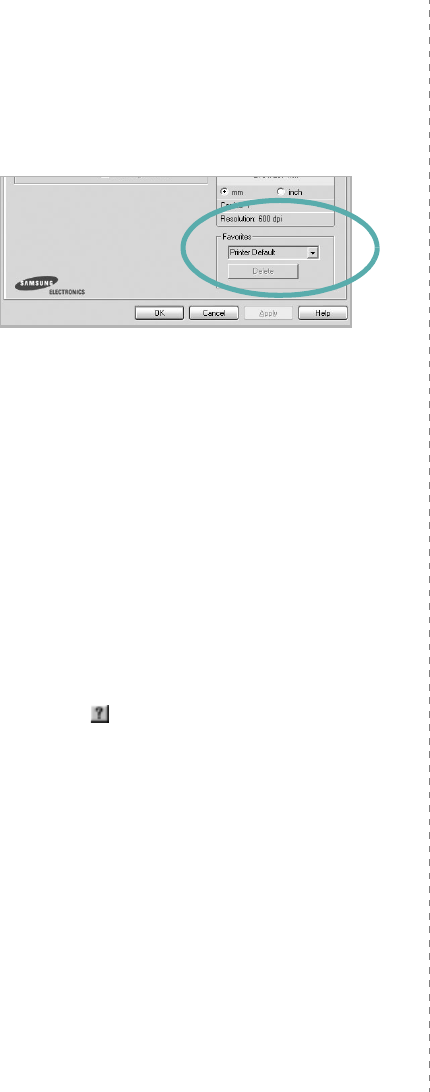
Basic Printing
17
Using a Favorite Setting
The
Favorites
option, which is visible on each properties tab,
allows you to save the current properties settings for future
use.
To s ave a
Favorites
item:
1
Change the settings as needed on each tab.
2
Enter a name for the item in the
Favorites
input box.
3
Click
Save
.
When you save
Favorites
, all current driver settings are
saved.
To use a saved setting, select the item from the
Favorites
drop
down list. The printer is now set to print according to the
Favorites setting you selected.
To delete a Favorites item, select it from the list and click
Delete
.
You can also restore the printer driver’s default settings by
selecting
Printer Default
from the list.
Using Help
Your printer has a help screen that can be activated by clicking
the
Help
button in the printer properties window. These help
screens give detailed information about the printer features
provided by the printer driver.
You can also click from the upper right corner of the window,
and then click on any setting.
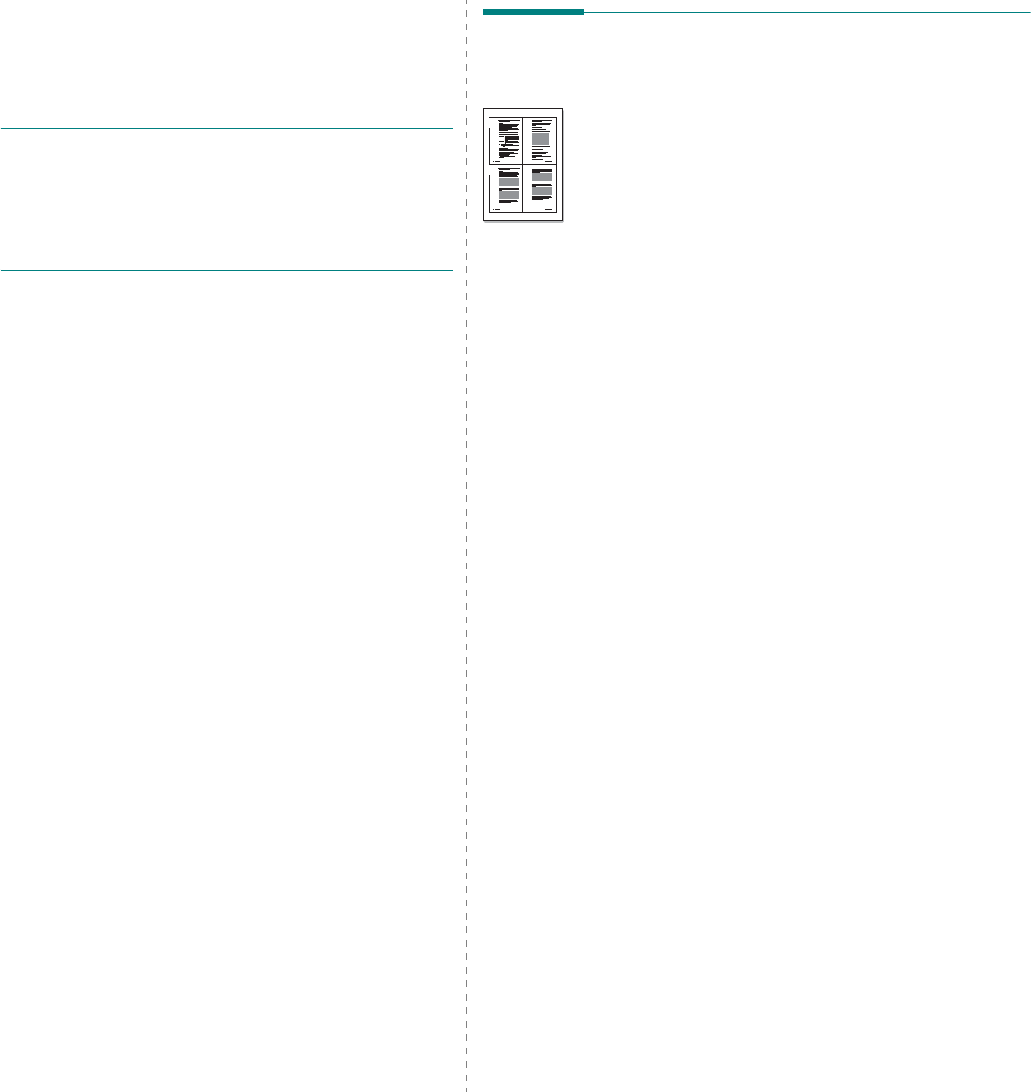
Advanced Printing
18
3Advanced Printing
This chapter explains printing options and advanced printing
tasks.
N
OTE
:
• Your printer driver
Properties
window that appears in this
User’s Guide may differ depending on the printer in use.
However the composition of the printer properties window is
similar.
• If you need to know the exact name of your printer, you can
check the supplied CD-ROM.
This chapter includes:
• Printing Multiple Pages on One Sheet of Paper (N-Up
Printing)
•Printing Posters
• Printing Booklets
• Printing on Both Sides of Paper
• Printing a Reduced or Enlarged Document
• Fitting Your Document to a Selected Paper Size
•Using Watermarks
•Using Overlays
Printing Multiple Pages on One
Sheet of Paper (N-Up Printing)
You can select the number of pages to print on a single sheet
of paper. To print more than one page per sheet, the pages will
be reduced in size and arranged in the order you specify. You
can print up to 16 pages on one sheet.
1
To change the print settings from your software
application, access printer properties. See “Printing a
Document” on page 12.
2
From the
Layout
tab, choose
Multiple Pages per Side
in
the
Layout Type
drop-down list.
3
Select the number of pages you want to print per sheet
(1, 2, 4, 6, 9, or 16) in the
Pages per Side
drop-down
list.
4
Select the page order from the
Pages Order
drop-down
list, if necessary.
Check
Print Page Border
to print a border around each
page on the sheet.
5
Click the
Paper
tab, select the paper source, size, and
type.
6
Click
OK
and print the document.
1 2
3 4
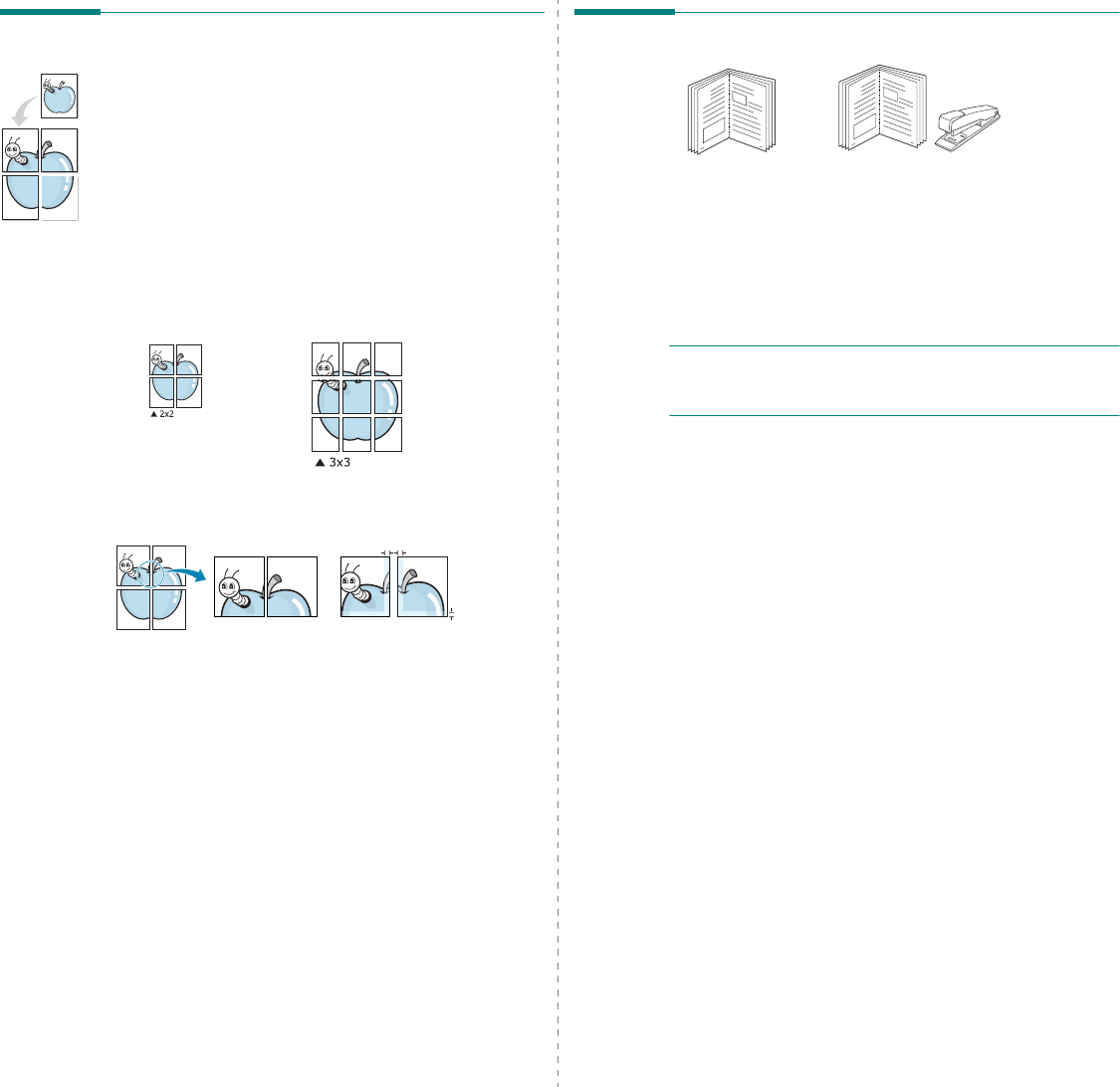
Advanced Printing
19
Printing Posters
This feature allows you to print a single-page document onto 4,
9, or 16 sheets of paper, for the purpose of pasting the sheets
together to form one poster-size document.
1
To change the print settings from your software
application, access printer properties. See “Printing a
Document” on page 12.
2
Click the
Layout
tab, select
Poster Printing
in the
Layout Type
drop-down list.
3
Configure the poster option:
You can select the page layout from
Poster<2x2>
,
Poster<3x3>
, or
Poster<4x4>
. If you select
Poster<2x2>
, the output will be automatically stretched
to cover 4 physical pages.
Specify an overlap in millimeters or inches to make it
easier to pasting the sheets together.
4
Click the
Paper
tab, select the paper source, size, and
type.
5
Click
OK
and print the document. You can complete the
poster by pasting the sheets together.
0.15 inches
0.15 inches
Printing Booklets
This printer feature allows you to print your document on both
sides of the paper and arranges the pages so that the paper can
be folded in half after printing to produce a booklet.
1
To change the print settings from your software
application, access the printer properties. See “Printing a
Document” on page 12.
2
From the
Layout
tab, choose
Booklet Printing
from the
Type
drop-down list.
N
OTE
: The booklet printing option is available when A4,
Letter, Legal, Oficio, or Folio size is selected in the
Size
option
on the
Paper
tab.
3
Click the
Paper
tab, and select the paper source, size, and
type.
4
Click
OK
and print the document.
5
After printing, fold and staple the pages.
8
9
8
9
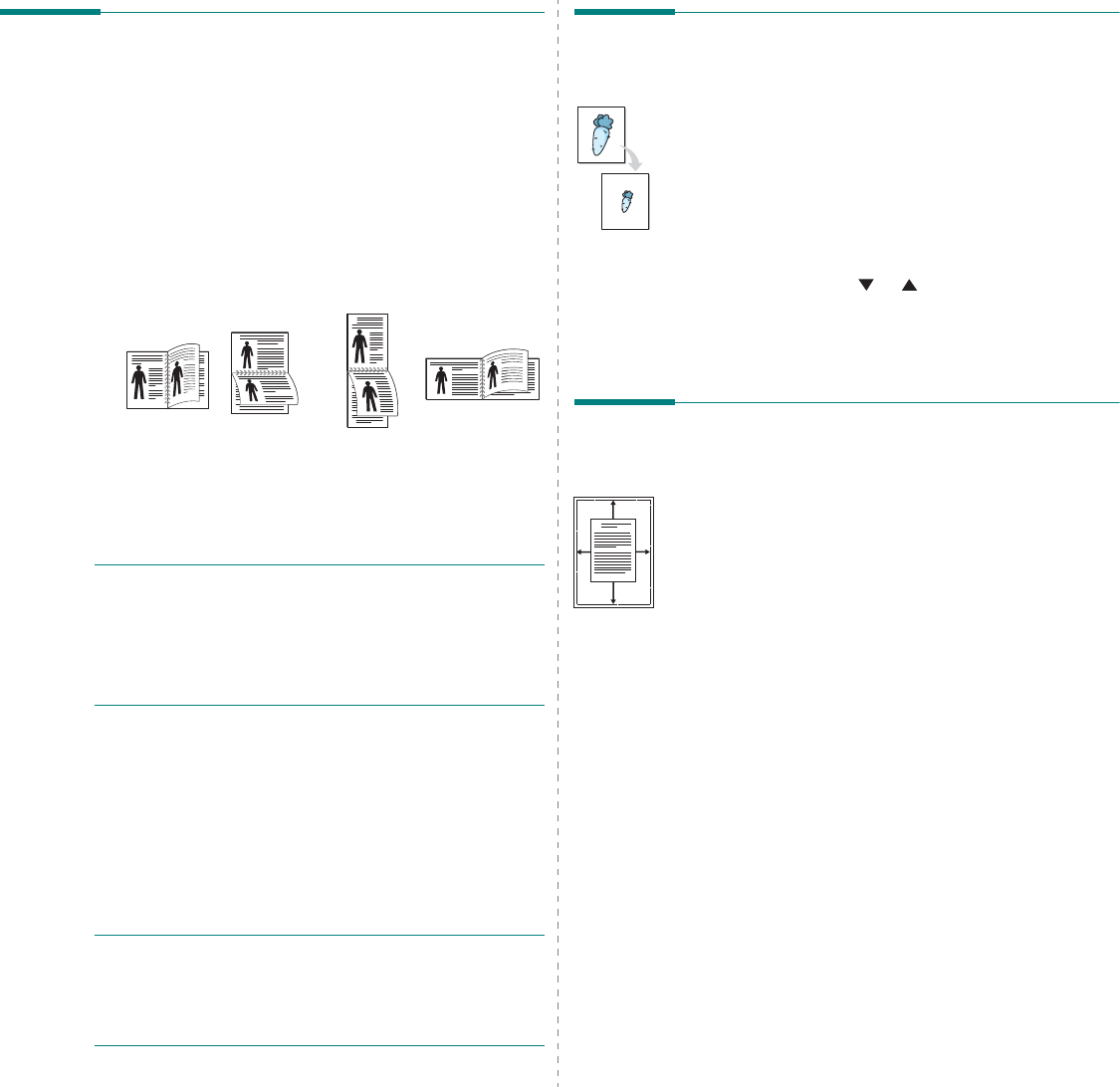
Advanced Printing
20
Printing on Both Sides of Paper
You can print on both sides of a sheet of paper. Before printing,
decide how you want your document oriented.
The options are:
•
Printer Setting
, if you select this option, this feature is
determined by the setting you’ve made on the control
panel of the printer.
If this option does not appear,
your printer does not have this feature.
•
None
•
Long Edge
, which is the conventional layout used in
book binding.
•
Short Edge
, which is the type often used with calendars.
•
Reverse Duplex Printing
, allows you to select general
print order compare to duplex print order.
If this option
does not appear, your printer does not have this
feature.
N
OTE
:
• Do not print on both sides of labels, transparencies,
envelopes, or thick paper. Paper jamming and damage to the
printer may result.
• To use double-sided printing, you can use only the following
paper sizes: A4, Letter, Legal, Oficio, and Folio, with a weight
of 20~24 lbs (75~90 g/m
²
).
1
To change the print settings from your software
application, access printer properties. “Printing a
Document” on page 12.
2
From the
Layout
tab, select the paper orientation.
3
From the
Double-sided Printing
section, select the
binding option you want.
4
Click the
Paper
tab and select the paper source, size, and
type.
5
Click
OK
and print the document.
N
OTE
: If your printer does not have a duplex unit, you should
complete the printing job manually. The printer prints every
other page of the document first. After printing the first side of
your job, the Printing Tip window appears. Follow the on-
screen instructions to complete the printing job.
Long Edge
▲
Short Edge
▲
25
3
2
5
3
25
3
2
5
3
Printing a Reduced or Enlarged
Document
You can change the size of a page’s content to appear larger or
smaller on the printed page.
1
To change the print settings from your software
application, access printer properties. See “Printing a
Document” on page 12.
2
From the
Paper
tab, select
Reduce/Enlarge
in the
Printing Type
drop-down list.
3
Enter the scaling rate in the
Percentage
input box.
You can also click the or button.
4
Select the paper source, size, and type in
Paper Options
.
5
Click
OK
and print the document.
Fitting Your Document to a
Selected Paper Size
This printer feature allows you to scale your print job to any
selected paper size regardless of the digital document size. This
can be useful when you want to check fine details on a small
document.
1
To change the print settings from your software
application, access printer properties. See “Printing a
Document” on page 12.
2
From the
Paper
tab, select
Fit to Page
in the
Printing
Type
drop-down list.
3
Select the correct size from the
Output size
drop-down
list.
4
Select the paper source, size, and type in
Paper Options
.
5
Click
OK
and print the document.
A

Advanced Printing
21
Using Watermarks
The Watermark option allows you to print text over an existing
document. For example, you may want to have large gray
letters reading “DRAFT” or “CONFIDENTIAL” printed diagonally
across the first page or all pages of a document.
There are several predefined watermarks that come with the
printer, and they can be modified, or you can add new ones to
the list.
Using an Existing Watermark
1
To change the print settings from your software
application, access printer properties. See “Printing a
Document” on page 12.
2
Click the
Extras
tab, and select the desired watermark
from the
Watermark
drop-down list. You will see the
selected watermark in the preview image.
3
Click
OK
and start printing.
N
OTE
: The preview image shows how the page will look when
it is printed.
Creating a Watermark
1
To change the print settings from your software
application, access printer properties. See “Printing a
Document” on page 12.
2
Click the
Extras
tab, and click the
Edit
button in the
Watermark
section. The
Edit Watermarks
window
appears.
3
Enter a text message in the
Watermark Message
box.
You can enter up to 40 characters. The message displays
in the preview window.
When the
First Page Only
box is checked, the watermark
prints on the first page only.
4
Select watermark options.
You can select the font name, style, size, or grayscale level
from the
Font Attributes
section and set the angle of the
watermark from the
Message Angle
section.
5
Click
Add
to add a new watermark to the list.
6
When you have finished editing, click
OK
and start
printing.
To stop printing the watermark, select
(No Watermark)
from
the
Watermark
drop-down list.
Editing a Watermark
1
To change the print settings from your software
application, access printer properties. See “Printing a
Document” on page 12.
2
Click the
Extras
tab and click the
Edit
button in the
Watermark
section. The
Edit Watermarks
window
appears.
3
Select the watermark you want to edit from the
Current
Watermarks
list and change the watermark message and
options.
4
Click
Update
to save the changes.
5
Click
OK
until you exit the Print window.
Deleting a Watermark
1
To change the print settings from your software
application, access printer properties. See “Printing a
Document” on page 12.
2
From the
Extras
tab, click the
Edit
button in the
Watermark section. The
Edit Watermarks
window
appears.
3
Select the watermark you want to delete from the
Current
Watermarks
list and click
Delete
.
4
Click
OK
until you exit the Print window.
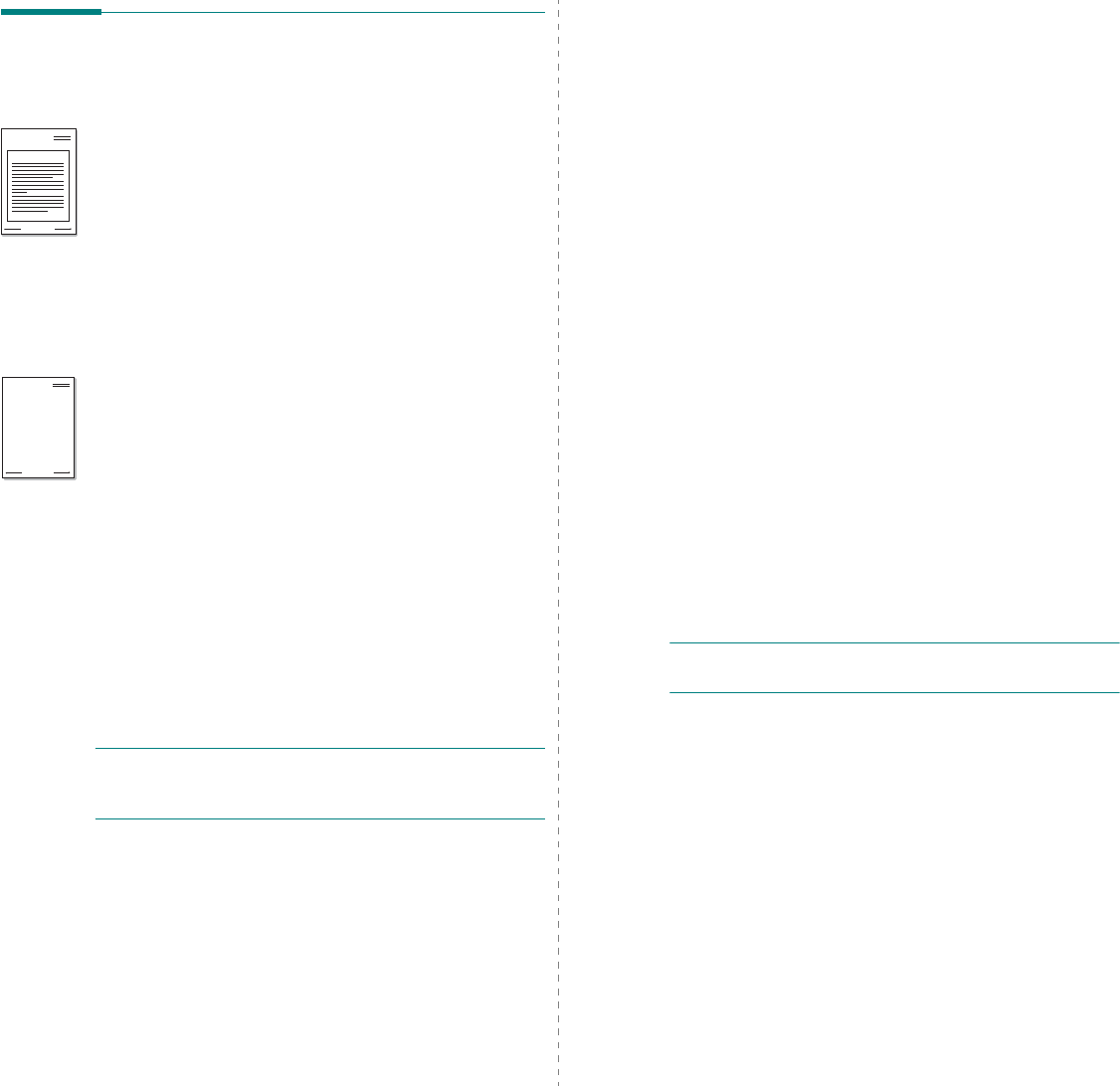
Advanced Printing
22
Using Overlays
What is an Overlay?
An overlay is text and/or images stored in the computer hard
disk drive (HDD) as a special file format that can be printed on
any document. Overlays are often used to take the place of
preprinted forms and letterhead paper. Rather than using
preprinted letterhead, you can create an overlay containing the
exact same information that is currently on your letterhead. To
print a letter with your company’s letterhead, you do not need
to load preprinted letterhead paper in the printer. You need only
tell the printer to print the letterhead overlay on your
document.
Creating a New Page Overlay
To use a page overlay, you must create a new page overlay
containing your logo or image.
1
Create or open a document containing text or an image for
use in a new page overlay. Position the items exactly as
you wish them to appear when printed as an overlay.
2
To save the document as an overlay, access printer
properties. See “Printing a Document” on page 12.
3
Click the
Extras
tab, and click
Edit
button in the
Overlay
section.
4
In the Edit Overlay window, click
Create Overlay
.
5
In the Create Overlay window, type a name of up to eight
characters in the
File name
box. Select the destination
path, if necessary. (The default is C:\Formover).
6
Click
Save
. The name appears on the
Overlay List
box.
7
Click
OK
or
Yes
to finish creating.
The file is not printed. Instead it is stored on your
computer hard disk drive.
N
OTE
: The overlay document size must be the same as the
documents you print with the overlay. Do not create an overlay
with a watermark.
WORLD BEST
Dear ABC
Regards
WORLD BEST
Using a Page Overlay
After an overlay has been created, it is ready to be printed with
your document. To print an overlay with a document:
1
Create or open the document you want to print.
2
To change the print settings from your software
application, access printer properties. See “Printing a
Document” on page 12.
3
Click the
Extras
tab.
4
Select the desired overlay from the
Overlay
drop-down
list box.
5
If the overlay file you want does not appear in the
Overlay
list, click
Edit
button and
Load Overlay
, and
select the overlay file.
If you have stored the overlay file you want to use in an
external source, you can also load the file when you access
the
Load Overlay
window.
After you select the file, click
Open
. The file appears in the
Overlay List
box and is available for printing. Select the
overlay from the
Overlay List
box.
6
If necessary, click
Confirm Page Overlay When
Printing
. If this box is checked, a message window
appears each time you submit a document for printing,
asking you to confirm your wish to print an overlay on your
document.
If this box is not checked and an overlay has been
selected, the overlay automatically prints with your
document.
7
Click
OK
or
Yes
until printing begins.
The selected overlay downloads with your print job and
prints on your document.
N
OTE
: The resolution of the overlay document must be the
same as that of the document you will print with the overlay.
Deleting a Page Overlay
You can delete page overlays that you no longer use.
1
In the printer properties window, click the
Extras
tab.
2
Click the
Edit
button in the
Overlay
section.
3
Select the overlay you want to delete from the
Overlay
List
box.
4
Click
Delete Overlay
.
5
When a confirming message window appears, click
Yes
.
6
Click
OK
until you exit the Print window.
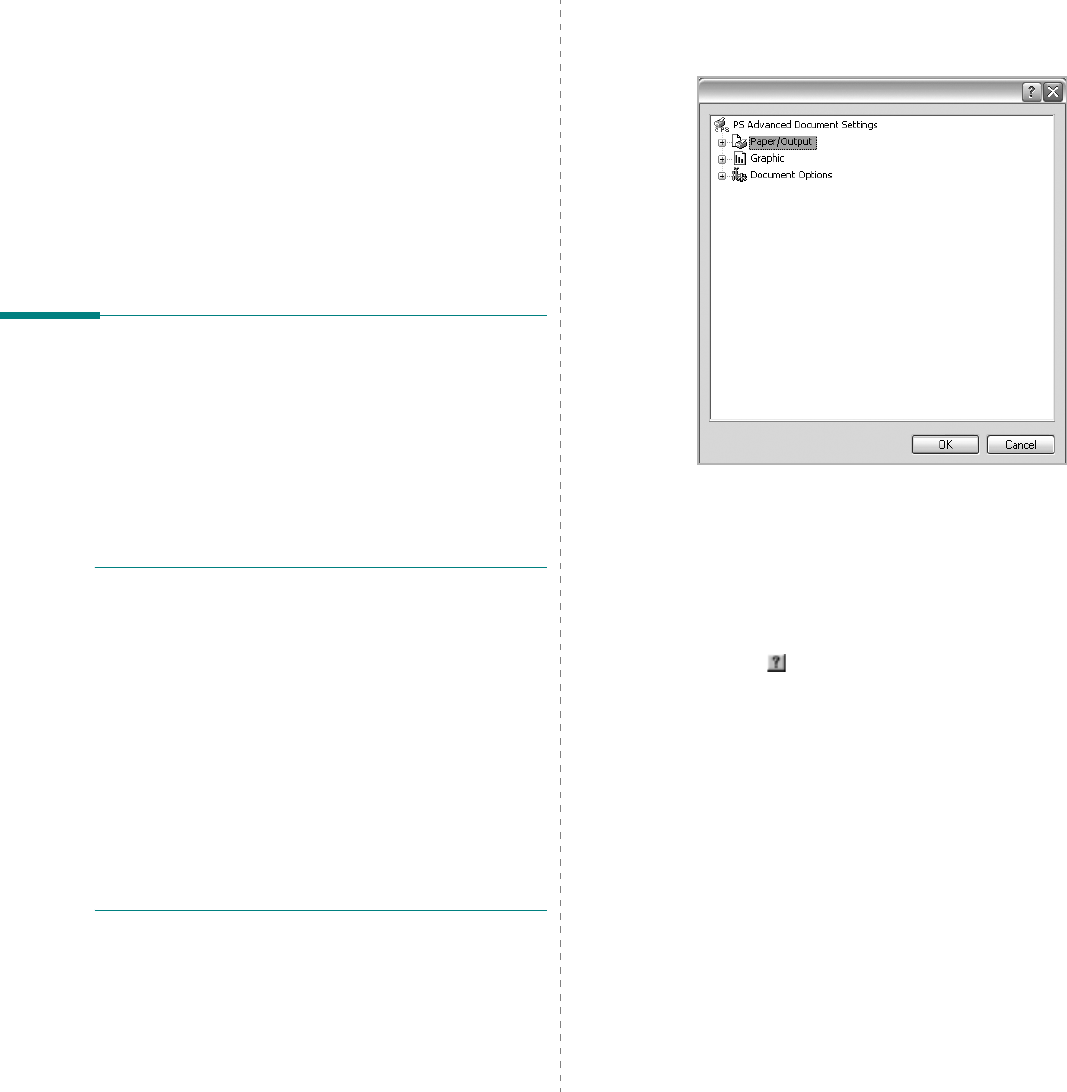
Using Windows PostScript Driver
23
4Using Windows
PostScript Driver
If you want to use the PostScript driver provided with your
system CD-ROM to print a document.
PPDs, in combination with the PostScript driver, access printer
features and allow the computer to communicate with the
printer. An installation program for the PPDs is provided on the
supplied software CD-ROM.
This chapter includes:
Printer Settings
You can use the printer properties window, which allows you to
access all of the printer options you need when using your
printer. When the printer properties are displayed, you can
review and change the settings needed for your print job.
Your printer properties window may differ, depending on your
operating system. This Software User’s Guide shows the
Properties window for Windows XP.
Your printer driver
Properties
window that appears in this
User’s Guide may differ depending on the printer in use.
N
OTES
:
• Most Windows applications will override settings you specify
in the printer driver. Change all print settings available in the
software application first, and change any remaining settings
using the printer driver.
• The settings you change remain in effect only while you are
using the current program.
To make your changes
permanent
, make them in the Printers folder.
• The following procedure is for Windows XP. For other
Windows OS, refer to the corresponding Windows User's
Guide or online help.
1. Click the Windows
Start
button.
2. Select Printers and Faxes.
3. Select your printer driver icon.
4. Right-click on the printer driver icon and select
Printing Preferences.
5. Change the settings on each tab, click OK.
Advanced
You can use advanced settings by clicking the
Advanced
button.
•
Paper/Output
this option allows you to select the size of the
paper loaded in the tray.
•
Graphic
this option allows you to adjust the print quality for
your specific printing needs.
•
Document Options
this options allow you to set the PostScript
options or printer features.
Using Help
You can click from the upper right corner of the window, and
then click on any setting.

Sharing the Printer Locally
24
5Sharing the Printer
Locally
You can connect the printer directly to a selected computer,
which is called “host computer,” on the network.
The following procedure is for Windows XP. For other Windows
OS, refer to the corresponding Windows User's Guide or online
help.
N
OTES
:
• Check the Operating System(s) that are compatible with
your printer. Please refer to the OS Compatibility section of
Printer Specifications in your Printer User’s Guide.
• If you need to know the exact name of your printer, you can
check the supplied CD-ROM.
Setting Up a Host Computer
1
Start Windows.
2
From the
Start
menu select
Printers and Faxes
.
3
Double-click
your printer driver icon
.
4
From the
Printer
menu, select
Sharing
.
5
Check the
Share this printer
box.
6
Fill in the
Shared Name
field, and then click
OK
.
Setting Up a Client Computer
1
Right-click the Windows
Start
button and select
Explorer
.
2
Open your network folder in the left column.
3
Click the shared name.
4
From the
Start
menu select
Printers and Faxes
.
5
Double-click
your printer driver icon
.
6
From the
Printer
menu, select
Properties
.
7
From the
Ports
tab, click
Add Port
.
8
Select
Local Port
and click
New Port
.
9
Fill in the
Enter a port name
field with the shared name.
10
Click
OK
and click
Close
.
11
Click
Apply
and click
OK
.
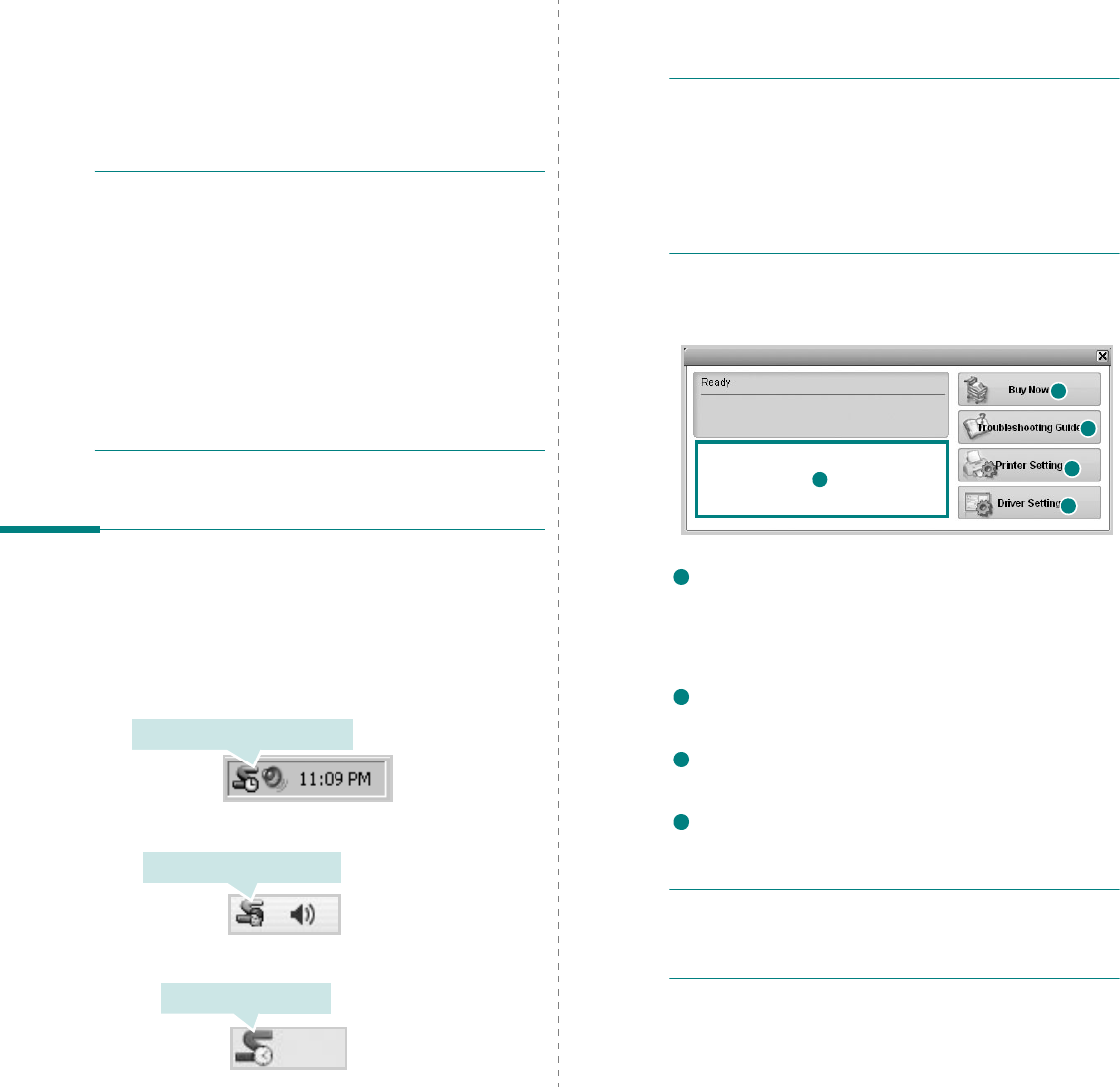
Using Smart Panel
25
6Using Smart Panel
Smart Panel is a program that monitors and informs you of the
status of the printer, and allows you to customize the printer’s
settings.
Smart Panel
is installed automatically when you
install the printer software.
N
OTES
:
• To use this program, you need:
- Windows 98 or higher (Windows NT 4.0 can be used only
for network-supported printers.) To check for Operating
System(s) that are compatible with your printer, refer to
Printer Specifications in your Printer User’s Guide.
- Mac OS X 10.3 or higher
- Linux. To check for Linux systems that are compatible with
your printer, refer to Printer Specifications in your Printer
User’s Guide.
- Internet Explorer version 5.0 or higher for flash animation
in HTML Help.
• If you need to know the exact name of your printer, you can
check the supplied CD-ROM.
Understanding Smart Panel
If an error occurs while printing, Smart Panel appears
automatically, showing the error.
You can also launch Smart Panel manually. Double-click the
Smart Panel icon on the Windows task bar (in Windows), or
Notification Area (in Linux). You can also click it on the status
bar (in Mac OS X).
Double-click this icon in Windows.
Click this icon in Mac OS X.
Click this icon in Linux.
If you are a Windows user, from the
Start
menu, select
Programs
or
All Programs
→
your printer driver name
→
Smart Panel
.
N
OTES
:
• If you have already installed more than one Samsung
printer, first select the printer model you want in order to
use the corresponding Smart Panel. Right-click (in Windows
or Linux) or click (in Mac OS X) the Smart Panel icon and
select
your printer name
.
• The Smart Panel window and its contents shown in this
Software User’s Guide may differ depending on the printer or
Operating System in use.
The Smart Panel program displays the current status of the
printer, the level of toner remaining in the toner cartridge(s)
and various other information. You can also change settings.
Toner Level
You can view the level of toner remaining in the toner
cartridge(s). The printer and the number of toner cartridge(s)
shown in the above window may differ depending on the printer in
use. Any printers do not have this feature.
Buy Now
You can order replacement toner cartridge(s) online.
Troubleshooting Guide
You can view Help to solve problems.
Printer Setting
You can configure various printer settings in the Printer Settings
Utility window. Any printers do not have this feature.
N
OTE
:
If your printer is connected to a network and you are a
Windows user, the
SyncThru Web Service
window appears
instead of the Printer Settings Utility window. Mac OS X and
Linux do not support network environments.
2
4
1
5
3
1
2
3
4
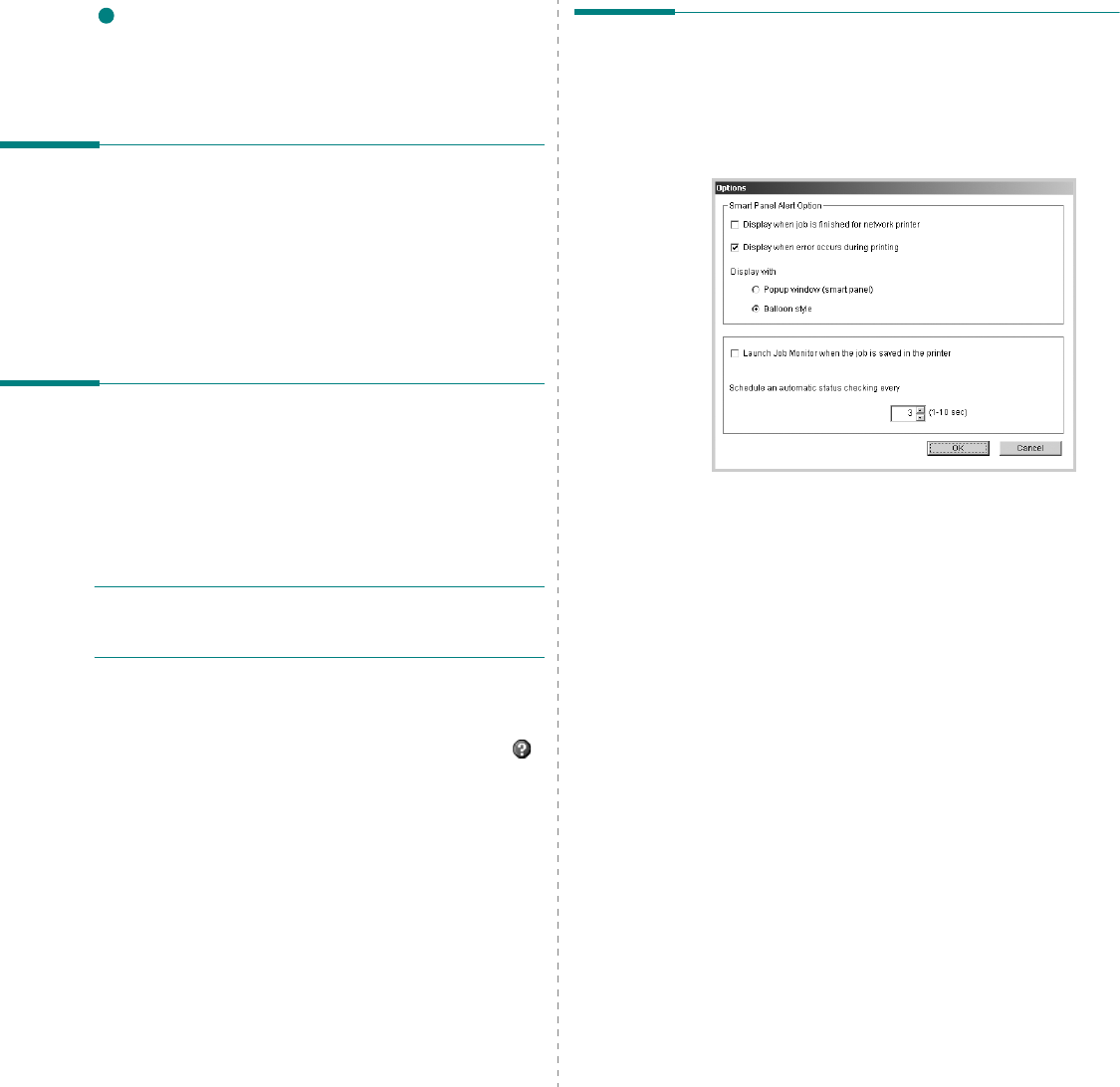
Using Smart Panel
26
Driver Setting (Only for Windows)
You can use the printer properties window, which allows you to
access all of the printer options you need for using your
printer.
For details,
See “Printer Settings” on page 13.
Opening the Troubleshooting
Guide
Using the troubleshooting guide, you can view solutions for
error status problems.
Right-click (in Windows or Linux) or click (in Mac OS X) the
Smart Panel icon and select
Troubleshooting Guide
.
Using Printer Settings Utility
Using the Printer Settings Utility, you can configure and check
print settings.
1
Right-click (in Windows or Linux) or click (in Mac OS X) the
Smart Panel icon and select
Printer Setting
.
2
Change the settings.
3
To send the changes to the printer, click the
Apply
button.
N
OTES
:
If your printer is connected to a network, the
SyncThru Web Service
window appears instead of the
Printer Settings Utility window.
Using Onscreen Help File
For more information about
Printer Settings Utility
, click .
5
Changing the Smart Panel
Program Settings
Right-click (in Windows or Linux) or click (in Mac OS X) the
Smart Panel icon and select
Options
.
The following window opens.
•
Display when job is finished for network printer
: The
computer shows the Smart Panel popup window or
balloon when your job is complete in Windows.
(Only for
Windows network-supported printers.)
•
Display when error occurs during printing
: The
computer shows the Smart Panel popup window or
balloon when an error occurs during printing.
•
Display with
: You can select how the computer shows
you a message. If you select
Popup window (smart
panel)
, the message appears in the Smart Panel popup
window in Windows and Mac OS X.
•
Launch Job Monitor when the job is saved in the
printer
: If you store print jobs on the printer’s hard disk,
the computer opens the Job Monitor window in Windows.
(Only for Windows network-supported printers with
built-in hard disks.)
•
Schedule an automatic status checking every
: The
computer updates the printer status regularly. Setting the
value close to 1 second causes the computer to check the
printer status more frequently, thereby allowing a faster
response to any printer error.
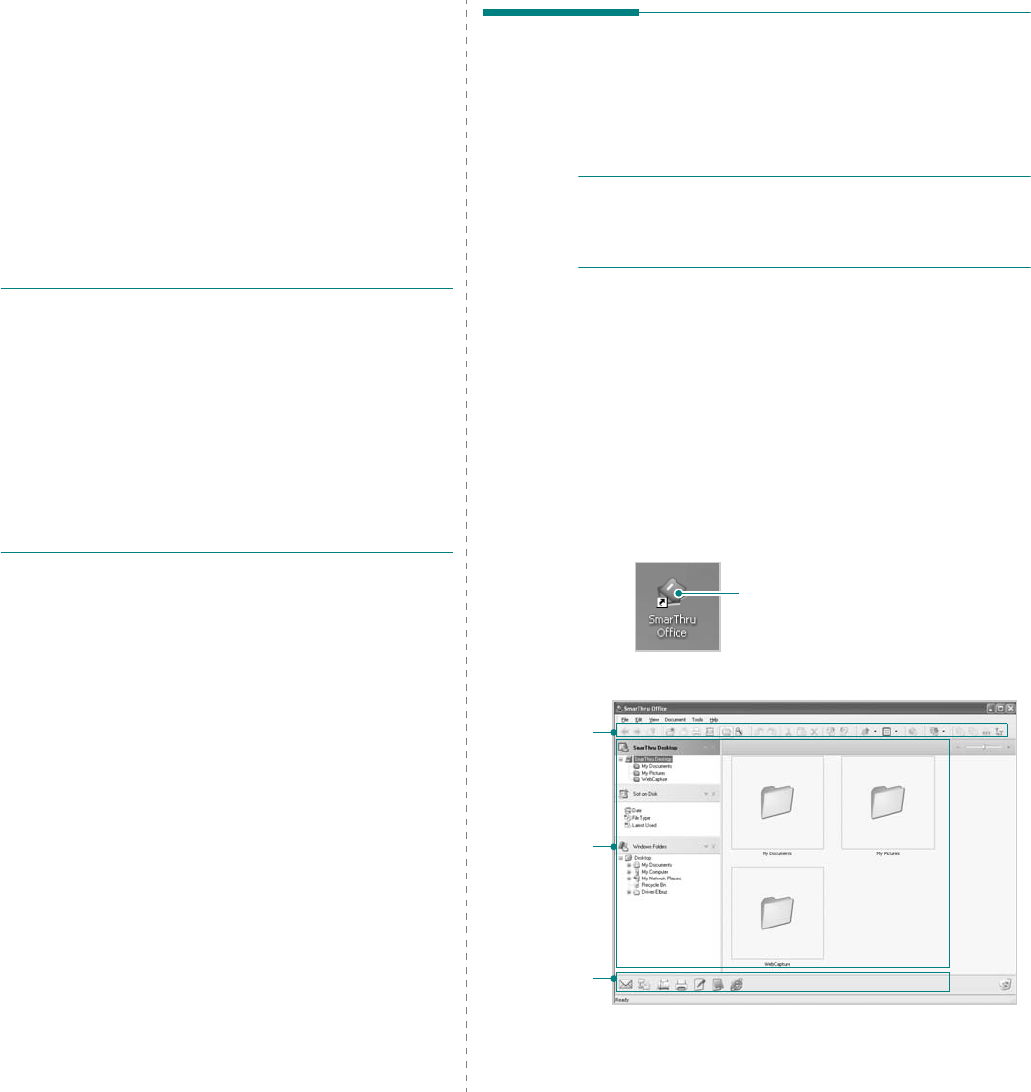
Scanning
27
7Scanning
Scanning with your machine lets you turn pictures and text into
digital files on your computer. Then you can fax or e-mail the
files, display them on your web site or use them to create
projects that you can print using Samsung SmarThru software
or the WIA driver.
This chapter includes:
• Scanning Using Samsung SmarThru Office
• Scanning Process with TWAIN-enabled Software
• Scanning Using the WIA
N
OTES
:
• Check the Operating System(s) that are compatible
with your printer. Please refer to the OS Compatibility
section of Printer Specifications in your Printer User’s
Guide.
• You can check your printer name in the supplied CD-
ROM.
• The maximum resolution that can be achieved
depends upon various factors, including computer
speed, available disk space, memory, the size of the
image being scanned, and bit depth settings. Thus,
depending on your system and what you are scanning,
you may not be able to scan at certain resolutions,
especially using enhanced dpi.
Scanning Using Samsung
SmarThru Office
Samsung SmarThru Office is the accompanying software for
your machine. You can use SmarThru Office to scan images or
documents from local or network scanners.
N
OTE
: You can use indexing and searching functions using
SmarThru Office supported by Microsoft Indexing Service.
This service is supported in Windows 2000 or above, so that
Windows 98/ Me/ NT user can not use these functions.
Using Samsung SmarThru Office
Follow these steps to start scanning using the SmarThru Office:
1
Make sure that your machine and computer are turned on
and properly connected to each other.
2
Place your photograph or page on the document glass or
ADF.
3
Once you have installed Samsung SmarThru, you will see
the
SmarThru Office
icon on your desktop. Double-click
the
SmarThru Office
icon.
The
SmarThru Office
window opens.
•
Tool bar
: Allows you to use shortcut icons which activate
the certain functions such as
Scan
,
Search
, etc.
Double-click this icon.
Tool bar
Working area
Send to bar
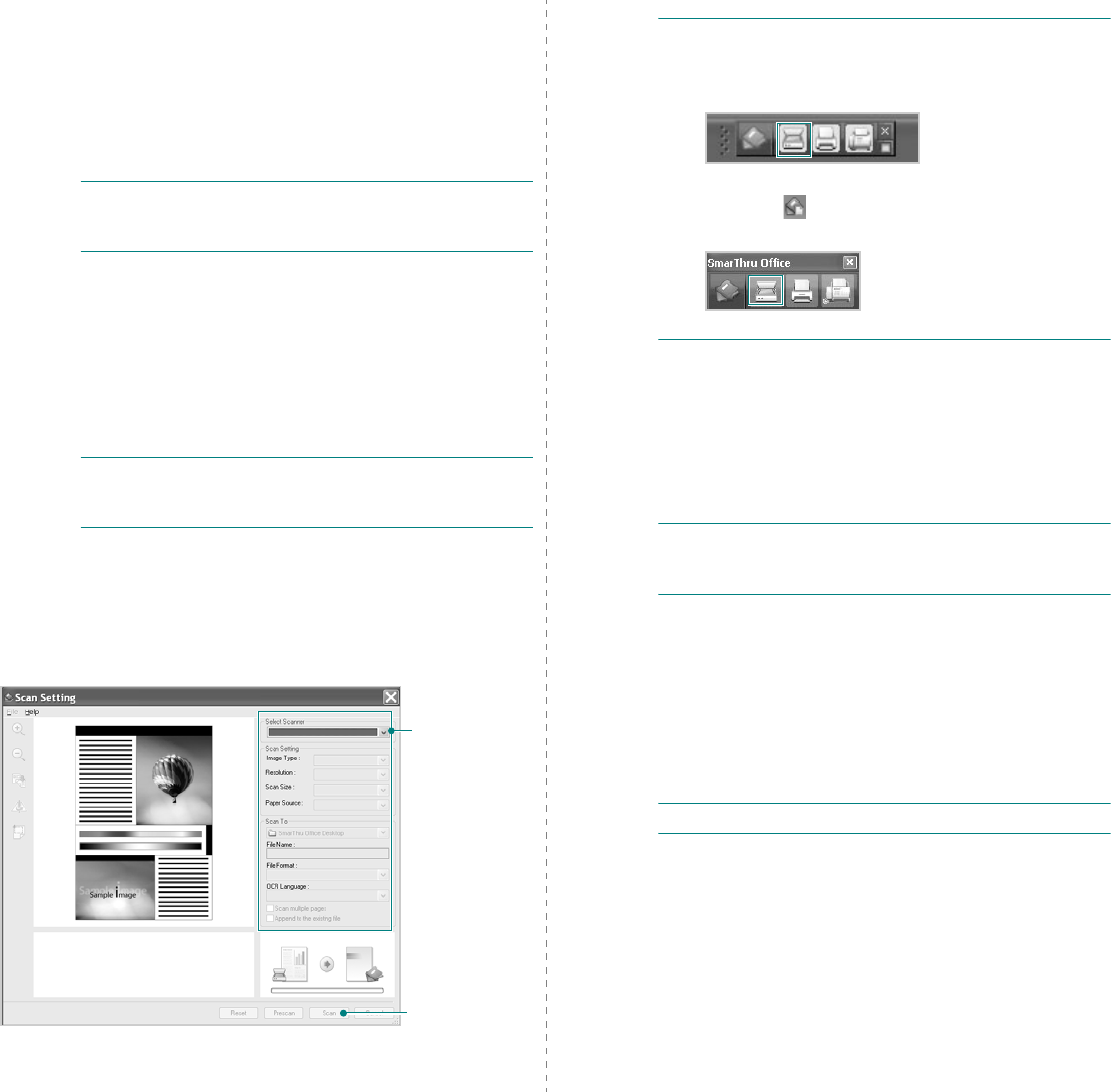
Scanning
28
•Working area
-
SmarThru Desktop
: Created within the standard
Windows folder My Documents.
-
Sort on Disk
: Files of the folders which are not indexed
will not be displayed in the Sort on Disk section. Sort type
are Date, File Types, Latest Used.
To add a folder for indexing, press
Edit
menu
→
Preferences
→
Index
.
N
OTE
: It may take longer time to show the added file folders
according to the computer performance and the number of
added file folders.
-
Windows Folders
: Allow user to navigate through all
the user’s files and folders.
- The right panel: Reflects the content of a selected folder.
•
Send to bar:
Run the corresponding application directly.
Drag and drop selected files to the appropriate
application button.
-
Send by E-mail
: To send documents by E-mail while
working within the SmarThru Office.
N
OTE
: To send scanned images or documents by e-mail, you
must have a mail client program, like Outlook Express, which
has been set up with your e-mail account.
-
Send by FTP
: To upload a document file to server while
working within the SmarThru Office.
-
Send by Fax
: To send documents by Local or Network
fax machine while working within the SmarThru Office.
4
Click
Scan
on the tool bar of
SmarThru Office
window.
Adjust the scan
settings.
Click to start
scanning.
N
OTES
:
• In Windows XP operating system, you can use SmarThru
Office launcher, which is on the right end of taskbar, to open
the
Scan Setting
window easily.
• In other operating systems beside Windows XP, click the
SmarThru icon in the tray area of the windows taskbar
to activate the SmarThru Office launcher.
Scan Setting
lets you use the following services:
•
Select Scanner:
Select the Local or Network scanner.
- Local Scan: After scanning with parallel port or USB port,
you can store the scanned output in image or document
file.
- Network Scan: After scanning via network, you can store
the scanned output in jpeg, tiff, or pdf file.
N
OTE
: To use network scanner, your computer should install
the
Network Scan Manager
and register the scanner within
that program. Refer to Scanning chapter in user's guide.
•
Scan Setting
Allows you to customize settings for Image type,
Resolution, Scan Size, Paper Source.
•
Scan To
Allows you to customize settings for File Name, File
Format, OCR Language.
5
To start scanning, click
Scan
.
N
OTE
: If you want to cancel the scan job, click
Cancel
.
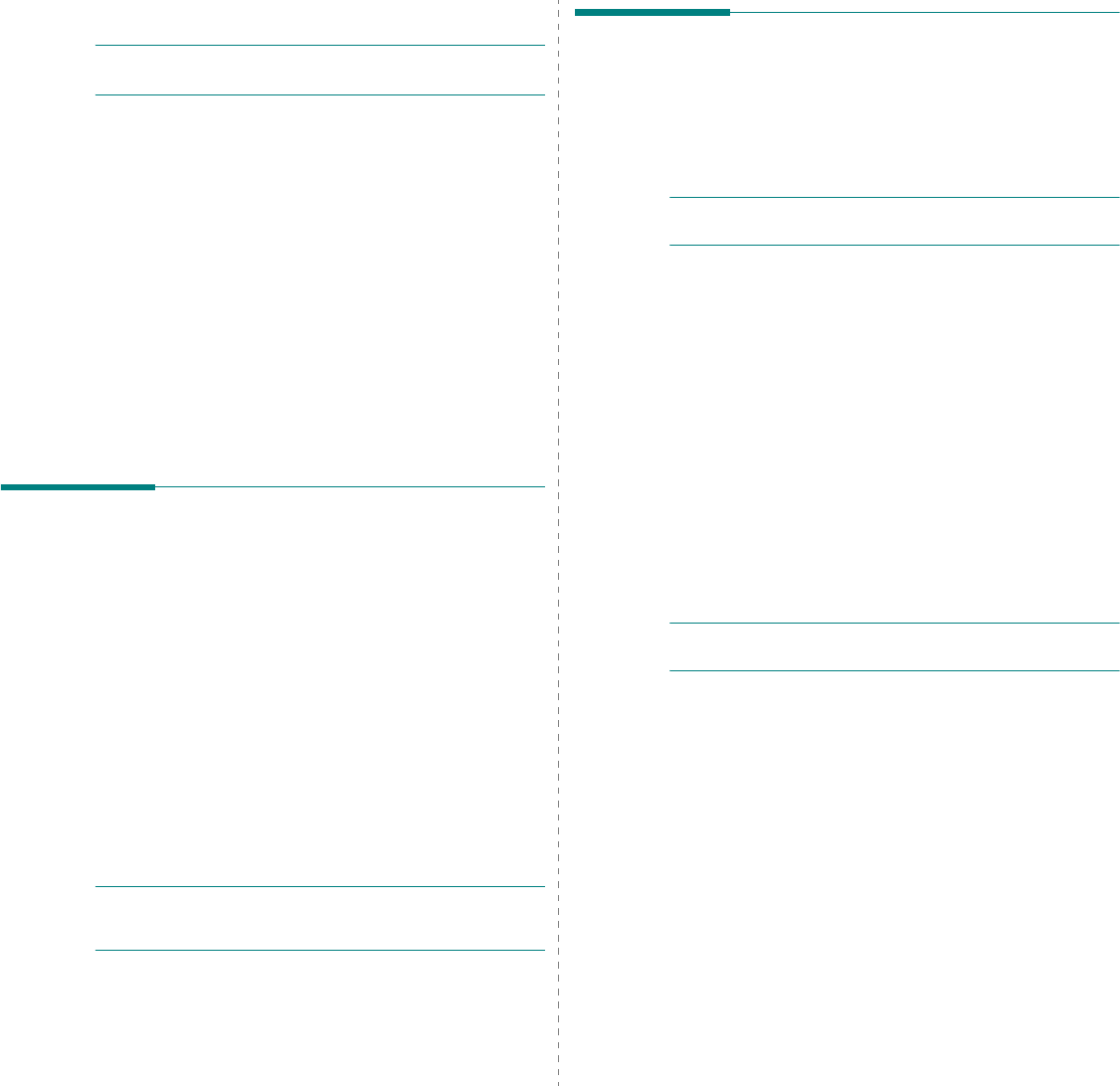
Scanning
29
Uninstalling Samsung SmarThru Office
N
OTE
: Before beginning uninstallation, ensure that all
applications are closed on your computer.
1
From the
Start
menu, select
Programs
.
2
Select
SmarThru Office
, and then select
Uninstall
SmarThru Office
.
3
When your computer asks you to confirm, read the
statement and click
OK
.
4
Click
Finish
.
Using Onscreen Help File
For more information about SmarThru, click Help menu at the
top right corner of the window. The SmarThru Help window
opens and allows you to view onscreen help supplied on the
SmarThru program.
Scanning Process with TWAIN-
enabled Software
If you want to scan documents using other software, you will
need to use TWAIN-compliant software, such as Adobe
PhotoDeluxe or Adobe Photoshop. The first time you scan with
your machine, select it as your TWAIN source in the application
you use.
The basic scanning process involves a number of steps:
1
Make sure that your machine and computer are turned on
and properly connected to each other.
2
Load originals face up into the ADF, or place a single
original face down on the scanner glass.
3
Open an application, such as PhotoDeluxe or Photoshop.
4
Open the TWAIN window and set the scan options.
5
Scan and save your scanned image.
N
OTE
: You need to follow the program’s instructions for
acquiring an image. Please refer to the user’s guide of the
application.
Scanning Using the WIA
Your machine also supports the Windows Image Acquisition
(WIA) driver for scanning images. WIA is one of the standard
components provided by Microsoft
£
Windows
£
XP and works
with digital cameras and scanners. Unlike the TWAIN driver, the
WIA driver allows you to scan and easily manipulate images
without using additional software.
N
OTE
: The WIA driver works only on Windows XP with USB
port.
1
Load the document(s) face up into the ADF.
OR
Place a single document face down on the document
glass.
2
From the
Start
menu on your desktop window, select
Settings
,
Control Panel
, and then
Scanners and
Cameras
.
3
Double click
your scanner driver
icon. The Scanner and
Camera Wizard launches.
4
Choose your scanning preferences and click
Preview
to
see how your preferences affect the picture.
5
Click
Next
.
6
Enter a picture name, and select a file format and
destination to save the picture.
7
Follow the on-screen instructions to edit the picture after it
is copied to your computer.
N
OTE
: If you want to cancel the scan job, press the Cancel
button on the Scanner and Camera Wizard.
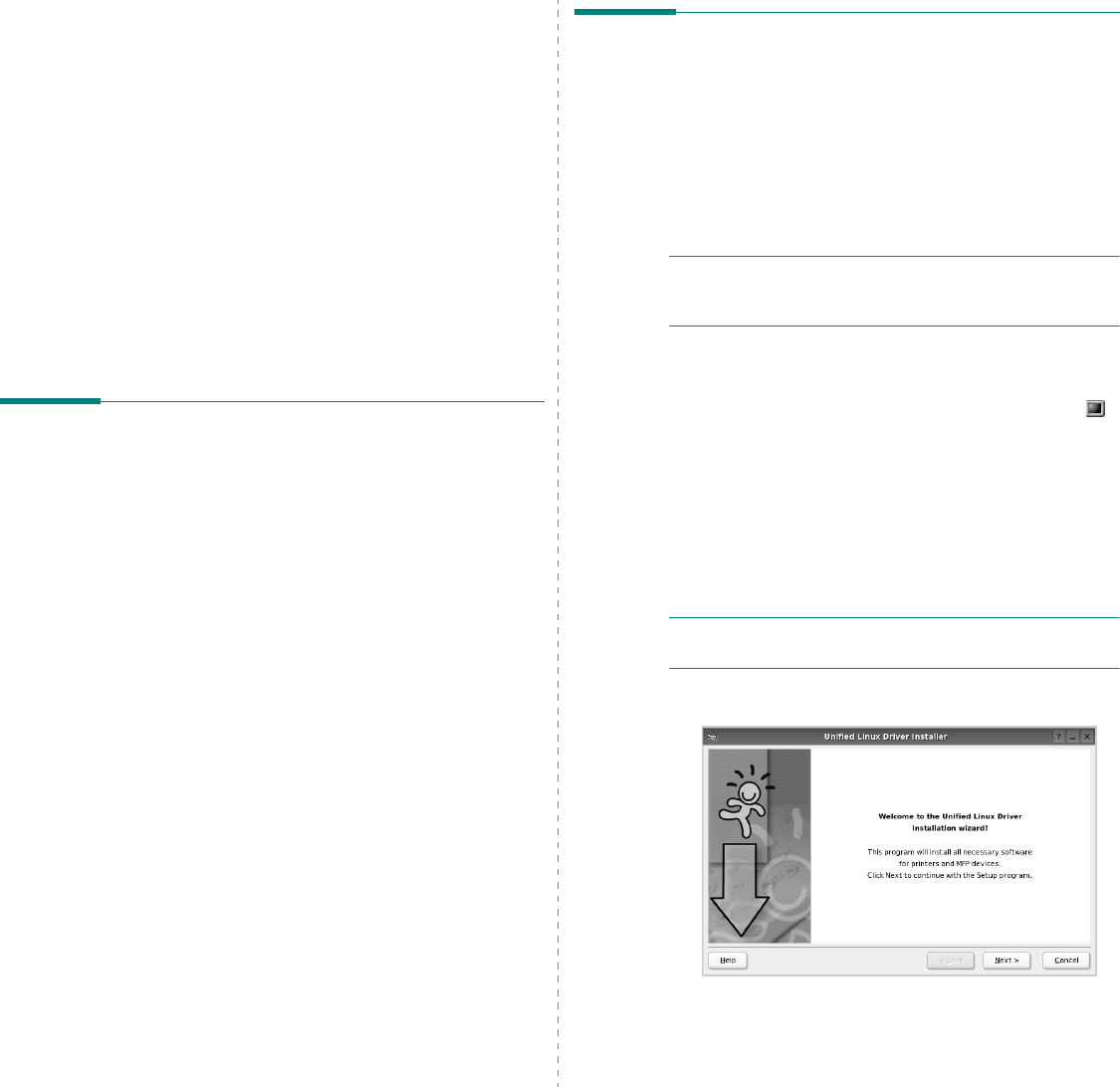
Using Your Printer in Linux
30
8Using Your Printer in
Linux
You can use your machine in a Linux environment.
This chapter includes:
• Getting Started
• Installing the Unified Linux Driver
• Using the Unified Driver Configurator
• Configuring Printer Properties
• Printing a Document
• Scanning a Document
Getting Started
The supplied CD-ROM provides you with Samsung’s Unified
Linux Driver package for using your machine with a Linux
computer.
Samsung’s Unified Linux Driver package contains printer and
scanner drivers, providing the ability to print documents and
scan images. The package also delivers powerful applications
for configuring your machine and further processing of the
scanned documents.
After the driver is installed on your Linux system, the driver
package allows you to monitor a number of machine devices via
fast ECP parallel ports and USB simultaneously.
The acquired documents can then be edited, printed on the
same local or network machine devices, sent by e-mail,
uploaded to an FTP site, or transferred to an external OCR
system.
The Unified Linux Driver package is supplied with a smart and
flexible installation program. You don't need to search for
additional components that might be necessary for the Unified
Linux Driver software: all required packages will be carried onto
your system and installed automatically; this is possible on a
wide set of the most popular Linux clones.
Installing the Unified Linux
Driver
Installing the Unified Linux Driver
1
Make sure that you connect your machine to your
computer. Turn both the computer and the machine on.
2
When the Administrator Login window appears, type in
root
in the Login field and enter the system password.
N
OTE
: You must log in as a super user (root) to install the
printer software. If you are not a super user, ask your system
administrator.
3
Insert the printer software CD-ROM. The CD-ROM will
automatically run.
If the CD-ROM does not automatically run, click the
icon at the bottom of the desktop. When the Terminal
screen appears, type in:
If the CD-ROM is secondary master and the location to
mount is /mnt/cdrom,
[root@localhost root]#mount -t iso9660 /dev/hdc /mnt/
cdrom
[root@localhost root]#cd /mnt/cdrom/Linux
[root@localhost root]#./install.sh
N
OTE
: The installation program runs automatically if you
have an autorun software package installed and configured.
4
When the welcome screen appears, click
Next
.
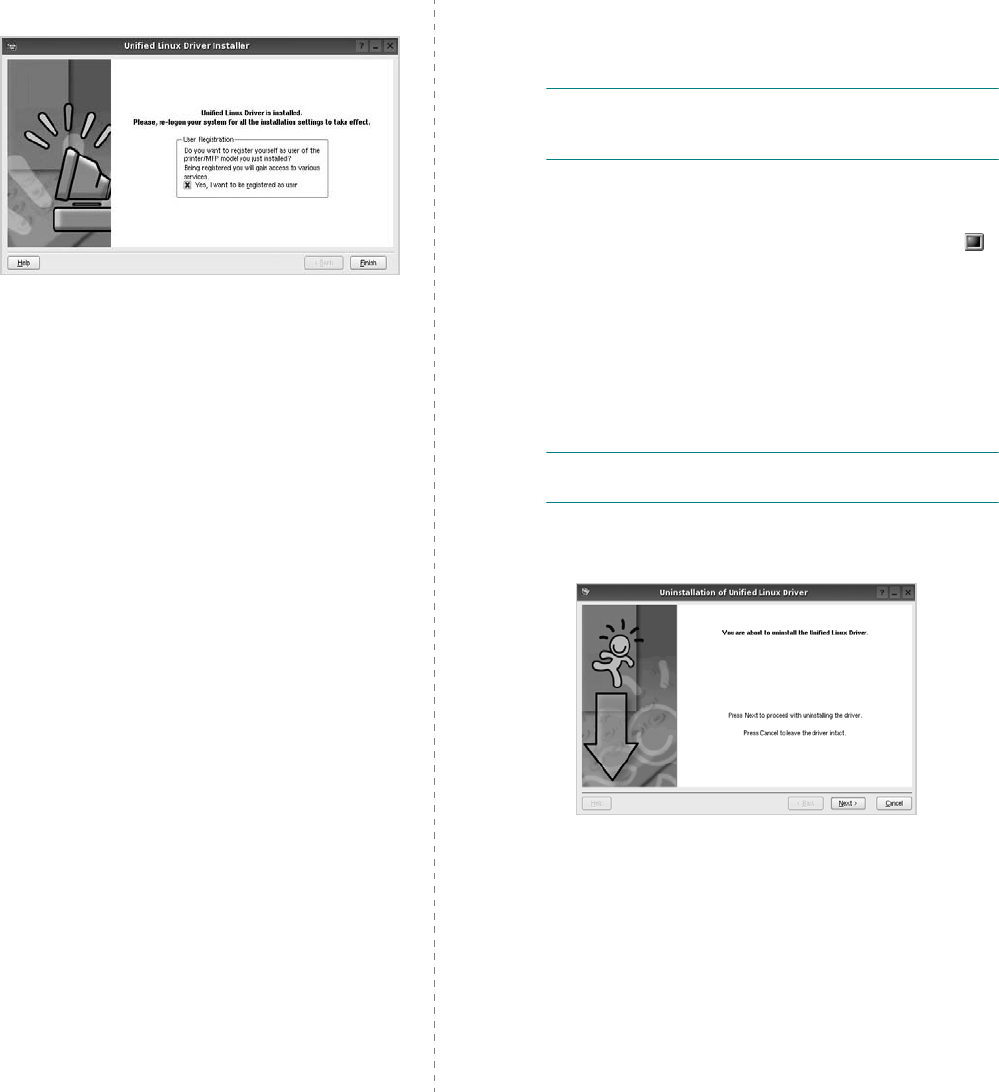
Using Your Printer in Linux
31
5
When the installation is complete, click
Finish
.
The installation program has added the Unified Driver
Configurator desktop icon and Samsung Unified Driver
group to the system menu for your convenience. If you
have any difficulties, consult the onscreen help that is
available through your system menu or can otherwise be
called from the driver package windows applications,
such as
Unified Driver Configurator
or
Image
Manager
.
Uninstalling the Unified Linux Driver
1
When the Administrator Login window appears, type in
root
in the Login field and enter the system password.
N
OTE
: You must log in as a super user (root) to install the
printer software. If you are not a super user, ask your system
administrator.
2
Insert the printer software CD-ROM. The CD-ROM will
automatically run.
If the CD-ROM does not automatically run, click the
icon at the bottom of the desktop. When the Terminal
screen appears, type in:
If the CD-ROM is secondary master and the location to
mount is /mnt/cdrom,
[root@localhost root]#mount -t iso9660 /dev/hdc /mnt/
cdrom
[root@localhost root]#cd /mnt/cdrom/Linux
[root@localhost root]#./uninstall.sh
N
OTE
: The installation program runs automatically if you
have an autorun software package installed and configured.
3
Click
Uninstall
.
4
Click
Next
.
5
Click
Finish
.
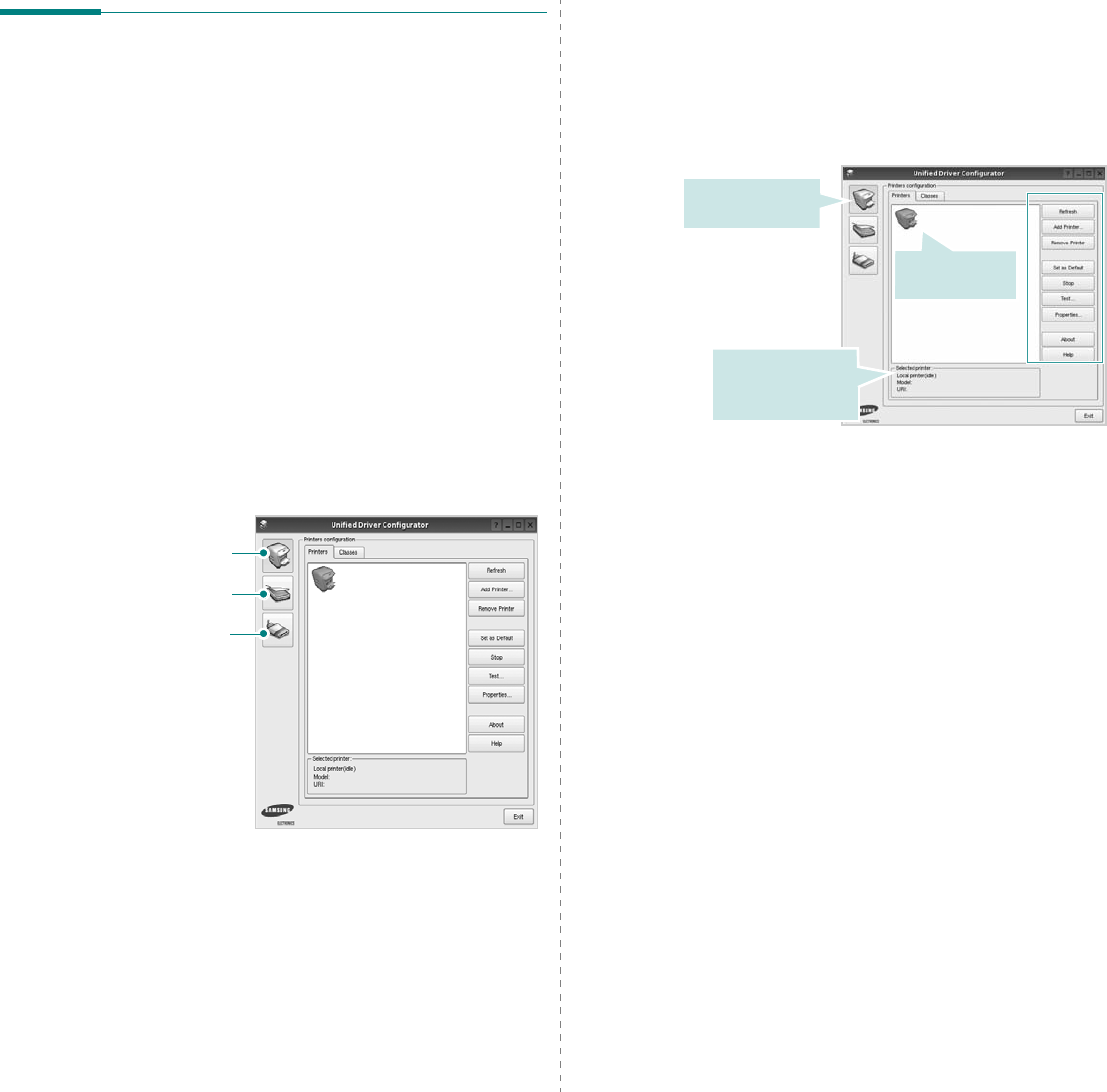
Using Your Printer in Linux
32
Using the Unified Driver
Configurator
Unified Linux Driver Configurator is a tool primarily intended for
configuring Printer or MFP devices. Since an MFP device
combines the printer and scanner, the Unified Linux Driver
Configurator provides options logically grouped for printer and
scanner functions. There is also a special MFP port option
responsible for the regulation of access to an MFP printer and
scanner via a single I/O channel.
After installing the Unified Linux driver, the Unified Linux Driver
Configurator icon will automatically be created on your desktop.
Opening the Unified Driver
Configurator
1
Double-click
Unified Driver Configurator
on the
desktop.
You can also click the Startup Menu icon and select
Samsung Unified Driver
and then
Unified Driver
Configurator
.
2
Press each button on the Modules pane to switch to the
corresponding configuration window.
You can use the onscreen help by clicking
Help
.
3
After changing the configurations, click
Exit
to close the
Unified Driver Configurator.
Printers Configuration button
Scanners Configuration button
(for MFP device only)
Ports Configuration button
Printers Configuration
Printers configuration has the two tabs:
Printers
and
Classes
.
Printers Tab
You can see the current system’s printer configuration by
clicking on the printer icon button on the left side of the Unified
Driver Configurator window.
You can use the following printer control buttons:
•
Refresh
: renews the available printers list.
•
Add Printer
: allows you to add a new printer.
•
Remove Printer
: removes the selected printer.
•
Set as Default
: sets the current printer as a default
printer.
•
Stop
/
Start
: stops/starts the printer.
•
Test
: allows you to print a test page to check if the
machine is working properly.
•
Properties
: allows you to view and change the printer
properties. For details, see page 34.
Shows all of the
installed printer.
Switches to Printer
configuration.
Shows the status,
model name and
URI of your printer.
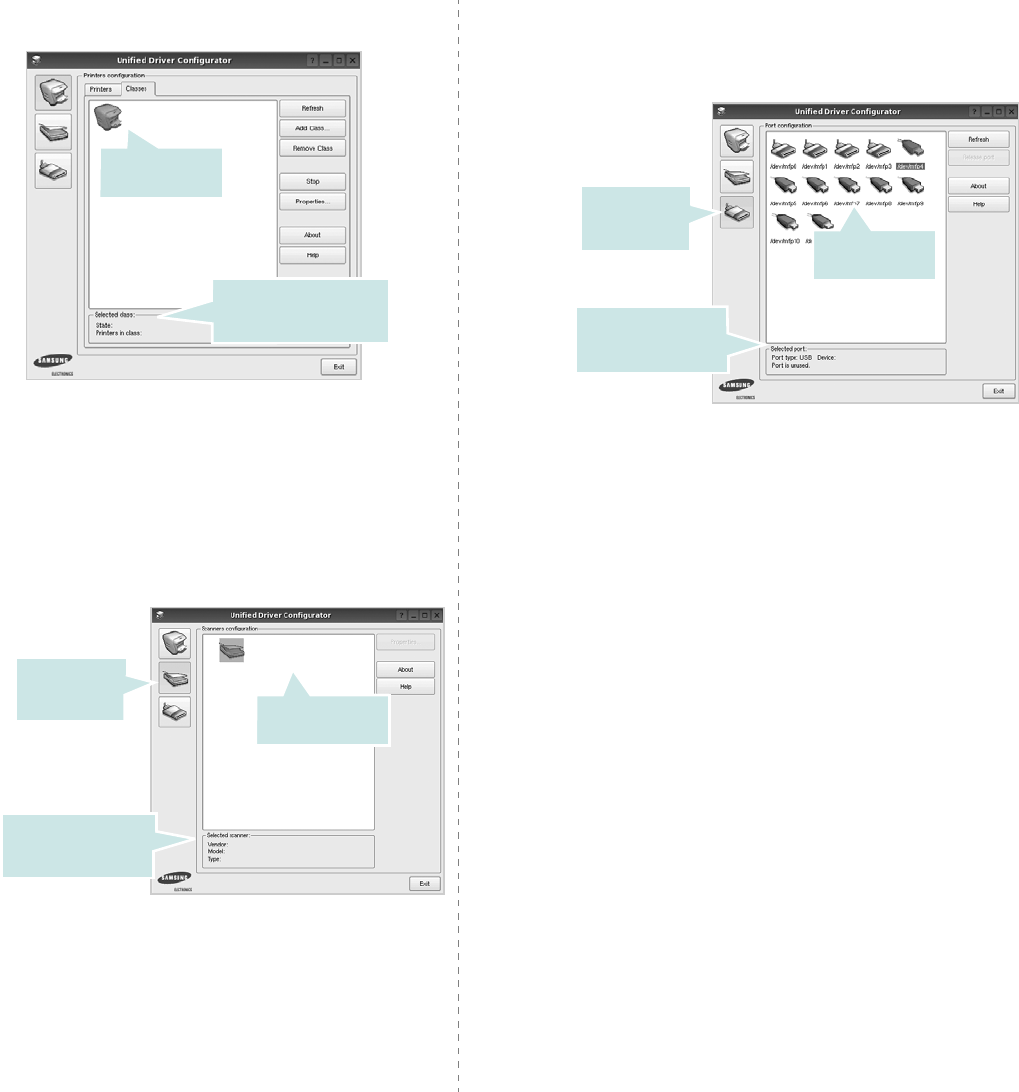
Using Your Printer in Linux
33
Classes Tab
The Classes tab shows a list of available printer classes.
•
Refresh
: Renews the classes list.
•
Add Class... :
Allows you to add a new printer class.
•
Remove Class :
Removes the selected printer class.
Scanners Configuration
In this window, you can monitor the activity of scanner devices,
view a list of installed Samsung MFP devices, change device
properties, and scan images.
•
Properties...
: Allows you to change the scan properties
and scan a document. See page 35.
•
Drivers... :
Allows you to monitor the activity of the scan drivers.
Shows the status of the
class and the number of
printers in the class.
Shows all of the
printer classes.
Switches to
Scanners
configuration. Shows all of the
installed scanners.
Shows the vendor,
model name and type
of your scanner.
Ports Configuration
In this window, you can view the list of available ports, check
the status of each port and release a port that is stalled in busy
state when its owner is terminated for any reason.
•
Refresh
: Renews the available ports list.
•
Release port :
Releases the selected port.
Sharing Ports Between Printers and Scanners
Your machine may be connected to a host computer via the
parallel port or USB port. Since the MFP device contains more
than one device (printer and scanner), it is necessary to
organize proper access of “consumer” applications to these
devices via the single I/O port.
The Samsung Unified Linux Driver package provides an
appropriate port sharing mechanism that is used by Samsung
printer and scanner drivers. The drivers address their devices
via so-called MFP ports. The current status of any MFP port can
be viewed via the Ports Configuration. The port sharing
prevents you from accessing one functional block of the MFP
device, while another block is in use.
When you install a new MFP device onto your system, it is
strongly recommended you do this with the assistance of an
Unified Driver Configurator. In this case you will be asked to
choose I/O port for the new device. This choice will provide the
most suitable configuration for MFP’s functionality. For MFP
scanners I/O ports are being chosen by scanner drivers
automatically, so proper settings are applied by default.
Switches to
ports
configuration.
Shows the port type,
device connected to
the port and status
Shows all of the
available ports.
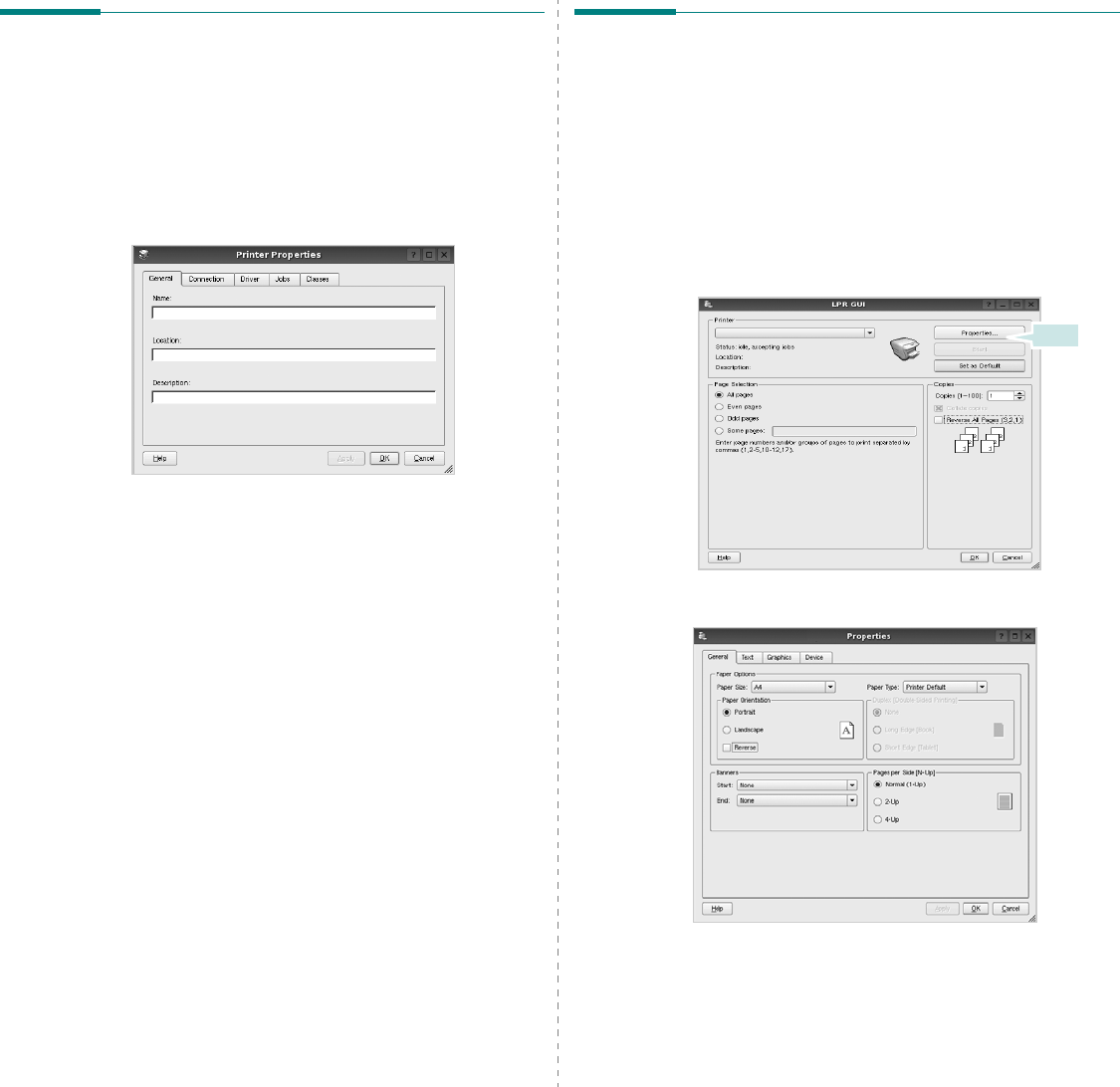
Using Your Printer in Linux
34
Configuring Printer Properties
Using the properties window provided by the Printers
configuration, you can change the various properties for your
machine as a printer.
1
Open the Unified Driver Configurator.
If necessary, switch to Printers configuration.
2
Select your machine on the available printers list and click
Properties
.
3
The Printer Properties window opens.
The following five tabs display at the top of the window:
•
General
: allows you to change the printer location and
name. The name entered in this tab displays on the
printer list in Printers configuration.
•
Connection
: allows you to view or select another port. If
you change the printer port from USB to parallel or vice
versa while in use, you must re-configure the printer port
in this tab.
•
Driver
: allows you to view or select another printer
driver. By clicking
Options
, you can set the default
device options.
•
Jobs
: shows the list of print jobs. Click
Cancel job
to
cancel the selected job and select the
Show completed
jobs
check box to see previous jobs on the job list.
•
Classes
: shows the class that your printer is in. Click
Add to Class
to add your printer to a specific class or
click
Remove from Class
to remove the printer from the
selected class.
4
Click
OK
to apply the changes and close the Printer
Properties Window.
Printing a Document
Printing from Applications
There are a lot of Linux applications that you are allowed to
print from using Common UNIX Printing System (CUPS). You
can print on your machine from any such application.
1
From the application you are using, select
Print
from the
File
menu.
2
Select
Print
directly using
lpr
.
3
In the LPR GUI window, select the model name of your
machine from the Printer list and click
Properties
.
4
Change the printer and print job properties.
Click.
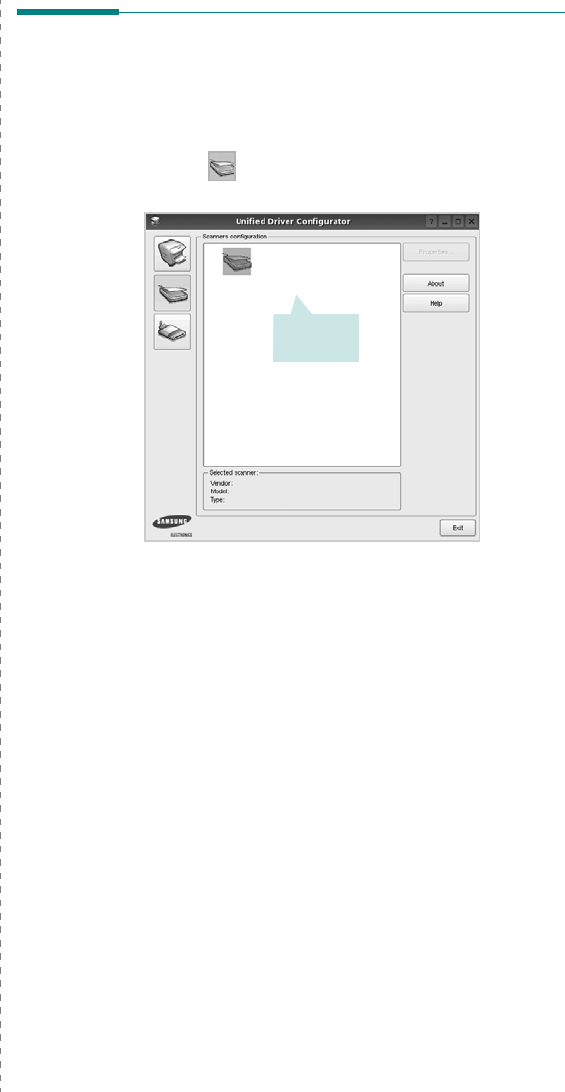
Using Your Printer in Linux
35
The following four tabs display at the top of the window.
•
General
- allows you to change the paper size, the paper
type, and the orientation of the documents, enables the
duplex feature, adds start and end banners, and changes
the number of pages per sheet.
•
Text
- allows you to specify the page margins and set the
text options, such as spacing or columns.
•
Graphics
- allows you to set image options that are used
when printing images/files, such as color options, image
size, or image position.
•
Device
: allows you to set the print resolution, paper
source, and destination.
5
Click
Apply
to apply the changes and close the Properties
window.
6
Click
OK
in the LPR GUI window to start printing.
7
The Printing window appears, allowing you to monitor the
status of your print job.
To abort the current job, click
Cancel
.
Printing Files
You can print many different types of files on the Samsung
machine device using the standard CUPS way - directly from
the command line interface. The CUPS lpr utility allows you do
that. But the drivers package replaces the standard lpr tool by
a much more user-friendly LPR GUI program.
To print any document file:
1
Type
lpr <file_name>
from the Linux shell command
line and press
Enter
. The LPR GUI window appears.
When you type only
lpr
and press
Enter
, the Select
file(s) to print window appears first. Just select any files
you want to print and click
Open
.
2
In the LPR GUI window, select your printer from the list,
and change the printer and print job properties.
For details about the properties window, see page 34.
3
Click
OK
to start printing.
Scanning a Document
You can scan a document using the Unified Driver Configurator
window.
1
Double-click the Unified Driver Configurator on your
desktop.
2
Click the button to switch to Scanners Configuration.
3
Select the scanner on the list.
When you have only one MFP device and it is connected
to the computer and turned on, your scanner appears on
the list and is automatically selected.
If you have two or more scanners attached to your
computer, you can select any scanner to work at any
time. For example, while acquisition is in progress on the
first scanner, you may select the second scanner, set the
device options and start the image acquisition
simultaneously.
4
Click
Properties
.
5
Load the document to be scanned face up into the ADF
(Automatic Document Feeder) or face down on the
document glass.
6
Click
Preview
in the Scanner Properties window.
Click your
scanner.
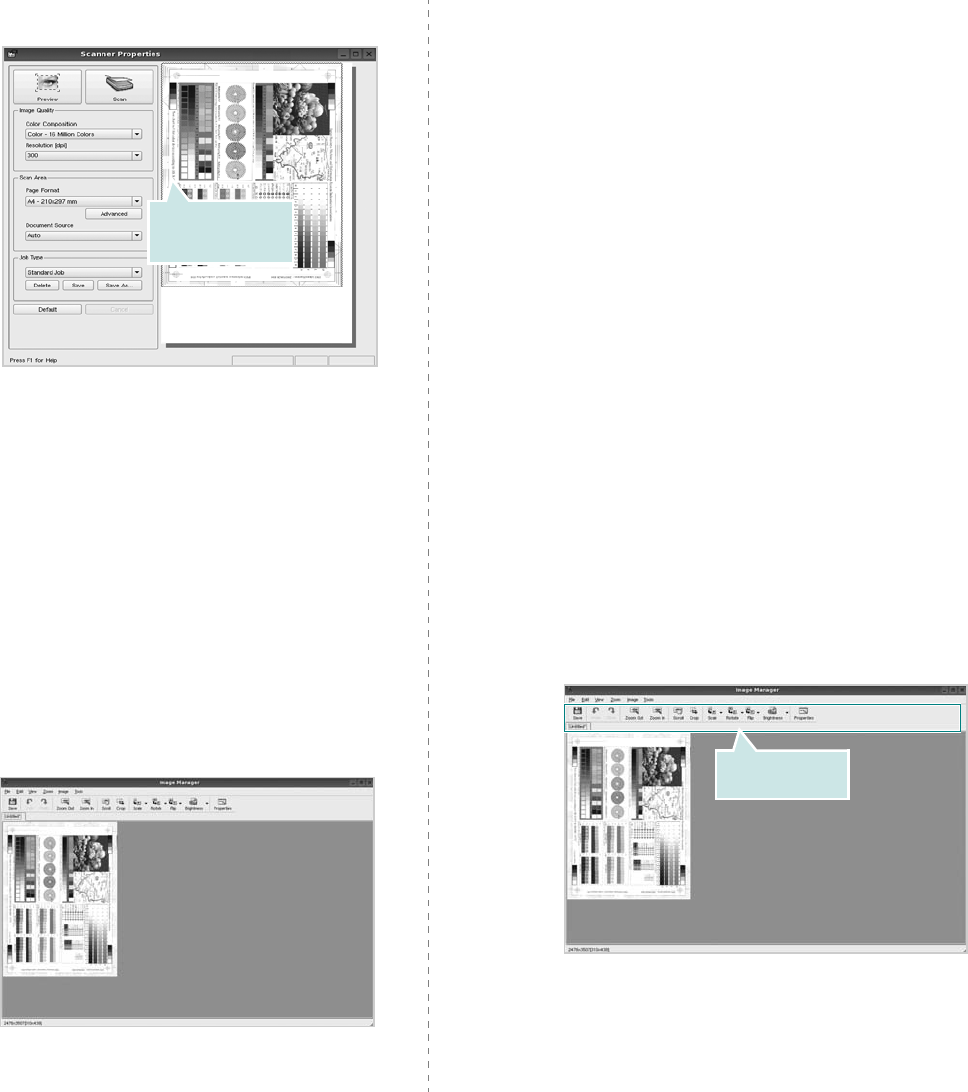
Using Your Printer in Linux
36
The document is scanned and the image preview appears
in the Preview Pane.
7
Change the scan options in the Image Quality and Scan
Area sections.
•
Image Quality
: allows you to select the color
composition and the scan resolution for the image.
•
Scan Area
: allows you to select the page size. The
Advanced
button enables you to set the page size
manually.
If you want to use one of the preset scan option settings,
select from the Job Type drop-down list. For details about
the preset Job Type settings, see page 36.
You can restore the default setting for the scan options
by clicking
Default
.
8
When you have finished, click
Scan
to start scanning.
The status bar appears on the bottom left of the window
to show you the progress of the scan. To cancel scanning,
click
Cancel
.
9
The scanned image appears in the new Image Manager
tab.
If you want to edit the scanned image, use the toolbar.
For further details about editing an image, see page 36.
Drag the pointer to
set the image area
to be scanned.
10
When you are finished, click
Save
on the toolbar.
11
Select the file directory where you want to save the image
and enter the file name.
12
Click
Save
.
Adding Job Type Settings
You can save your scan option settings to retrieve for a later
scanning.
To save a new Job Type setting:
1
Change the options from the Scanner Properties window.
2
Click
Save As
.
3
Enter the name for your setting.
4
Click
OK
.
Your setting is added to the Saved Settings drop-down
list.
To save a Job Type setting for the next scan job:
1
Select the setting you want to use from the Job Type drop-
down list.
2
The next time you open the Scanner Properties window,
the saved setting is automatically selected for the scan
job.
To delete a Job Type setting:
1
Select the setting you want to delete from the Job Type
drop-down list.
2
Click
Delete
.
The setting is deleted from the list
Using the Image Manager
The Image Manager application provides you with menu
commands and tools to edit your scanned image.
Use these tools to
edit the image.
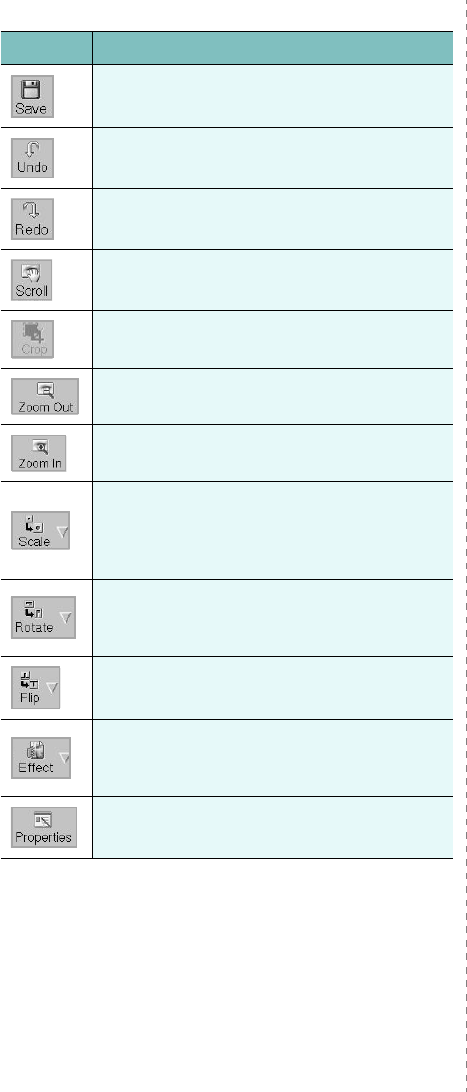
Using Your Printer in Linux
37
You can use the following tools to edit the image:
For further details about the Image Manager application, refer
to the onscreen help.
Tools Function
Saves the image.
Cancels your last action.
Restores the action you canceled.
Allows you to scroll through the image.
Crops the selected image area.
Zooms the image out.
Zooms the image in.
Allows you to scale the image size; you can
enter the size manually, or set the rate to
scale proportionally, vertically, or
horizontally.
Allows you to rotate the image; you can
select the number of degrees from the drop-
down list.
Allows you to flip the image vertically or
horizontally.
Allows you to adjust the brightness or
contrast of the image, or to invert the
image.
Shows the properties of the image.
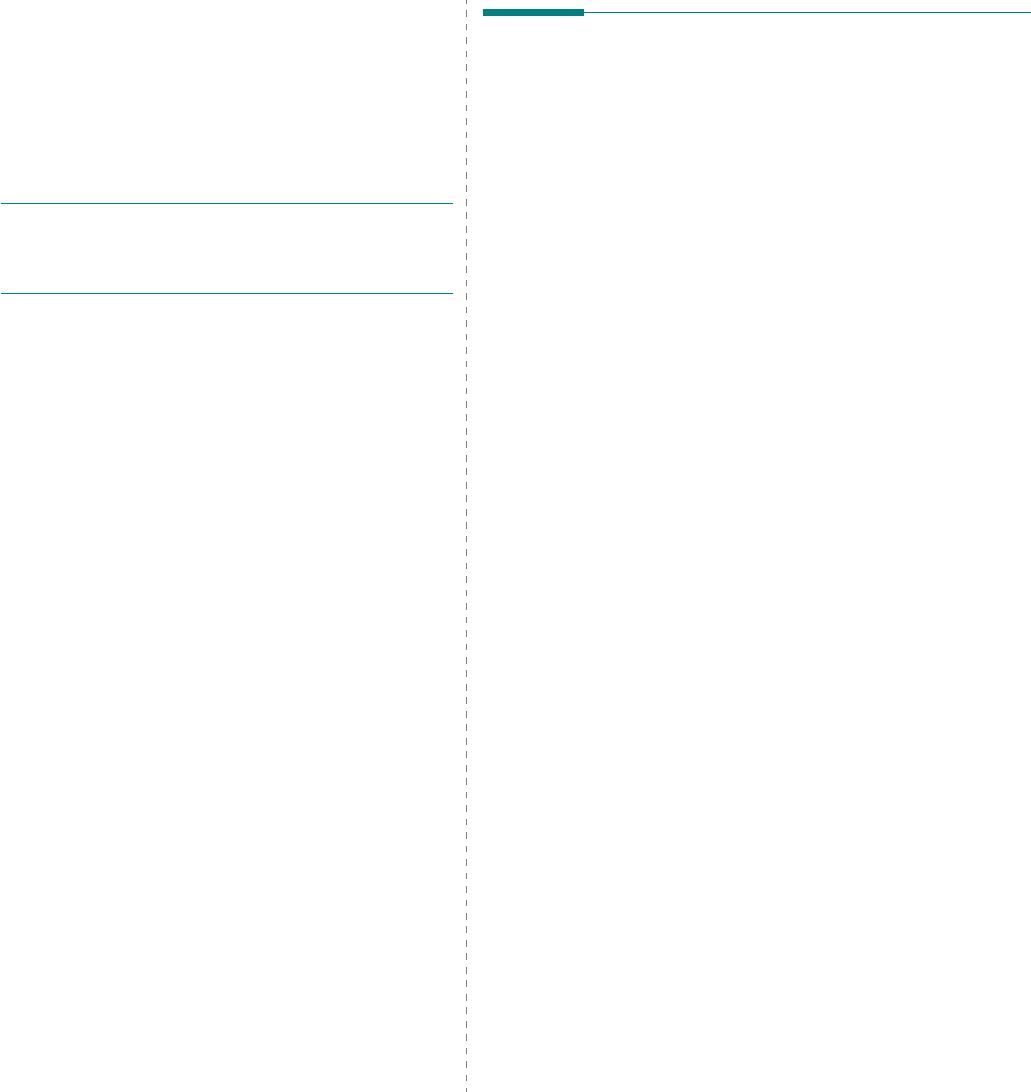
Using Your Printer with a Macintosh
38
9
Using Your Printer with
a Macintosh
Your machine supports Macintosh systems with a built-in USB
interface or a 10/100 Base-TX network interface card. When
you print a file from a Macintosh computer, you can use the
PostScript driver by installing the PPD file.
N
OTE
:
Some printers do not support a network
interface. Make sure that your printer supports a
network interface by referring to Printer Specifications
in your Printer User’s Guide.
This chapter includes:
• Installing Software for Macintosh
• Setting Up the Printer
•Printing
•Scanning
Installing Software for
Macintosh
The PostScript driver CD-ROM that came with your machine
provides you with the PPD file to use the PS driver, Apple
LaserWriter driver, for printing on a Macintosh computer.
Also, it provides you with the Twain driver for scanning on a
Macintosh computer.
1
Connect your machine to the computer using the USB
cable or the Ethernet cable.
2
Turn on your computer and the machine.
3
Insert the CD-ROM which came with your printer into the
CD-ROM drive.
4
Double-click the
Samsung MFP
on your Macintosh
desktop.
5
Double-click the
MAC_Installer
folder.
6
Double-click the
MAC_Printer
folder.
7
For Mac OS 10.3 or higher, double-click the
Samsung
MFP Installer OSX
icon.
8
Click
Continue
.
9
Click
Install
.
10
After the installation is finished, click
Quit
.
Uninstalling the printer driver
1
Insert the CD-ROM which came with your printer into the
CD-ROM drive.
2
Double-click
CD-ROM icon
that appears on your
Macintosh desktop.
3
Double-click the
Samsung MFP
on your Macintosh
desktop.
4
Double-click the
MAC_Installer
folder.
5
Double-click the
MAC_Printer
folder.
6
Double-click the
Samsung MFP Installer OSX
icon.
7
Select
Uninstall
from the Installation Type and then Click
Uninstall
.
8
Click
Continue
.
9
When the uninstallation is done, click
Quit
.

Using Your Printer with a Macintosh
39
Install the Scan driver
1
Make sure that you connect your printer to the computer.
Turn on your computer and printer.
2
Insert the CD-ROM which came with your printer into the
CD-ROM drive.
3
Double-click
CD-ROM icon
that appears on your
Macintosh desktop.
4
Double-click the
MAC_Installer
folder.
5
Double-click the
MAC_Twain
folder.
6
Double-click the
Samsung ScanThru Installer
icon.
7
Enter the password and click
OK
.
8
Click
Continue
.
9
Click
Install
.
10
Click
Continue
.
11
After the installation is finished, click
Quit
.
Uninstalling the Scan driver
1
Insert the CD-ROM which came with your printer into the
CD-ROM drive.
2
Double-click
CD-ROM icon
that appears on your
Macintosh desktop.
3
Double-click the
MAC_Installer
folder.
4
Double-click the
MAC_Twain
folder.
5
Double-click the
Samsung ScanThru Installer
icon.
6
Enter the password and click
OK
.
7
Click
Continue
.
8
Select
Uninstall
from the Installation Type and then Click
Uninstall
.
9
Click
Continue
.
10
When the uninstallation is done, click
Quit
.
Setting Up the Printer
Set up for your printer will be different depending on which
cable you use to connect the printer to your computer—the
network cable or the USB cable.
For a Network-connected Macintosh
N
OTE
:
Some printers do not support a network
interface. Before connecting your printer, make sure
that your printer supports a network interface by
referring to Printer Specifications in your Printer User’s
Guide.
1
Follow the instructions on “Installing Software for
Macintosh” on page 38 to install the PPD file on your
computer.
2
Open
Print Center
or
Printer Setup Utility
from the
Utilities folder.
3
Click
Add
on the Printer List.
4
Select the
AppleTalk
tab.
The name of your machine appears on the list. Select
SEC000xxxxxxxxx
from the printer box, where the
xxxxxxxxx
varies depending on your machine.
5
Click
Add
.
6
If Auto Select does not work properly, select
Samsung
in
Printer Model
and
your printer name
in
Model Name
.
Your machine appears on the Printer List and is set as the
default printer.
For a USB-connected Macintosh
1
Follow the instructions on “Installing Software for
Macintosh” on page 38 to install the PPD file on your
computer.
2
Open
Print Center
or
Printer Setup Utility
from the
Utilities folder.
3
Click
Add
on the Printer List.
4
Select the
USB
tab.
5
Select
your printer name
and click
Add
.
6
If Auto Select does not work properly, select
Samsung
in
Printer Model
and
your printer name
in
Model Name
.
Your machine appears on the Printer List and is set as the
default printer.
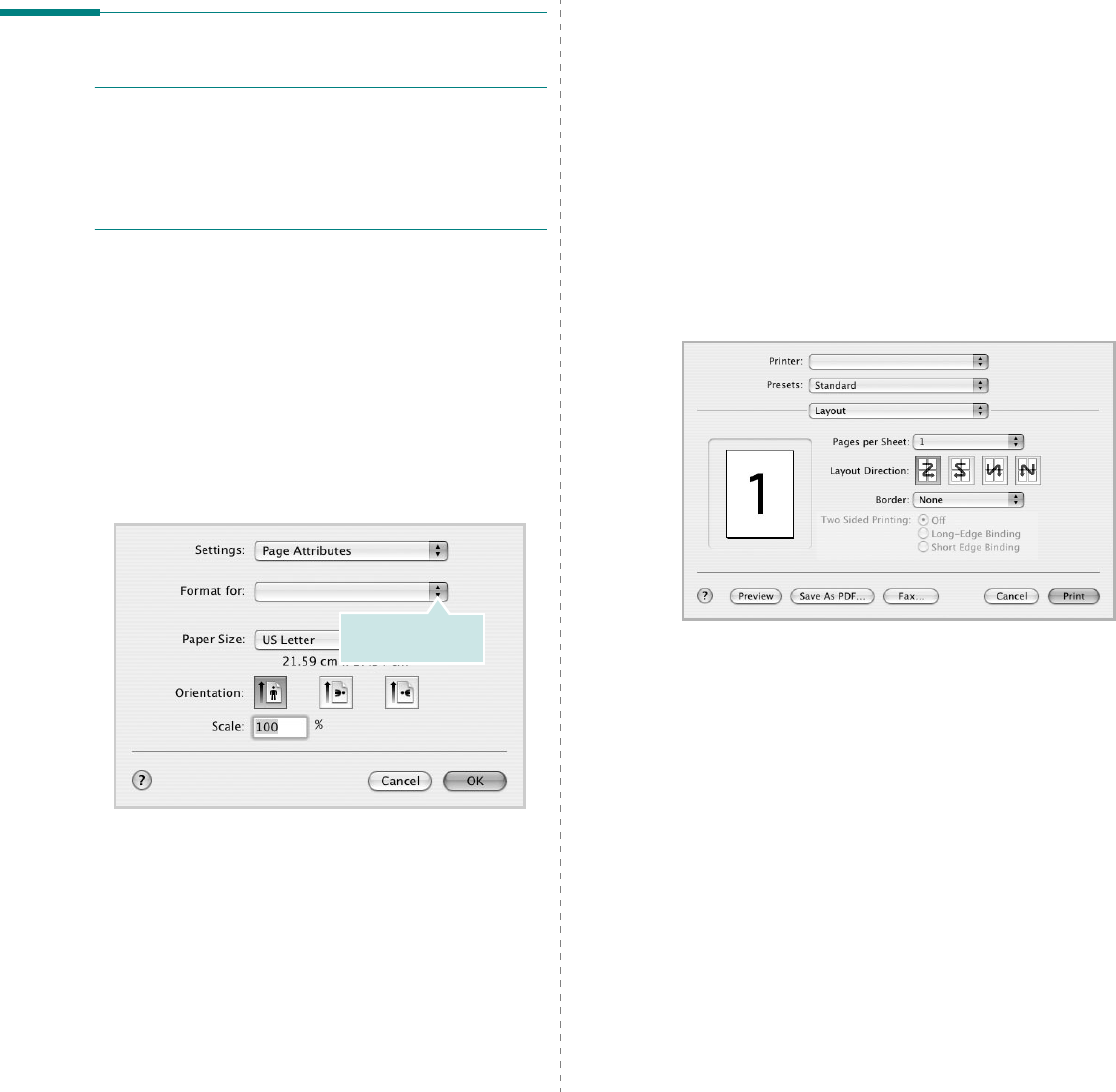
40
Printing
N
OTES
:
• The Macintosh printer’s properties window that appears in
this User’s Guide may differ depending on the printer in use.
However the composition of the printer properties window is
similar.
• You can check your printer name in the supplied CD-
ROM.
Printing a Document
When you print with a Macintosh, you need to check the printer
software setting in each application you use. Follow these steps
to print from a Macintosh.
1
Open a Macintosh application and select the file you want
to print.
2
Open the
File
menu and click
Page Setup
(
Document
Setup
in some applications).
3
Choose your paper size, orientation, scaling, and other
options and click
OK
.
4
Open the
File
menu and click
Print
.
5
Choose the number of copies you want and indicate which
pages you want to print.
6
Click
Print
when you finish setting the options.
▲
Mac OS 10.3
Make sure that your
printer is selected.
Changing Printer Settings
You can use advanced printing features when using your
printer.
From your Macintosh application, select
Print
from the
File
menu. The printer name which appears in the printer properties
window may differ depending on the printer in use. Except for
the name, the composition of the printer properties window is
similar.
Layout Setting
The
Layout
tab provides options to adjust how the document
appears on the printed page. You can print multiple pages on
one sheet of paper.
Select
Layout
from the
Presets
drop-down list to access the
following features. For details, see “Printing Multiple Pages on
One Sheet of Paper” on the next column.
▲
Mac OS 10.3
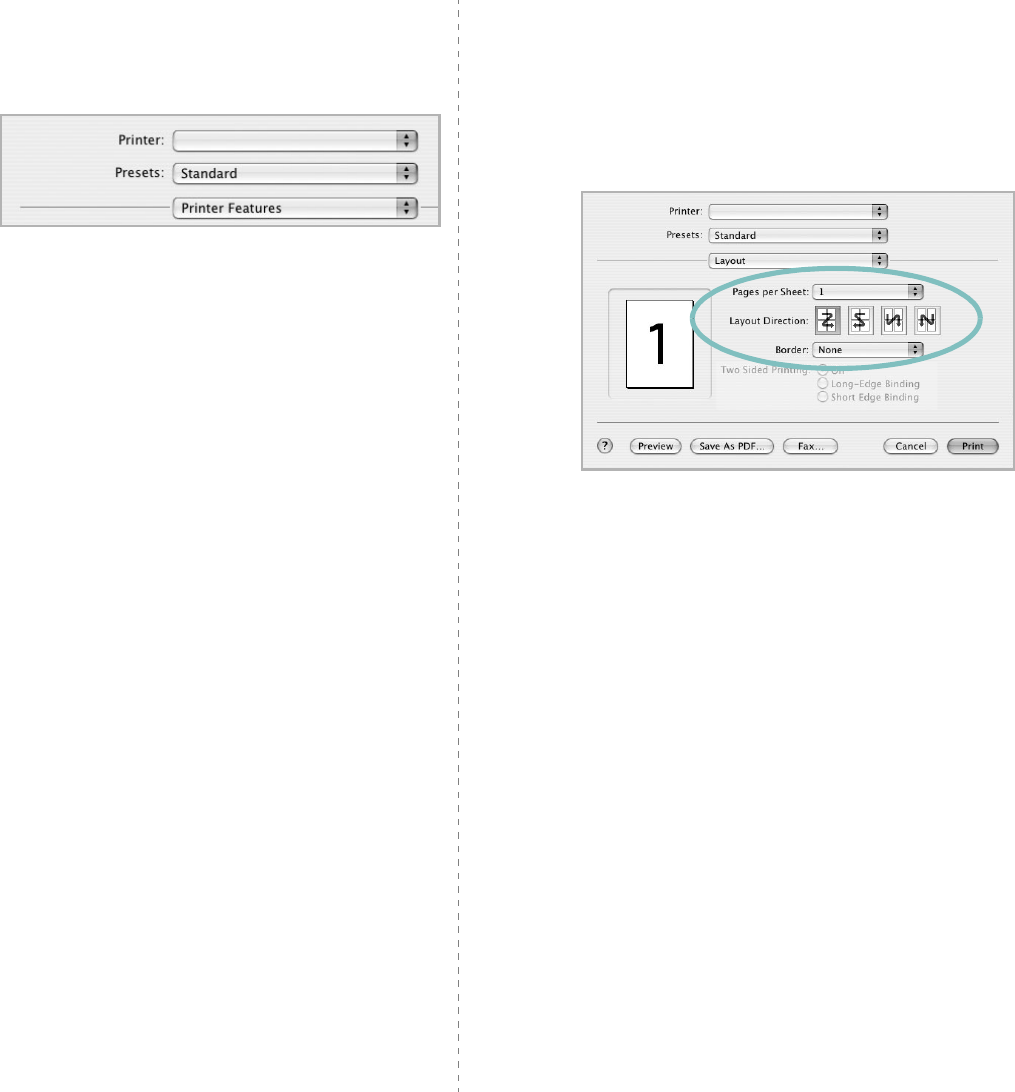
41
Printer Features Setting
The
Printer Features
tab provides options for selecting the
paper type and adjusting print quality.
Select
Printer Features
from the
Presets
drop-down list to
access the following features:
Image Mode
Image Mode allows the user to enhance printouts. The available
options are Normal and Text Enhance.
Fit to Page
This printer feature allows you to scale your print job to any
selected paper size regardless of the digital document size. This
can be useful when you want to check fine details on a small
document.
Paper Type
Set
Type
to correspond to the paper loaded in the tray from
which you want to print. This will let you get the best quality
printout. If you load a different type of print material, select the
corresponding paper type.
Resolution(Quality)
The Resolution options you can select may vary
depending on your printer model.
You can select the
printing resolution. The higher the setting, the sharper the clarity
of printed characters and graphics. The higher setting also may
increase the time it takes to print a document.
▲
Mac OS 10.3
Printing Multiple Pages on One Sheet
of Paper
You can print more than one page on a single sheet of paper.
This feature provides a cost-effective way to print draft pages.
1
From your Macintosh application, select
Print
from the
File
menu.
2
Select
Layout
.
3
Select the number of pages you want to print on one sheet
of paper on the
Pages per Sheet
drop-down list.
4
Select the page order from the
Layout Direction
option.
To print a border around each page on the sheet, select
the option you want from the
Border
drop-down list.
5
Click
Print
, and the printer prints the selected number of
pages on one side of each page.
▲
Mac OS 10.3

42
Duplex Printing
You can print on both sides of the paper. Before printing in the
duplex mode, decide on which edge you will be binding your
finished document. The binding options are:
Long-Edge Binding
: Which is the conventional layout
used in book binding.
Short-Edge Binding
: Which is the type often used with
calendars.
1
From your Macintosh application, select
Print
from the
File
menu.
2
Select the
Layout
.
3
Select a binding orientation from
Two Sided Printing
option.
4
Click
Print
and the printer prints on both sides of the
paper.
C
AUTION
:
If you have selected duplex printing and
then try to print multiple copies of a document, the
printer may not print the document in the way you
want. In case of "Collated copy" , if your document has
odd pages, the last page of the first copy and the first
page of the next copy will be printed on the front and
back of one sheet. In case of "Uncollated copy", the
same page will be printed on the front and back of one
sheet. Therefore, if you need multiple copies of a
document and you want those copies on both sides of
the paper, you must print them one at a time, as
separate print jobs
.
▲
Mac OS 10.3
Scanning
If you want to scan documents using other software, you will
need to use TWAIN-compliant software, such as Adobe
PhotoDeluxe or Adobe Photoshop. The first time you scan with
your machine, select it as your TWAIN source in the application
you use.
The basic scanning process involves a number of steps:
• Place your photograph or page on the document glass or
ADF.
• Open an application, such as PhotoDeluxe or Photoshop.
• Open the TWAIN window and set the scan options.
• Scan and save your scanned image.
N
OTE
: You need to follow the program’s instructions for
acquiring an image. Please refer to the User’s Guide of the
application.
43
SOFTWARE SECTION
INDEX
A
advanced printing, use
18
B
booklet printing
19
C
canceling
scan
29
D
document, print
Macintosh
40
Windows
12
double-sided printing
20
E
Extras properties, set
16
F
favorites settings, use
17
G
Graphics properties, set
15
H
help, use
17,23
I
install
printer driver
Macintosh
38
Windows
4
installing
Linux software
30
L
Layout properties, set
Macintosh
40
Windows
13
Linux
driver, install
30
printer properties
34
printing
34
scanning
35
M
Macintosh
driver
install
38
printing
40
scanning
42
setting up the printer
39
MFP driver, install
Linux
30
N
n-up printing
Macintosh
41
Windows
18
O
orientation, print
35
Windows
13
overlay
create
22
delete
22
print
22
P
Paper properties, set
14
paper size, set
14
print
35
paper source, set
35
Windows
14
paper type, set
Macintosh
41
print
35
poster, print
19
PostScript driver
installing
23
print
document
12
fit to page
20
from Macintosh
40
from Windows
12
N-up
Macintosh
41
Windows
18
overlay
22
poster
21
PRN
12
scaling
20
watermark
21
print resolution
35
printer driver, install
Linux
30
printer properties
Linux
34
printer properties, set
Macintosh
40
Windows
13,23
printer resolution, set
Macintosh
41
Windows
15
printer software
install
Macintosh
38
Windows
4
uninstall
Windows
11
printing
booklets
19
double-sided
20
from Linux
34
R
resolution
printing
35
44
S
scanning
Linux
35
SmarThru
27
TWAIN
29
WIA driver
29
scanning from Macintosh
42
setting
darkness
15
favorites
17
image mode
15
resolution
Macintosh
41
Windows
15
toner save
15
true-type option
15
software
install
Macintosh
38
Windows
4
reinstall
Windows
10
system requirements
Macintosh
38
uninstall
Windows
11
status monitor, use
25
T
toner save, set
15
TWAIN, scan
29
U
uninstall, software
Windows
11
uninstalling
MFP driver
Linux
31
W
watermark
create
21
delete
21
edit
21
print
21
WIA, scan
29